My most current blog entry:
Entries in Doors, Old (40)
Memories of Scotland: Isle of Mull Road Trip
 Saturday, August 12, 2017 at 8:17AM
Saturday, August 12, 2017 at 8:17AM 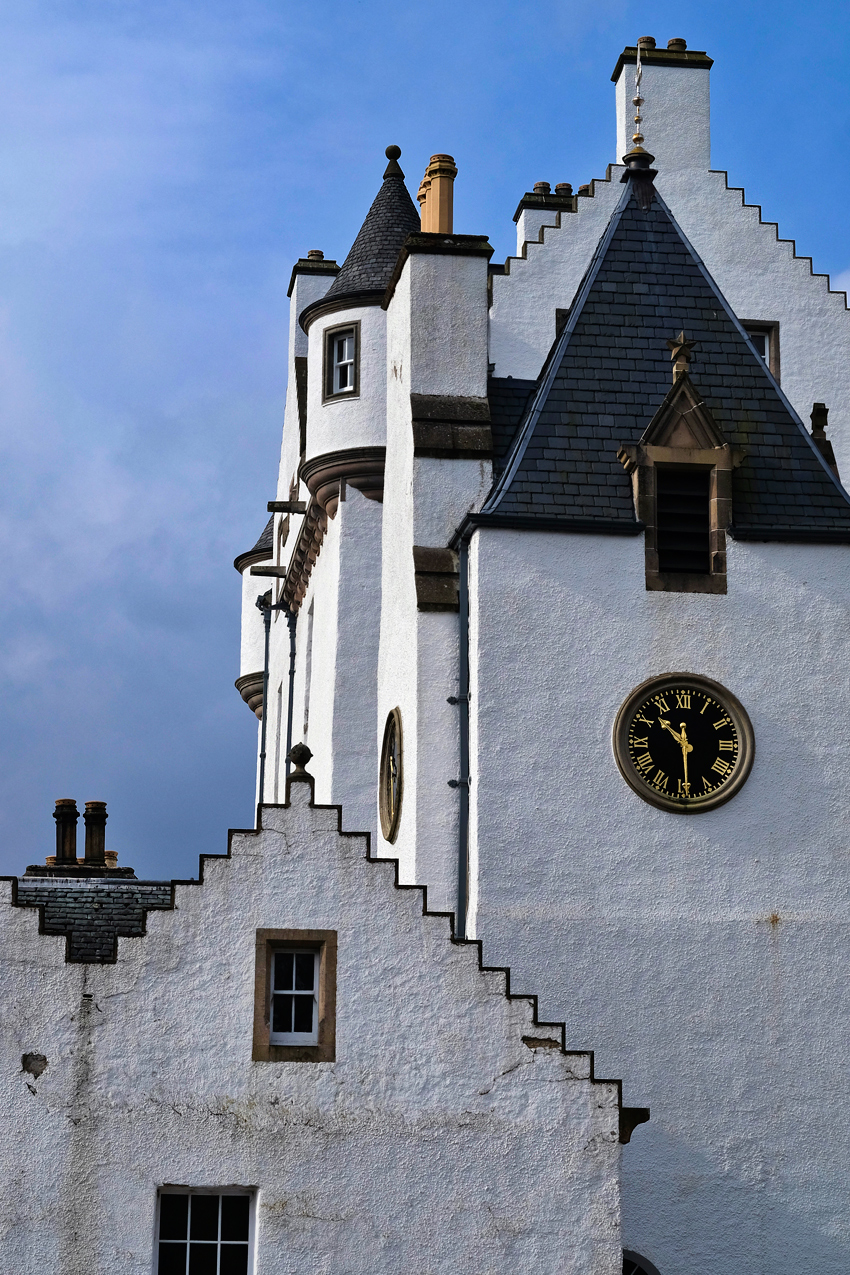 Our trip to the Isle of Mull was, a road trip, and as such, we saw many interesting places on the way there. One such place of interest was not far from where we spent the night, the famous village of Pitlochry . . . Blair Castle.
Our trip to the Isle of Mull was, a road trip, and as such, we saw many interesting places on the way there. One such place of interest was not far from where we spent the night, the famous village of Pitlochry . . . Blair Castle.
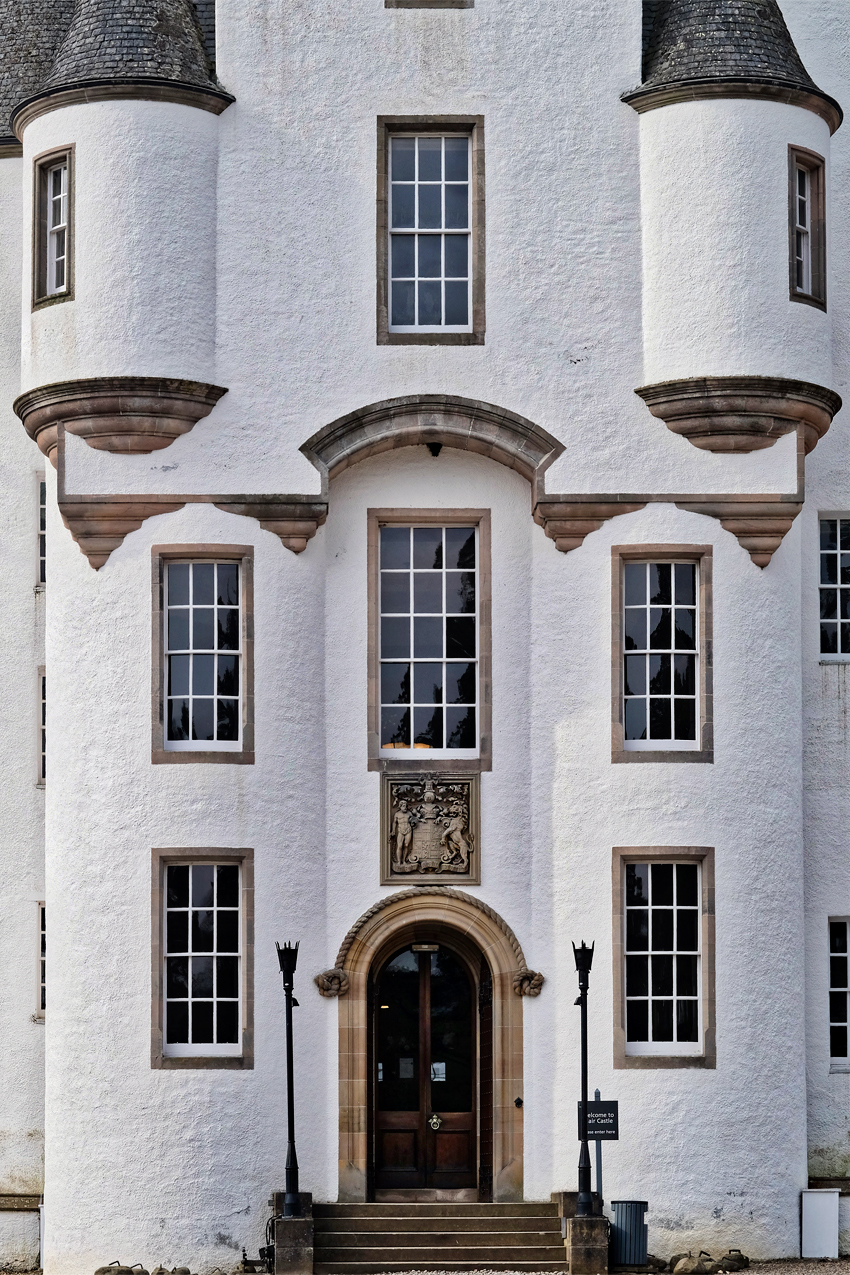 The oldest sections of Blair Castle date from 1269.
The oldest sections of Blair Castle date from 1269.
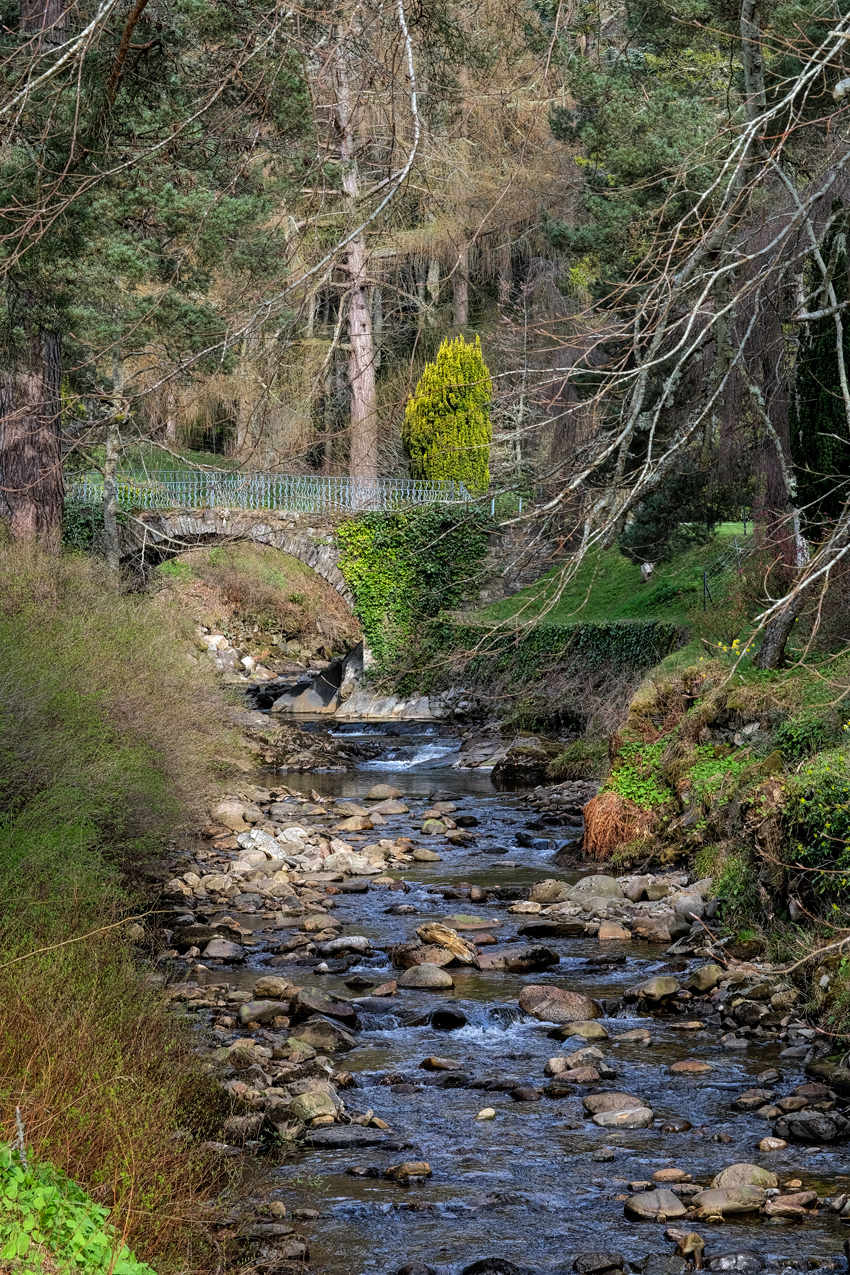 A lovely burn (creek) ran along the side of the castle.
A lovely burn (creek) ran along the side of the castle.
 Like many castles in Scotland, there have been many renovations and much remodeling over the centuries.
Like many castles in Scotland, there have been many renovations and much remodeling over the centuries.
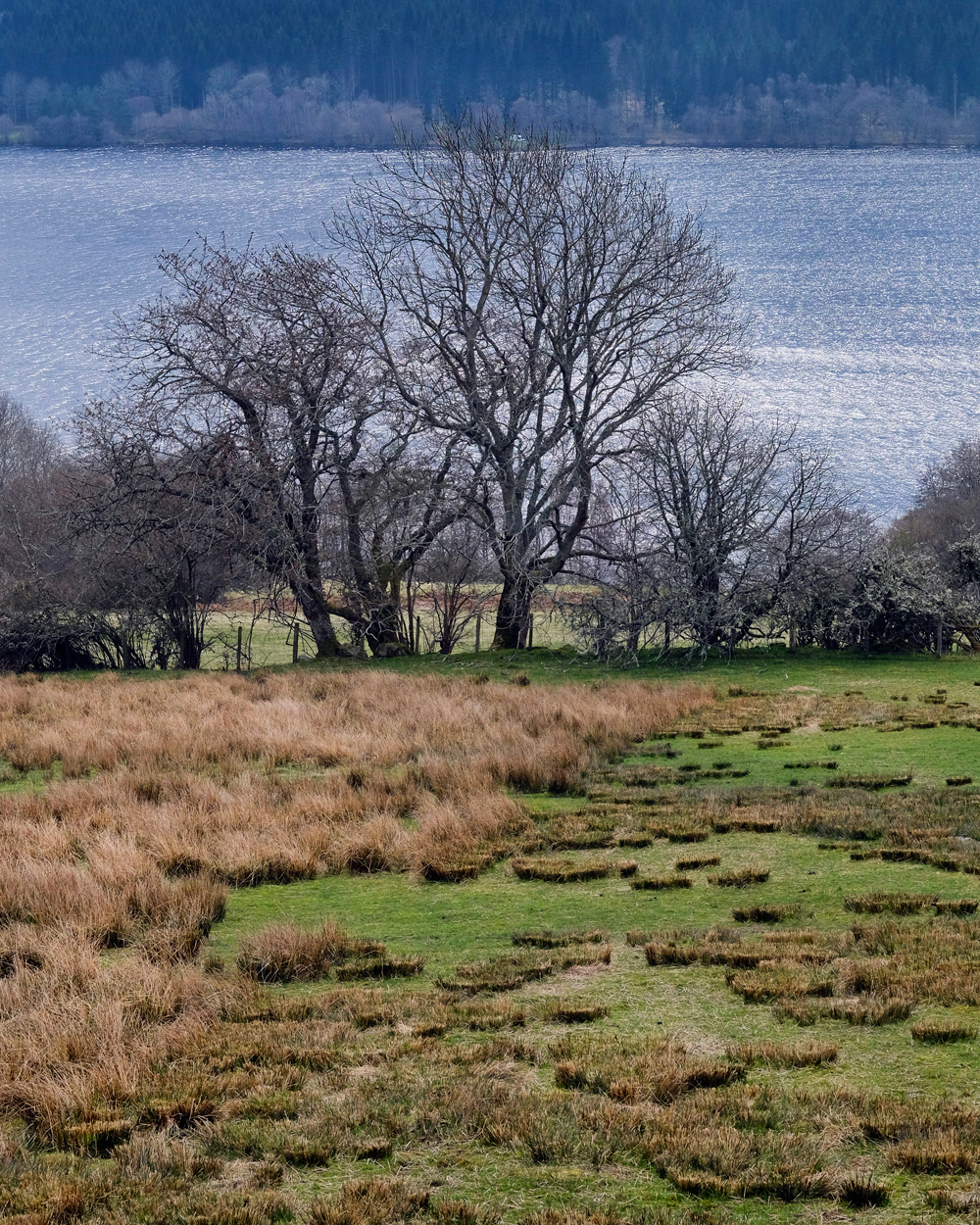 Our route took us along the souther edge of the Highlands, and along Loch Tummel.
Our route took us along the souther edge of the Highlands, and along Loch Tummel.
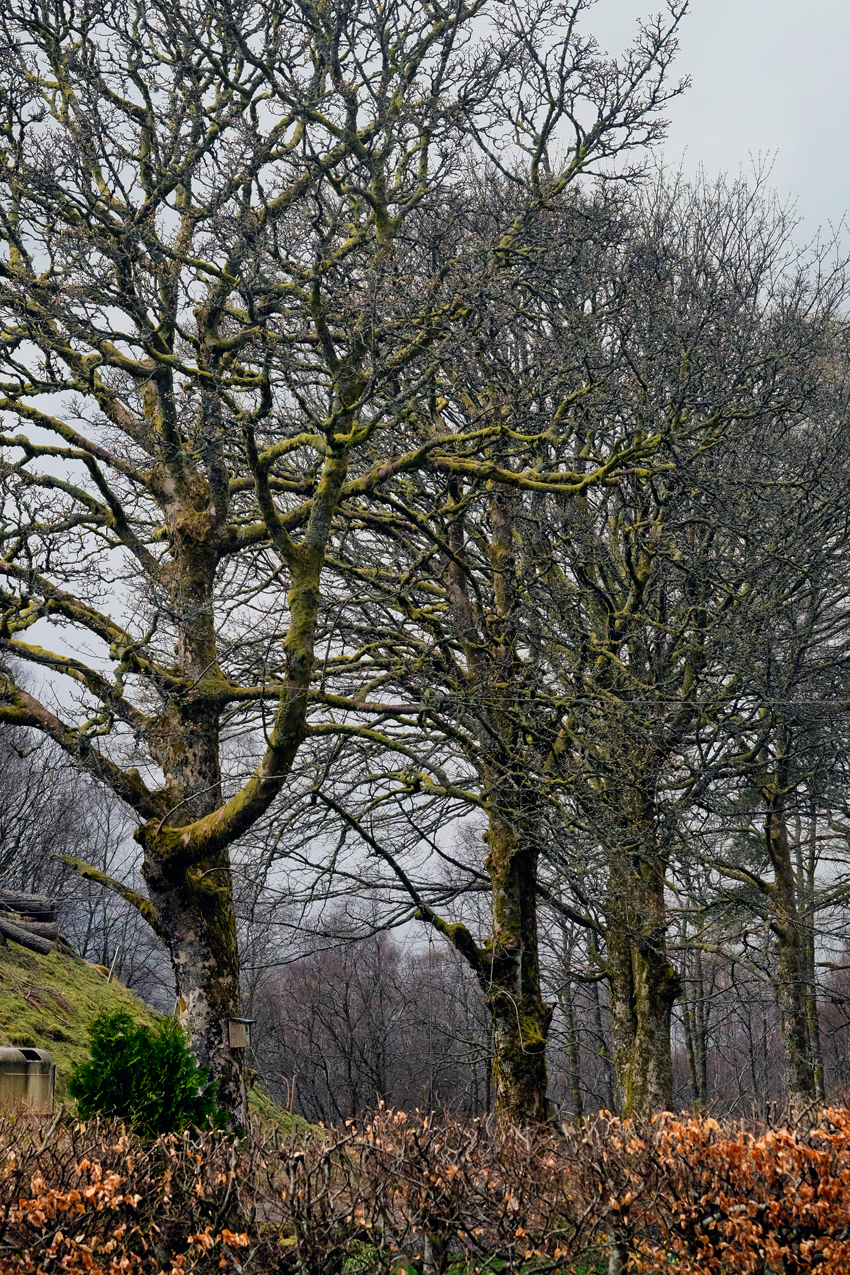 Although it was early April, Spring had not yet reached Scotland.
Although it was early April, Spring had not yet reached Scotland.
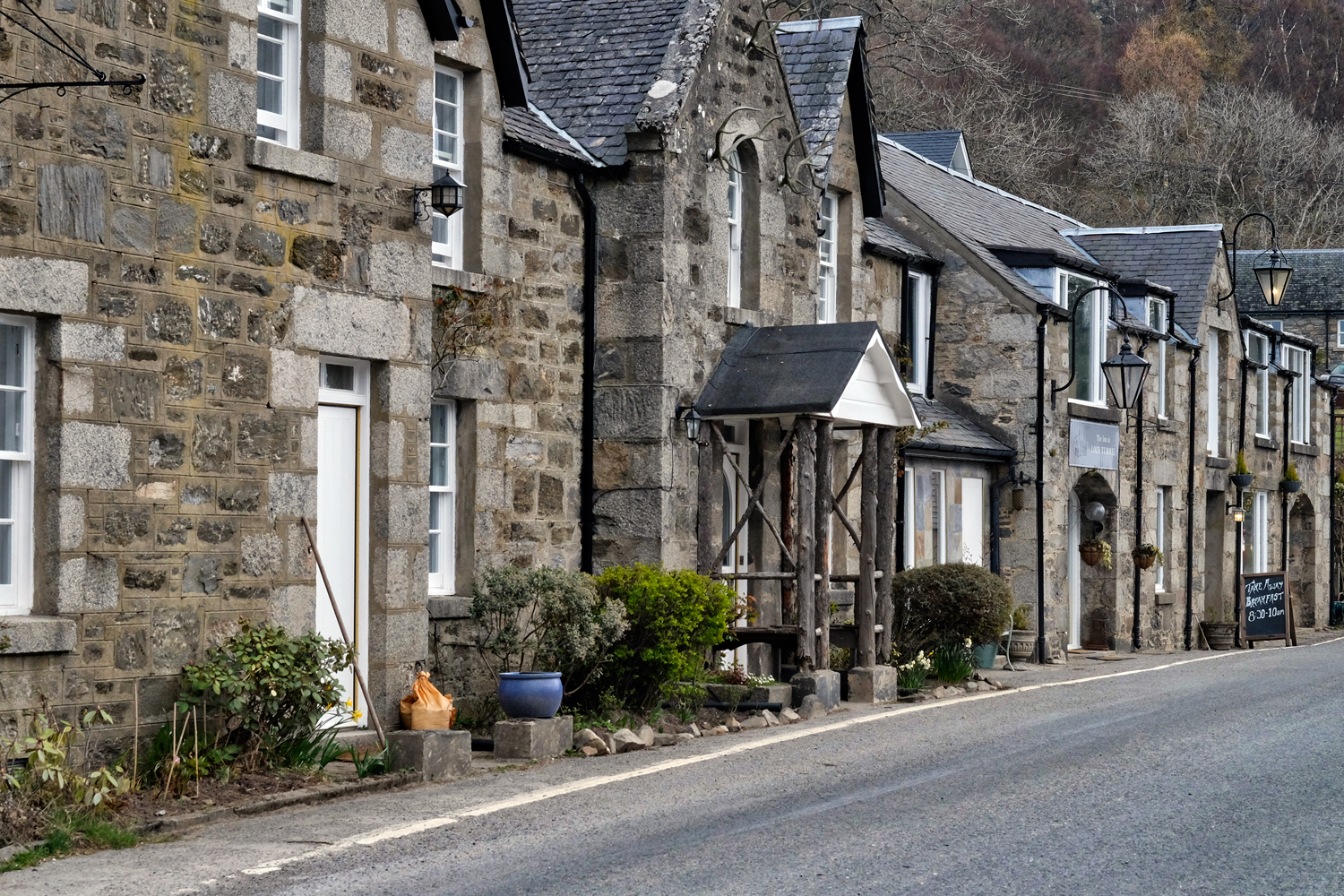 Way out in the countryside, people still built their homes as row houses . . . a statement of the power of the Scottish Lairds as much as anything I guess. Here, along Loch Tummel.
Way out in the countryside, people still built their homes as row houses . . . a statement of the power of the Scottish Lairds as much as anything I guess. Here, along Loch Tummel.
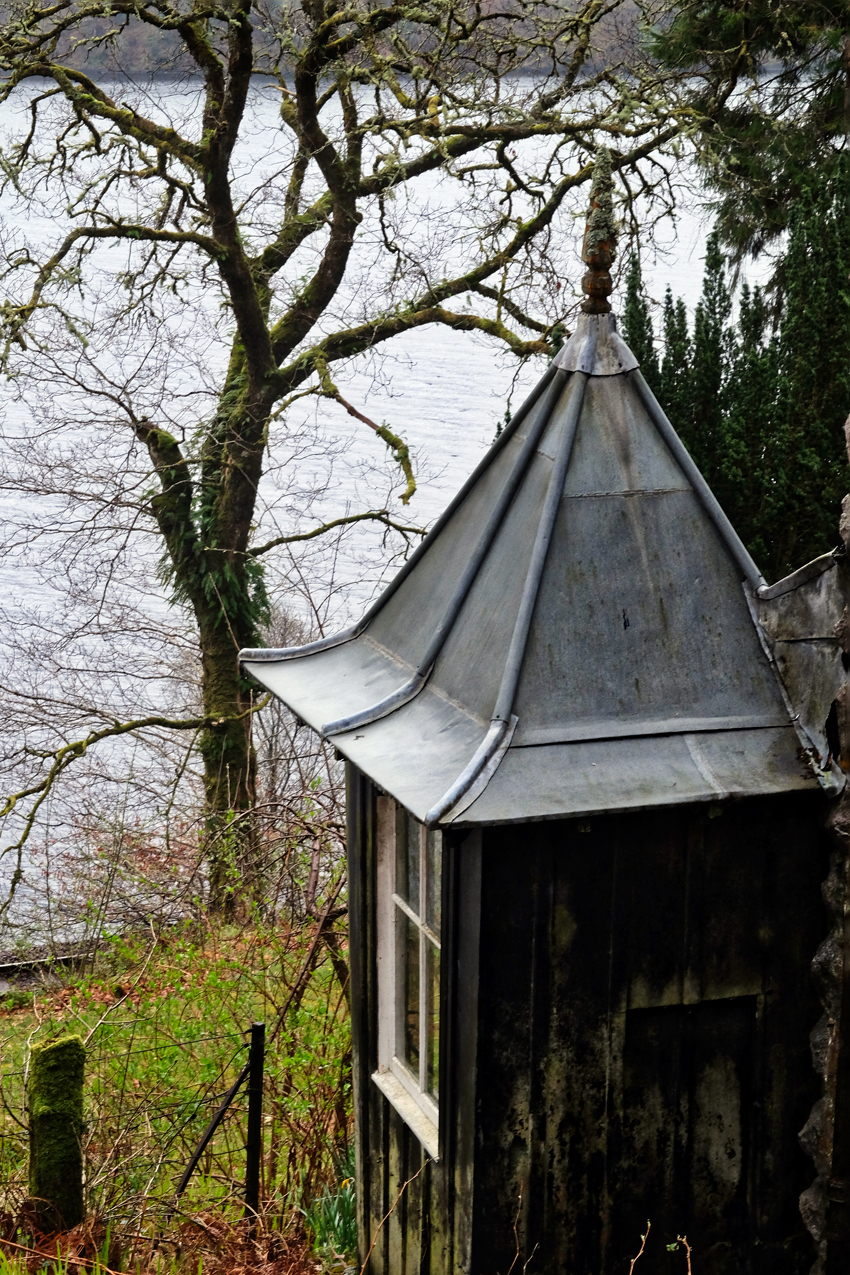 Along the bluff above Loch Awe.
Along the bluff above Loch Awe.
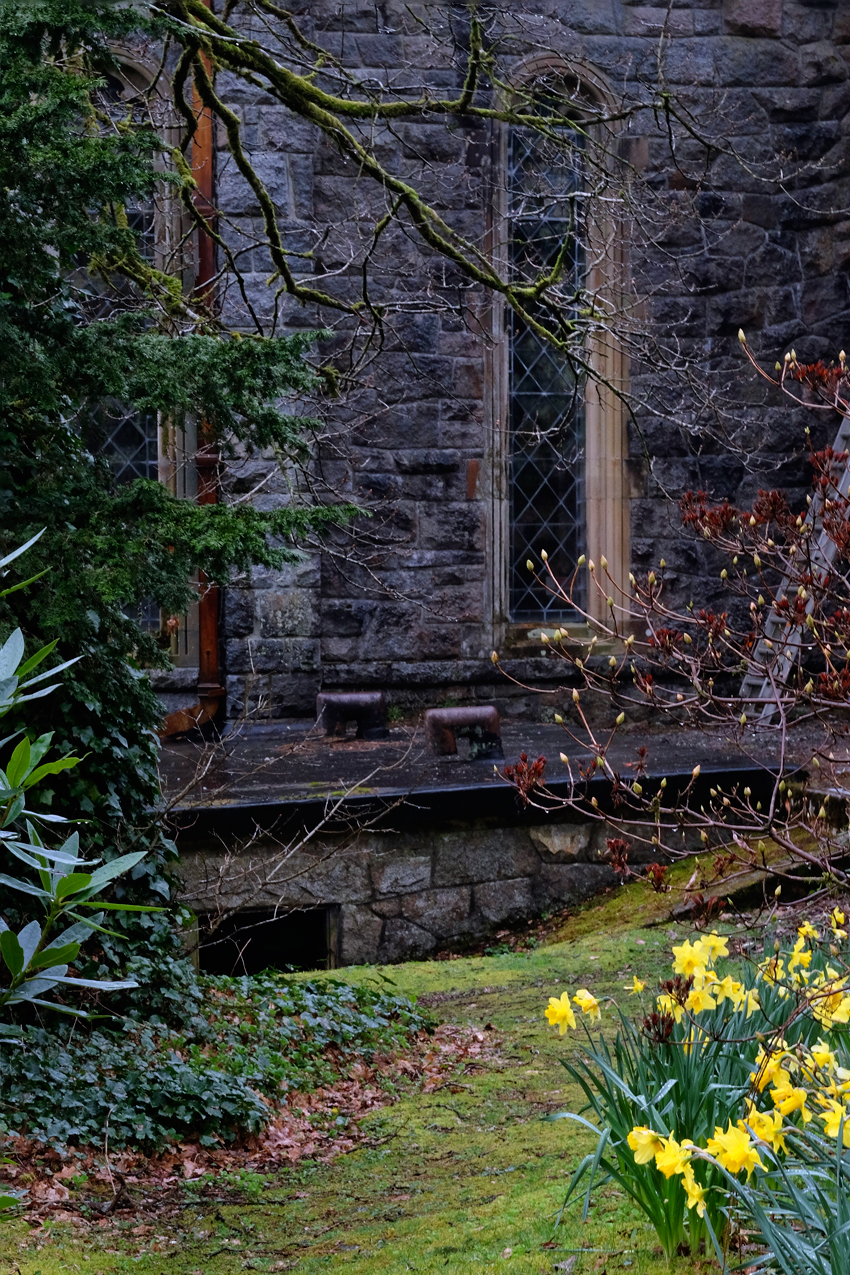 Lovely.
Lovely.
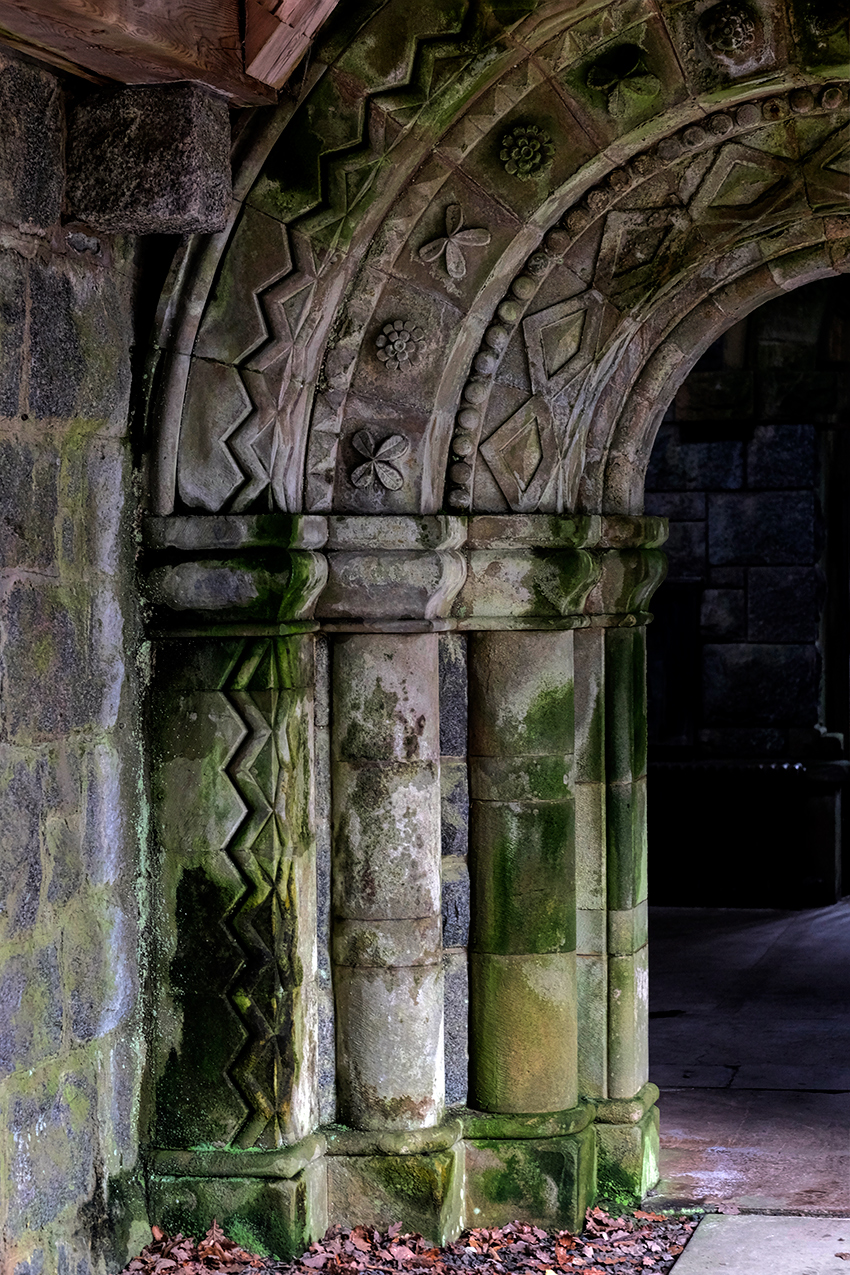 I wanted to take our Thai visitors to a magical place . . .
I wanted to take our Thai visitors to a magical place . . .
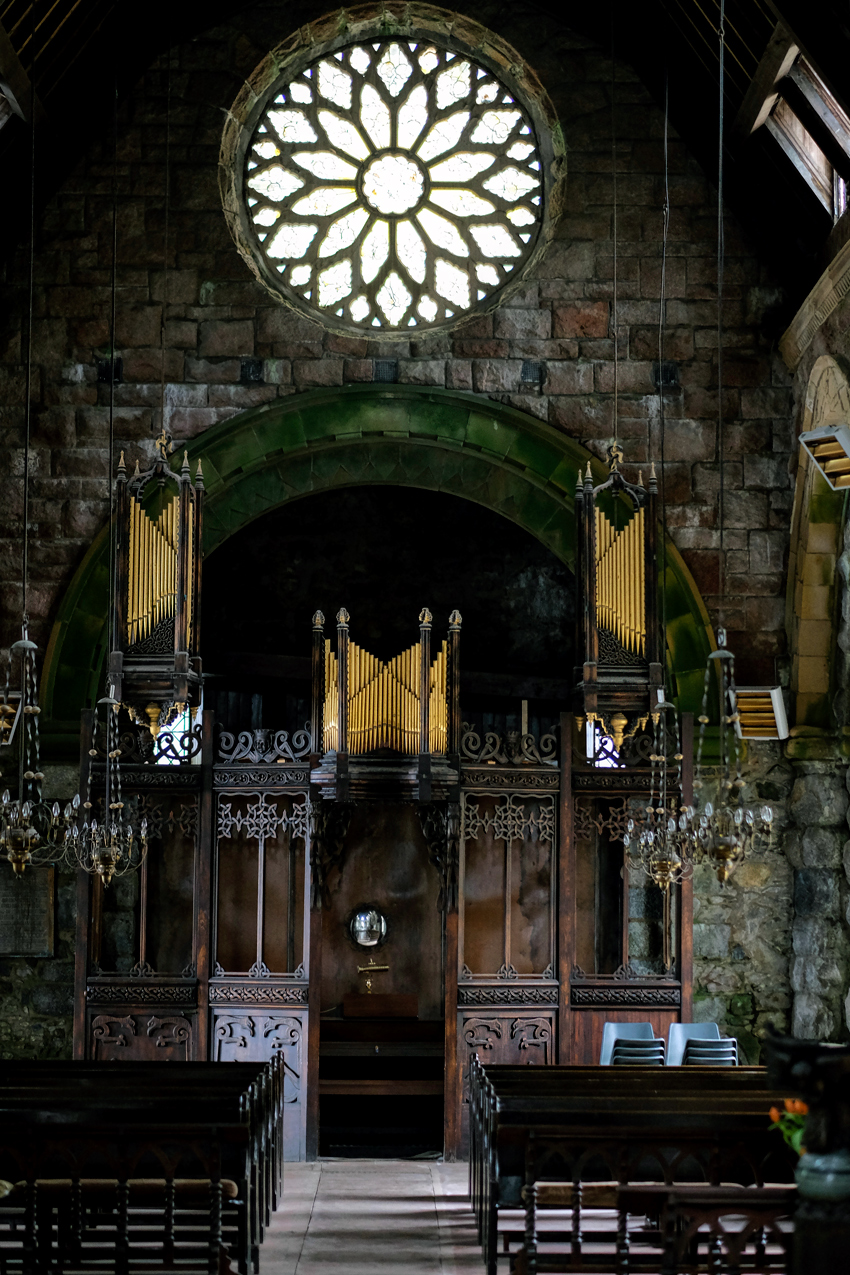 I wanted our visitors to see one of my favorite chapels in Scotland, Saint Conan's Kirke on the shores of Lach Awe.
I wanted our visitors to see one of my favorite chapels in Scotland, Saint Conan's Kirke on the shores of Lach Awe.
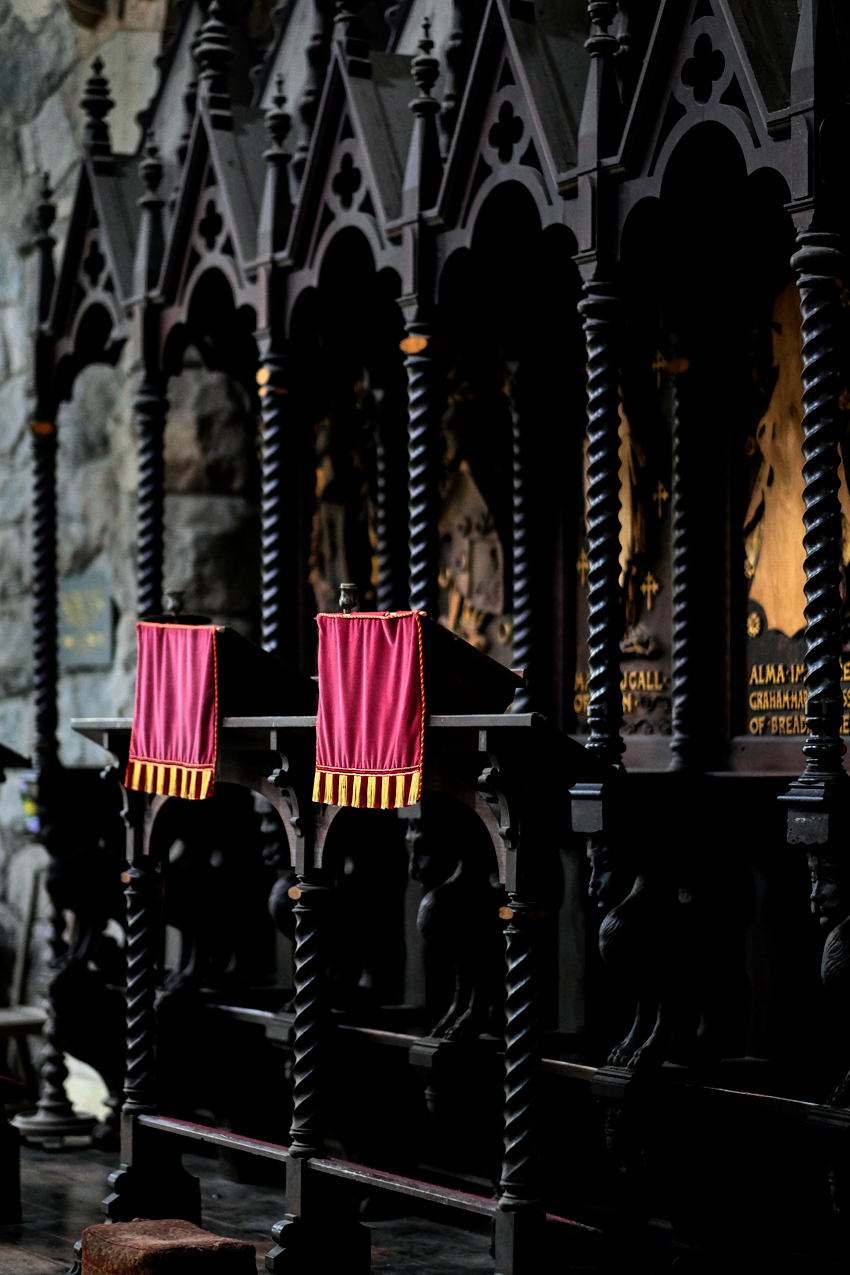 Saint Conan's Kirke is interesting because all the local Clans had a seat of representation in the chapel.
Saint Conan's Kirke is interesting because all the local Clans had a seat of representation in the chapel.
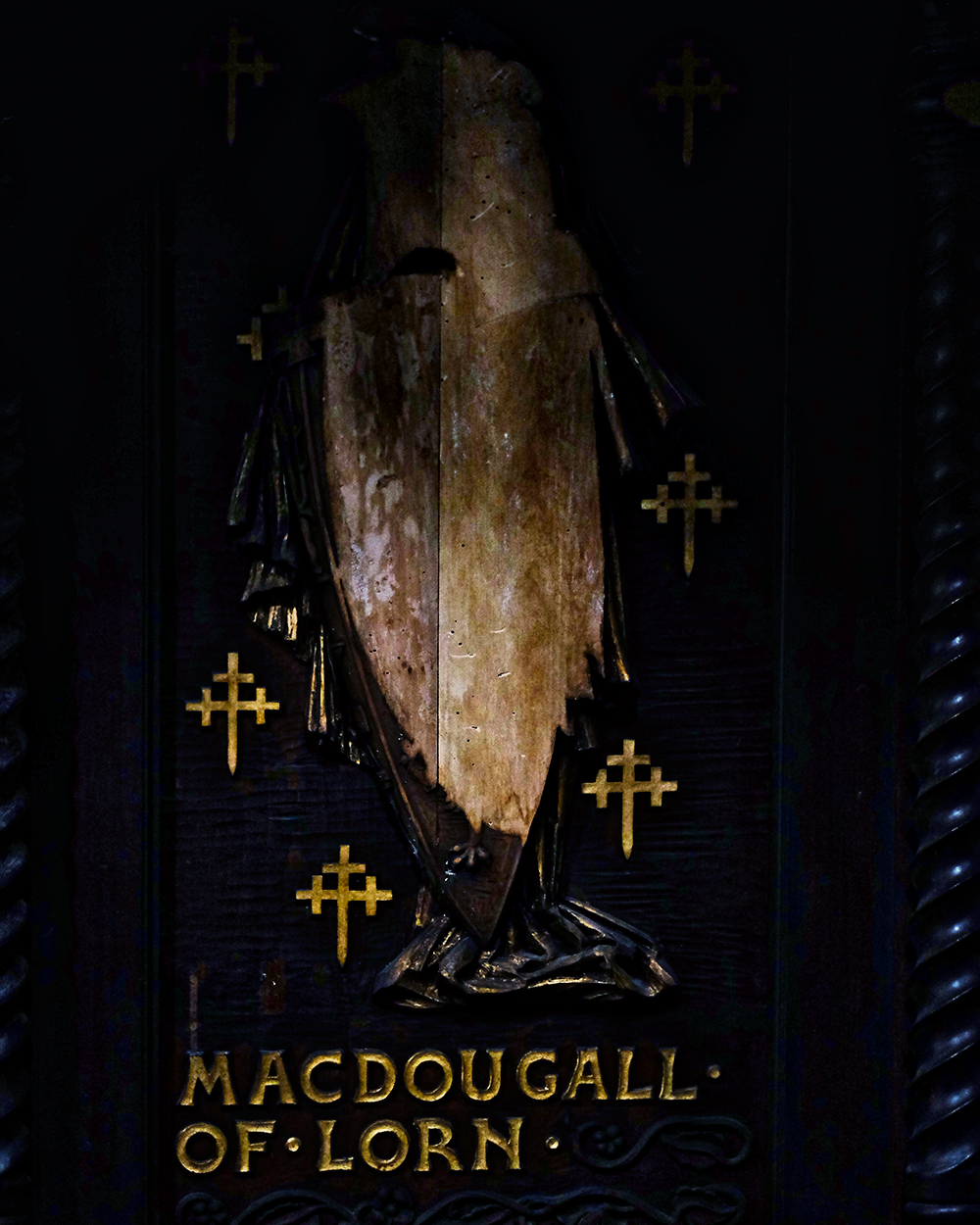 The Clan seats were reserved with their coat of arms. Fascinating cultural artifact.
The Clan seats were reserved with their coat of arms. Fascinating cultural artifact.
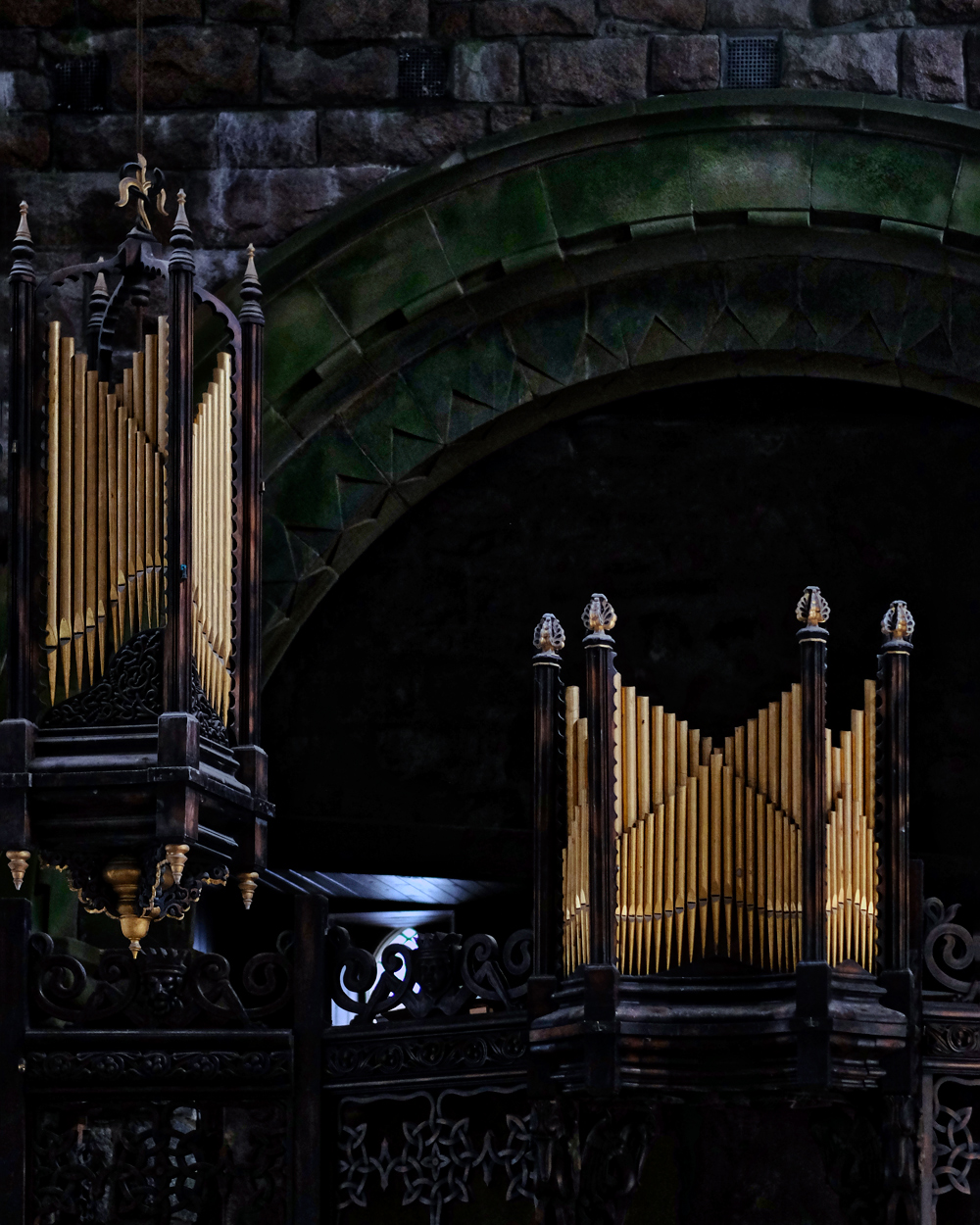 A beautiful pipe organ filled one side of the chapel. I would love to have been there to hear it play.
A beautiful pipe organ filled one side of the chapel. I would love to have been there to hear it play.
 The crypts of nights and clan leaders lined the chapel.
The crypts of nights and clan leaders lined the chapel.
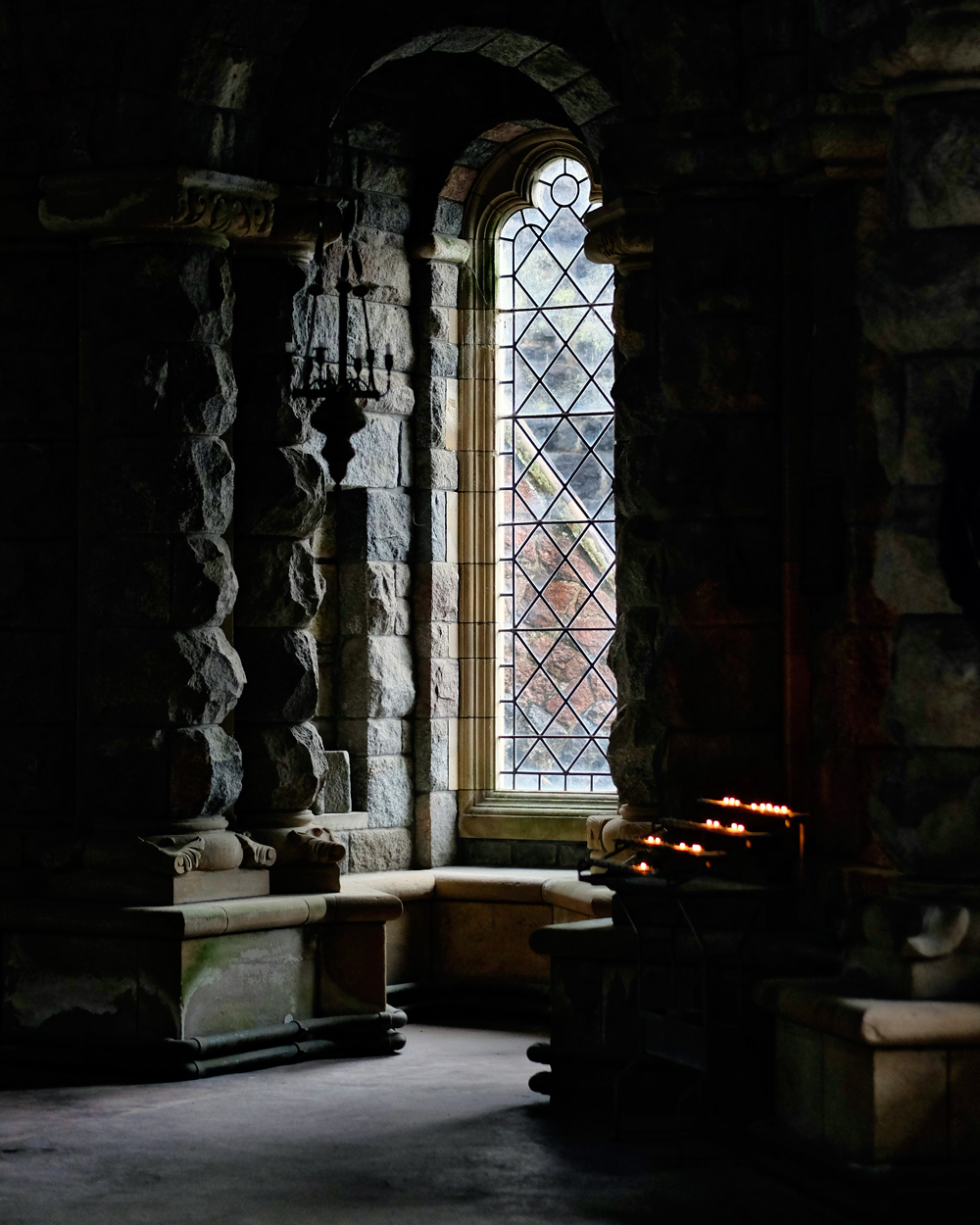 The Saint Conan's Kirke chapel interior with many moods.
The Saint Conan's Kirke chapel interior with many moods.
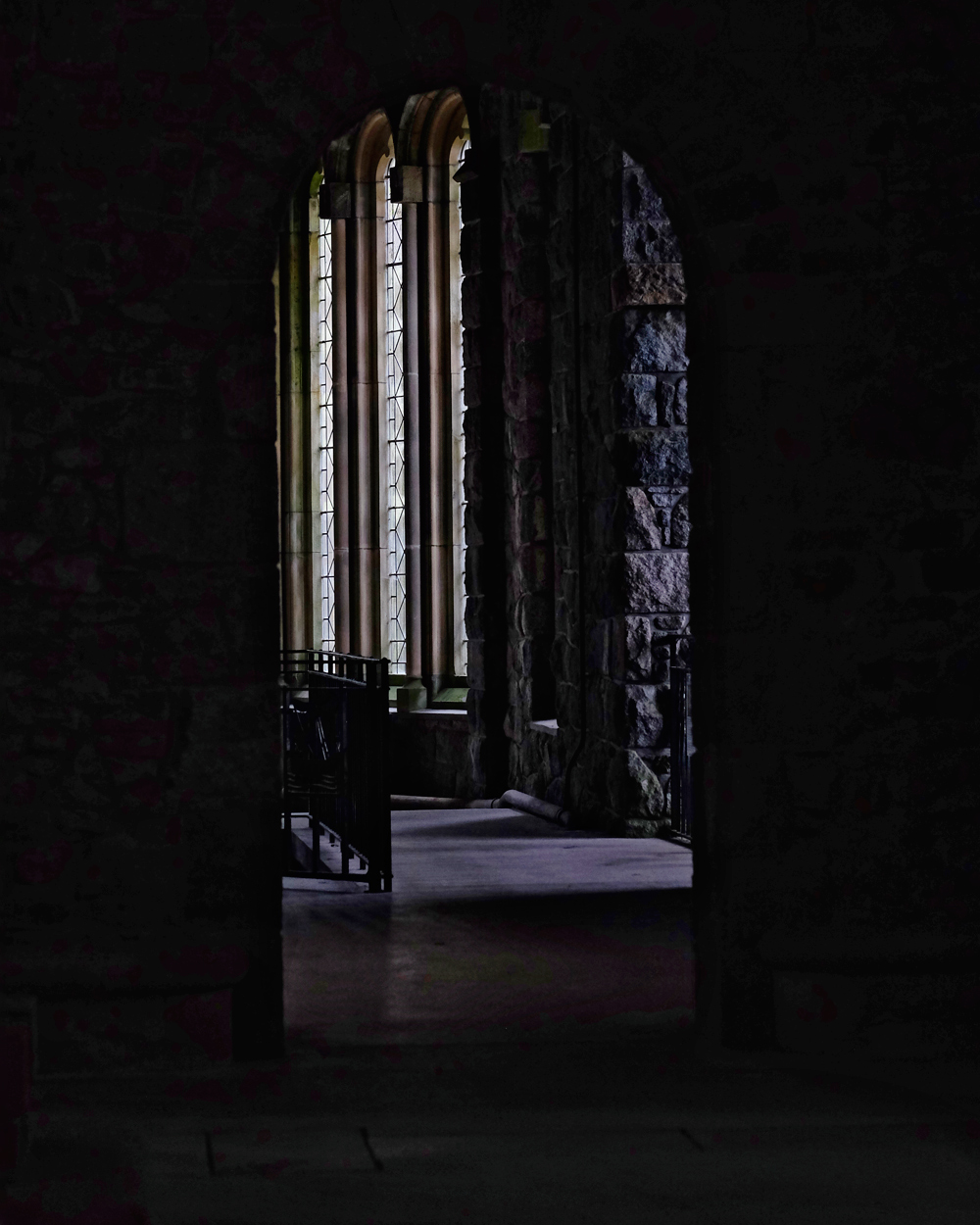 A dark, cloudy day . . .
A dark, cloudy day . . .
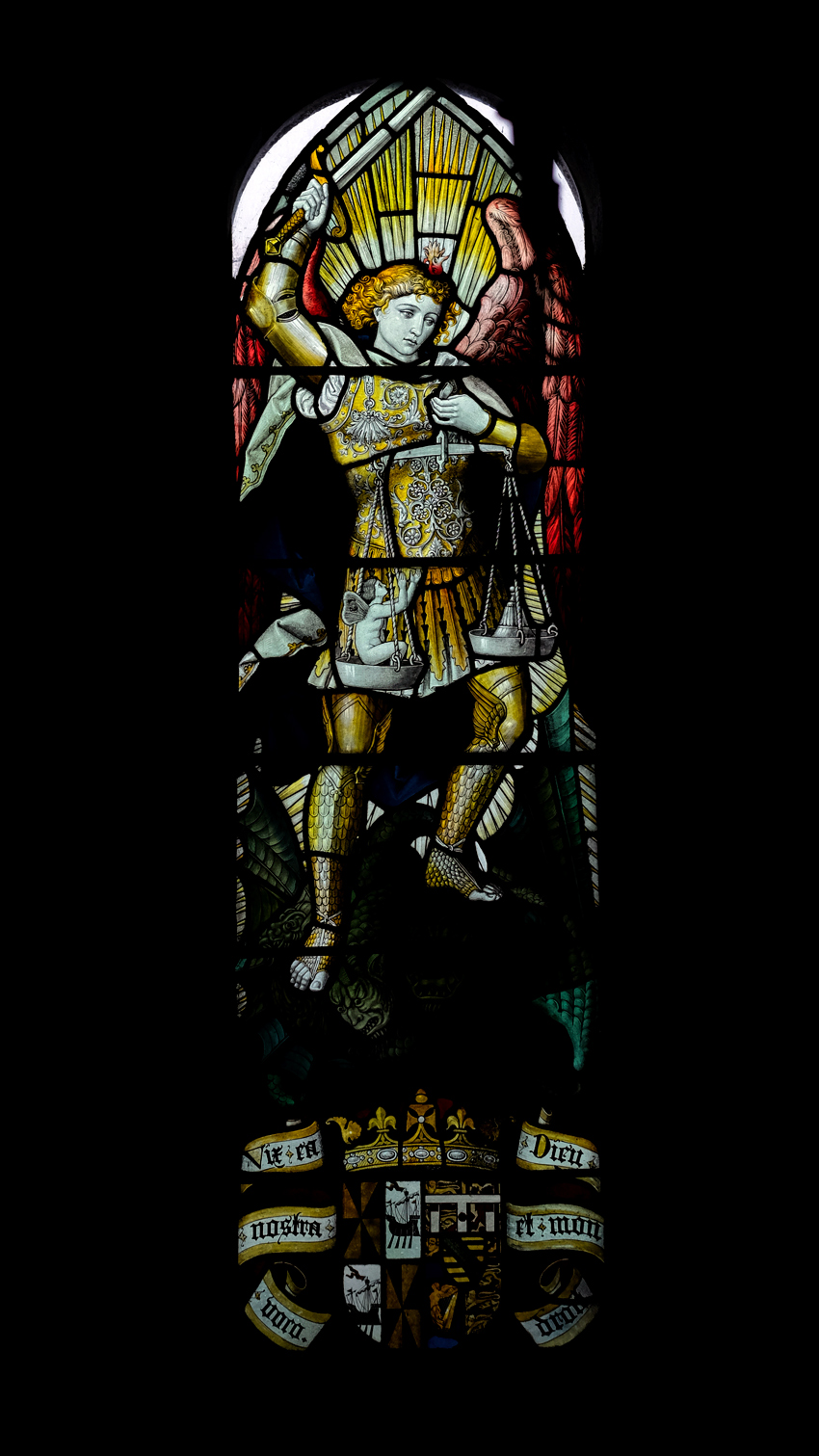 There was some fine stained glass there as well.
There was some fine stained glass there as well.
 A very stylized effect.
A very stylized effect.
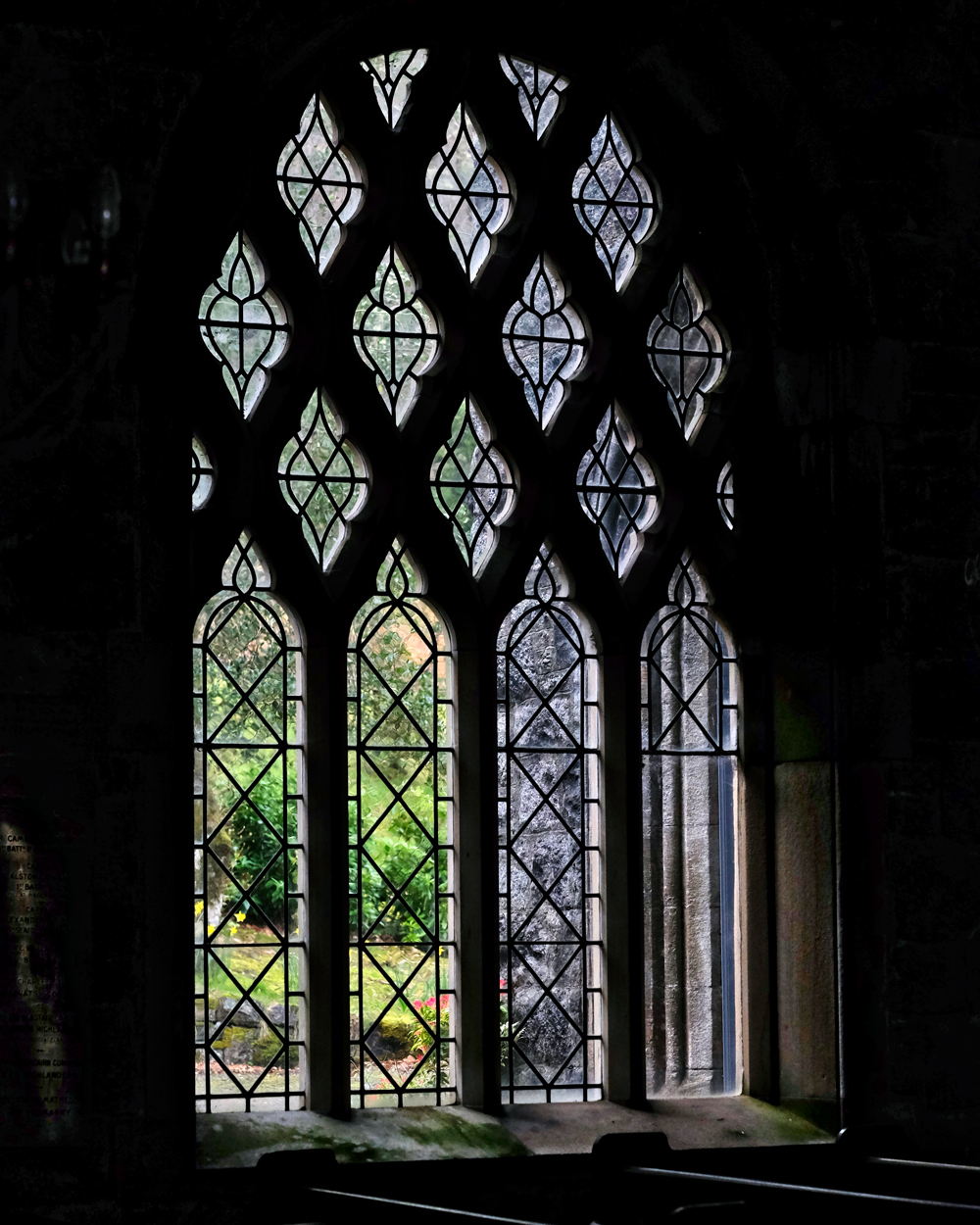 A wonderful window to the world . . .
A wonderful window to the world . . .
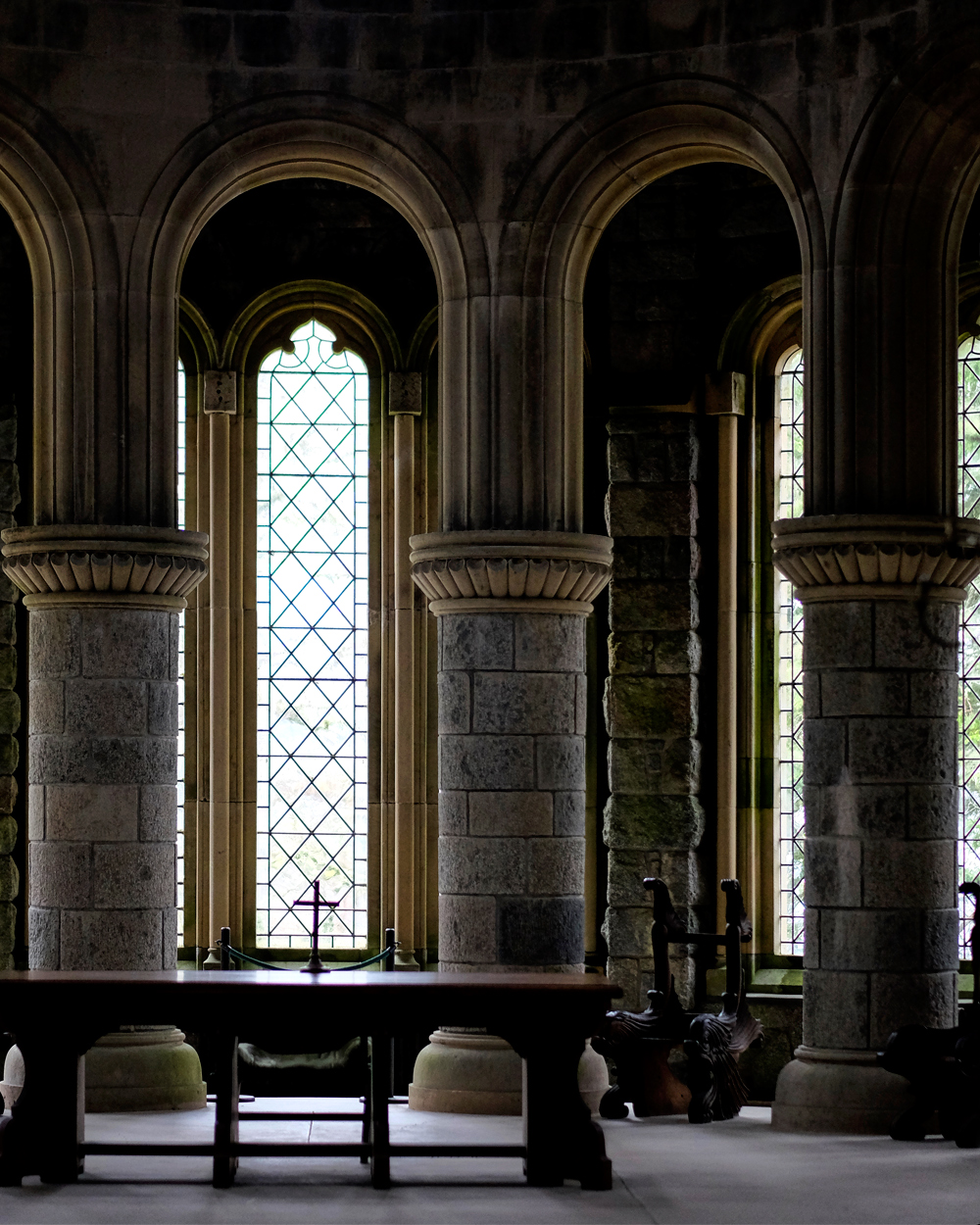 Simple, straightforward furniture.
Simple, straightforward furniture.
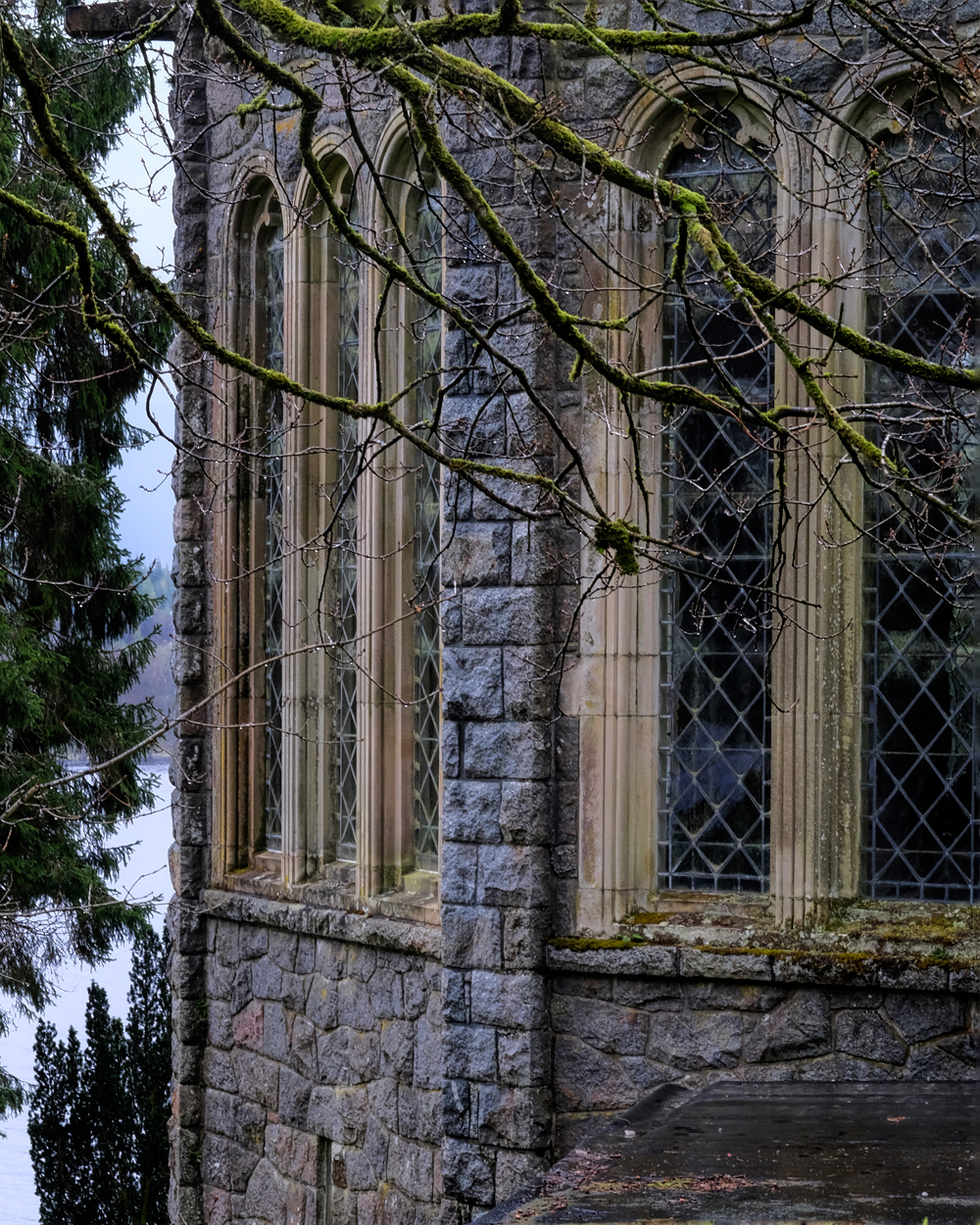 Saint Conan's Kirke.
Saint Conan's Kirke.
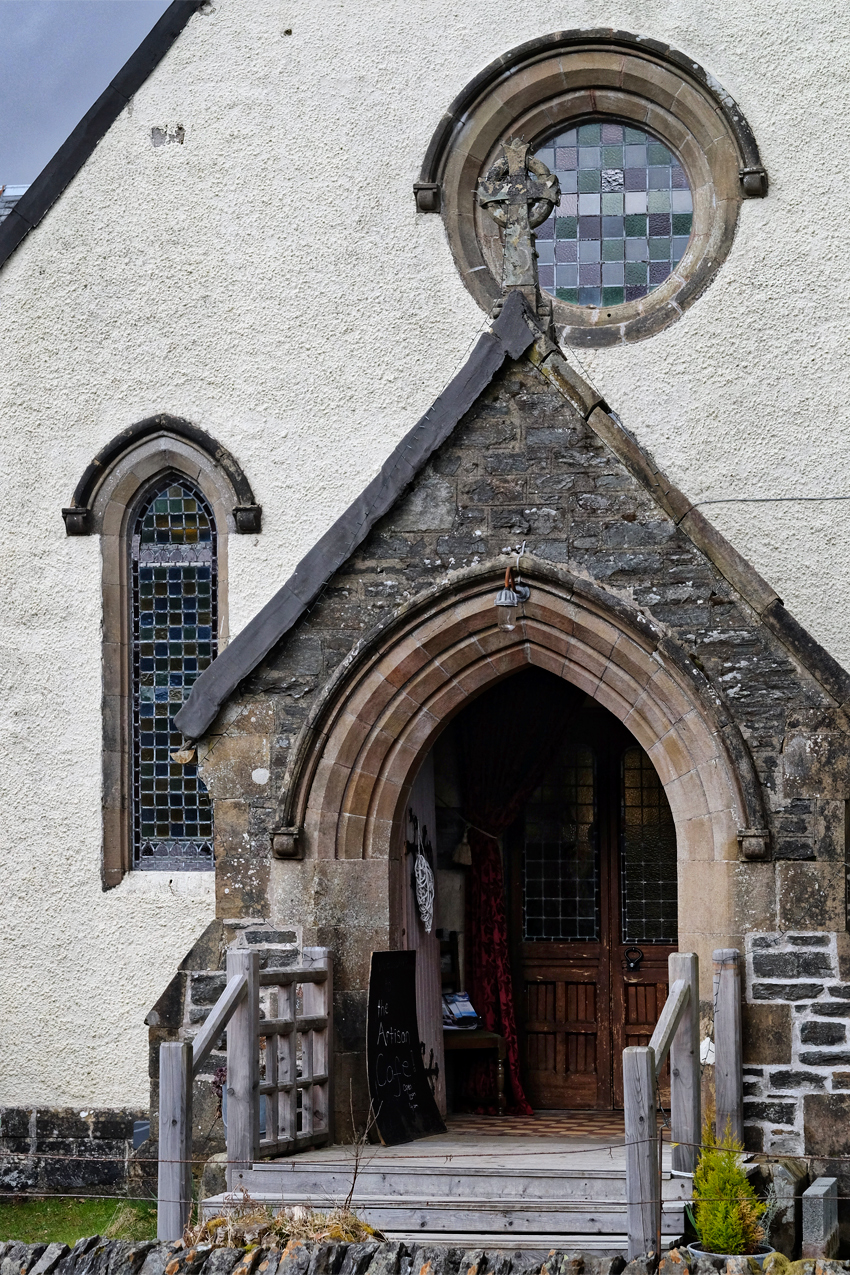 Not all churches are churches. This old rural church has been converted to a cafe . . . we stopped for coffee, tea and, of curse, scones.
Not all churches are churches. This old rural church has been converted to a cafe . . . we stopped for coffee, tea and, of curse, scones.
 The cafe retained many original features of the church.
The cafe retained many original features of the church.
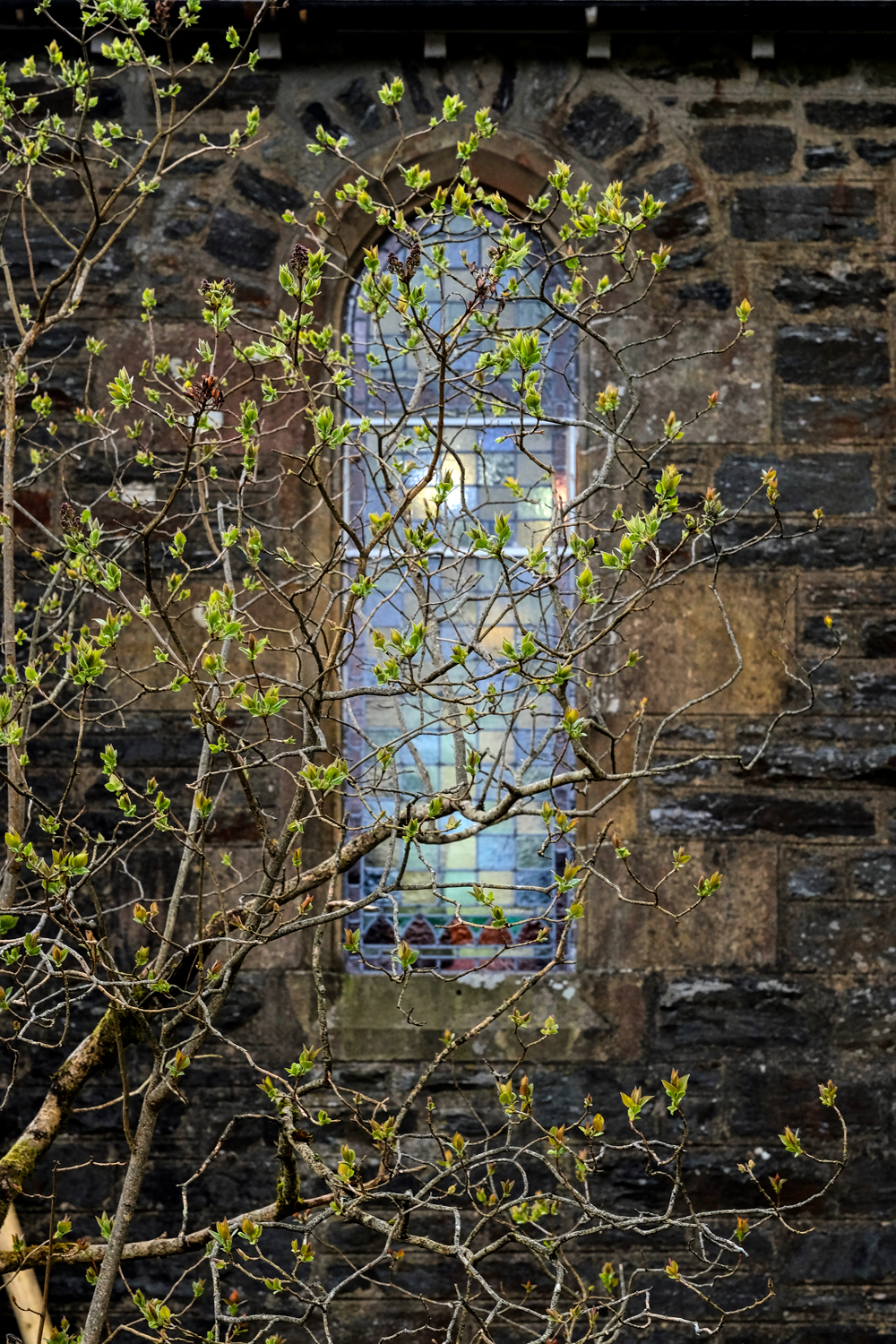 The very beginning of Spring . . . and the first buds.
The very beginning of Spring . . . and the first buds.
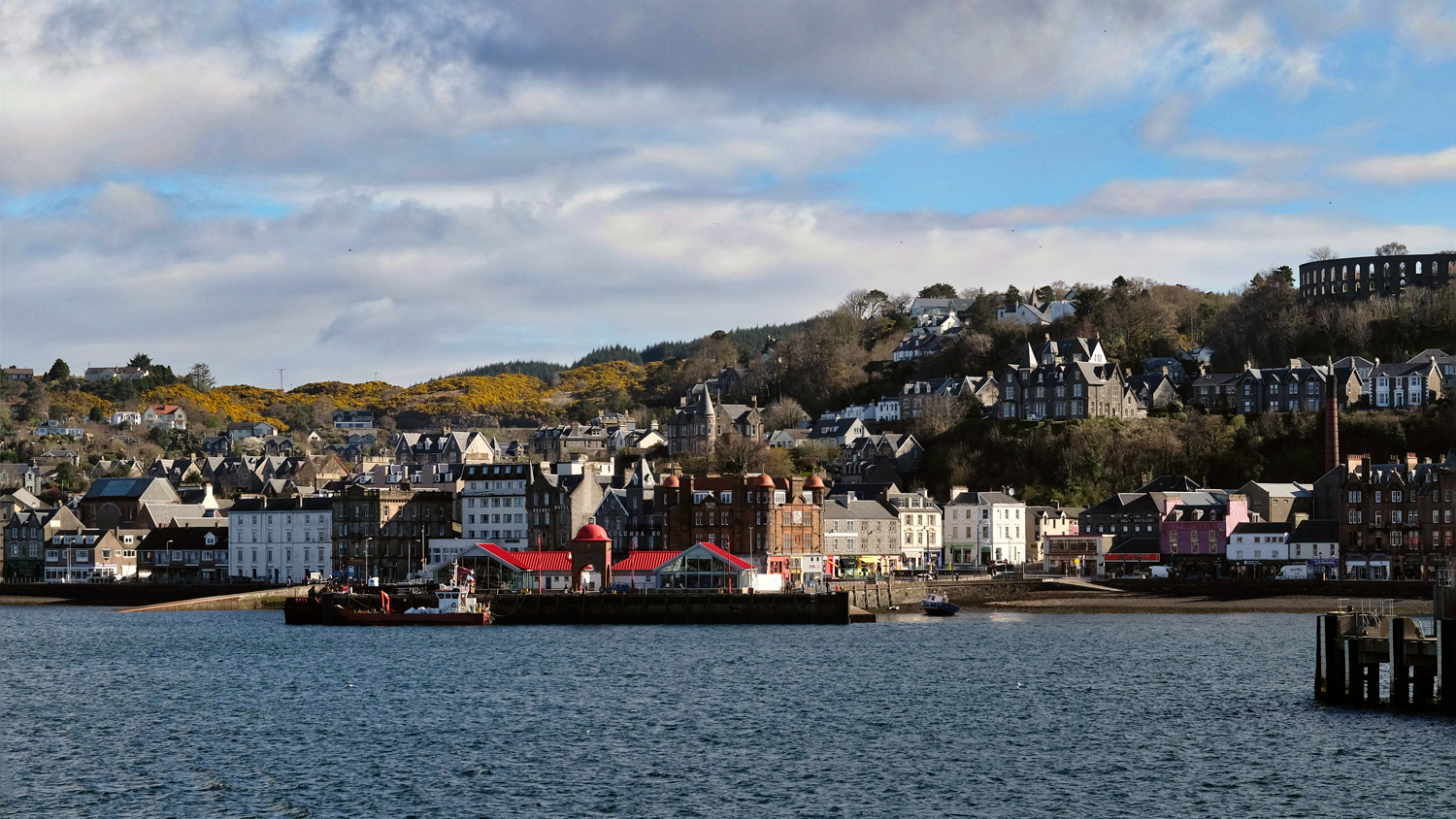 We arrived in the old harbour town of Oban. It is a favorite place of ours to visit, not just because of the ferries we have taken from here, but because our favorite restaurant to have fresh oysters is there (front and center on the dock with the bright red roof). "The best oysters in the world" - my wife says.
We arrived in the old harbour town of Oban. It is a favorite place of ours to visit, not just because of the ferries we have taken from here, but because our favorite restaurant to have fresh oysters is there (front and center on the dock with the bright red roof). "The best oysters in the world" - my wife says.
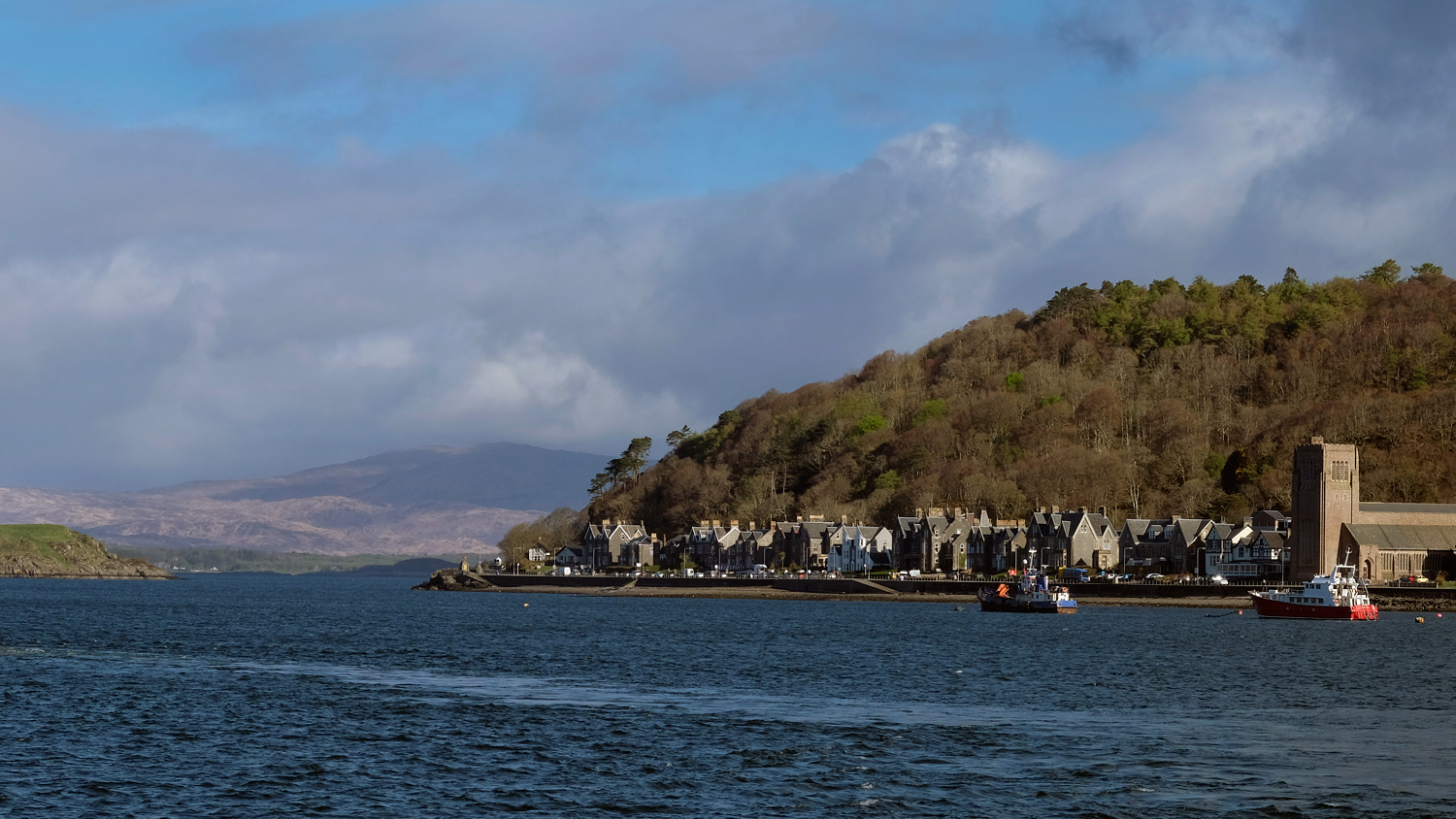 We checked into a nicely restored old seafront hotel (the only white one in the row of guesthouses and B&Bs).
We checked into a nicely restored old seafront hotel (the only white one in the row of guesthouses and B&Bs).
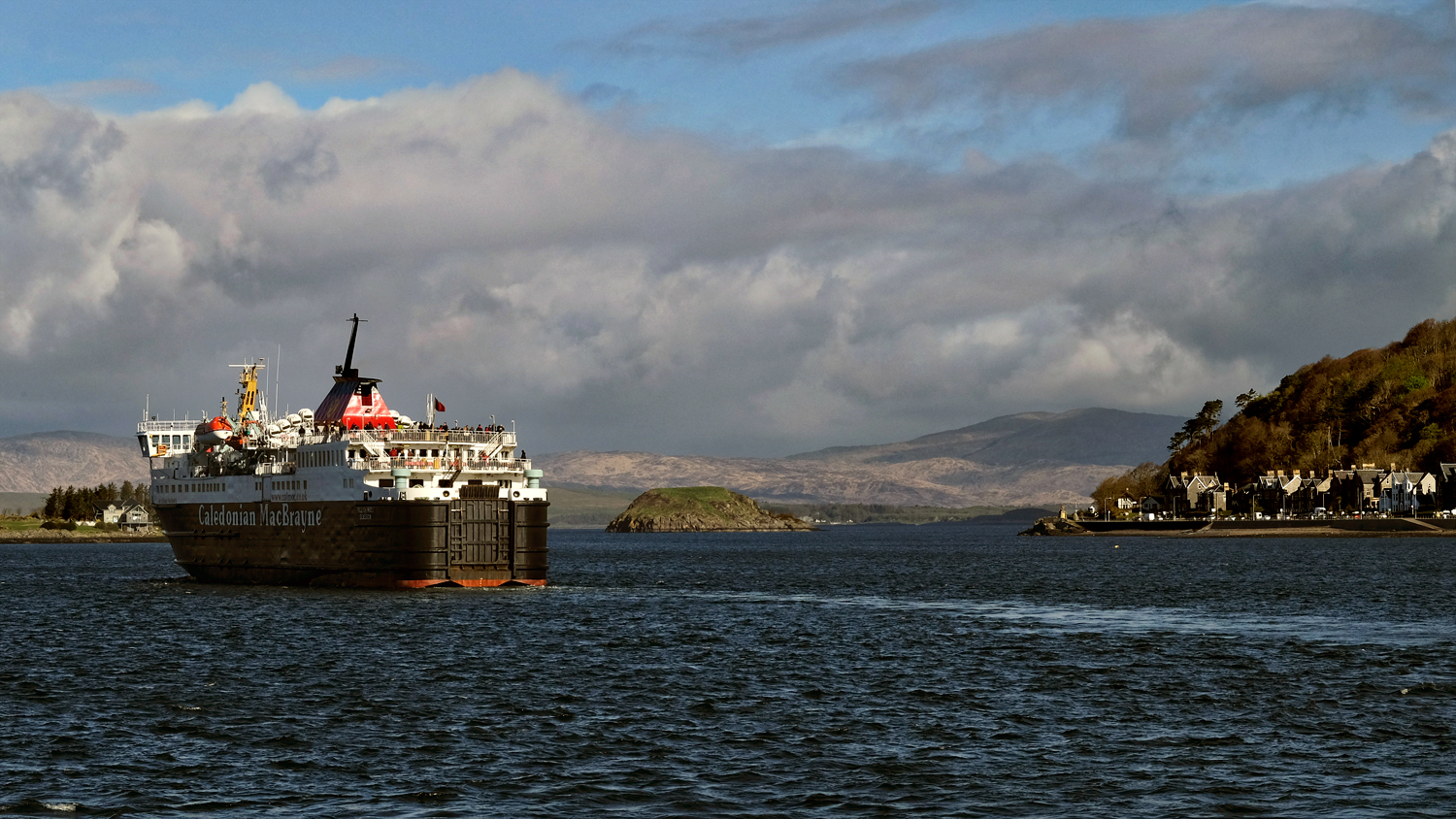 Ferry service to many of the western isles of Scotland originate from Oban.
Ferry service to many of the western isles of Scotland originate from Oban.
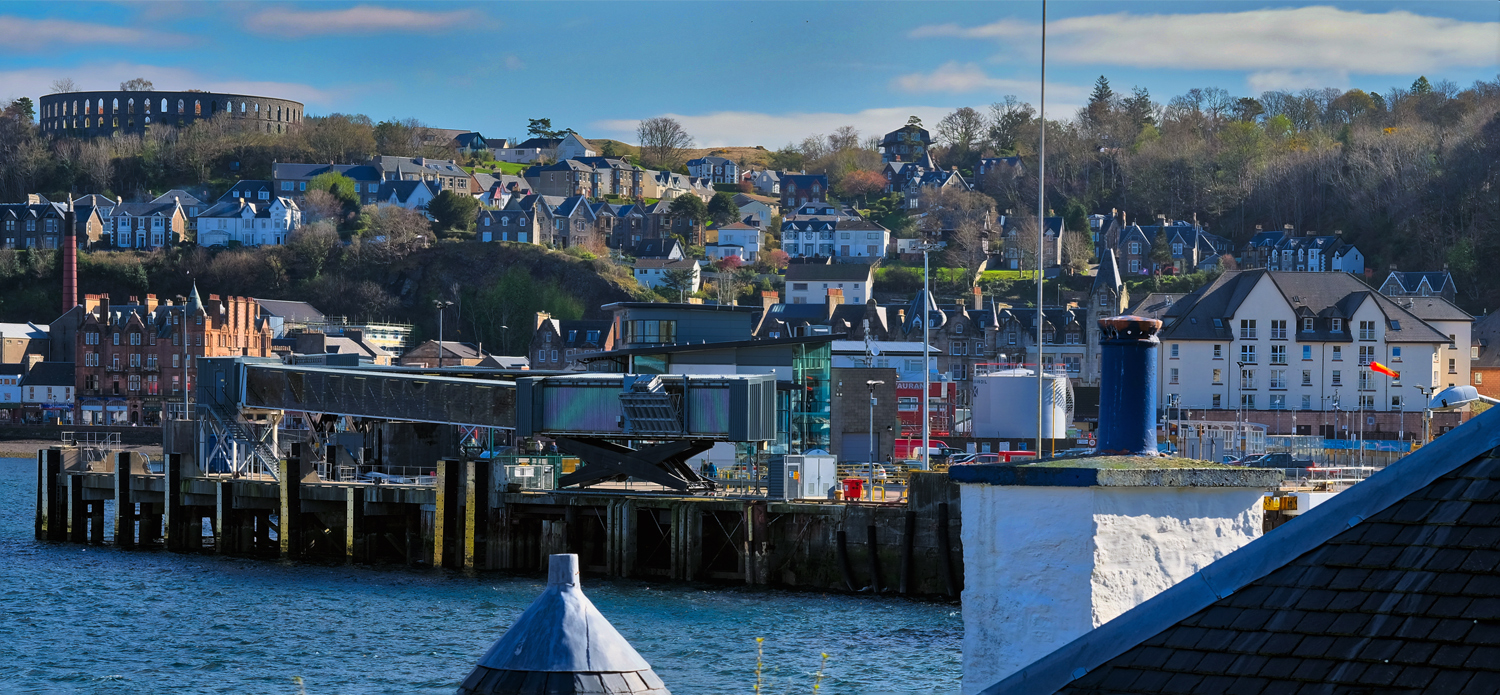 The Oban Ferry Terminal (foreground) where we departed for the Isle of Mull. That is a fake ruin on the horizon, a folly, built in Victorian times when ancient ruins were fashionable to have in your city.
The Oban Ferry Terminal (foreground) where we departed for the Isle of Mull. That is a fake ruin on the horizon, a folly, built in Victorian times when ancient ruins were fashionable to have in your city.
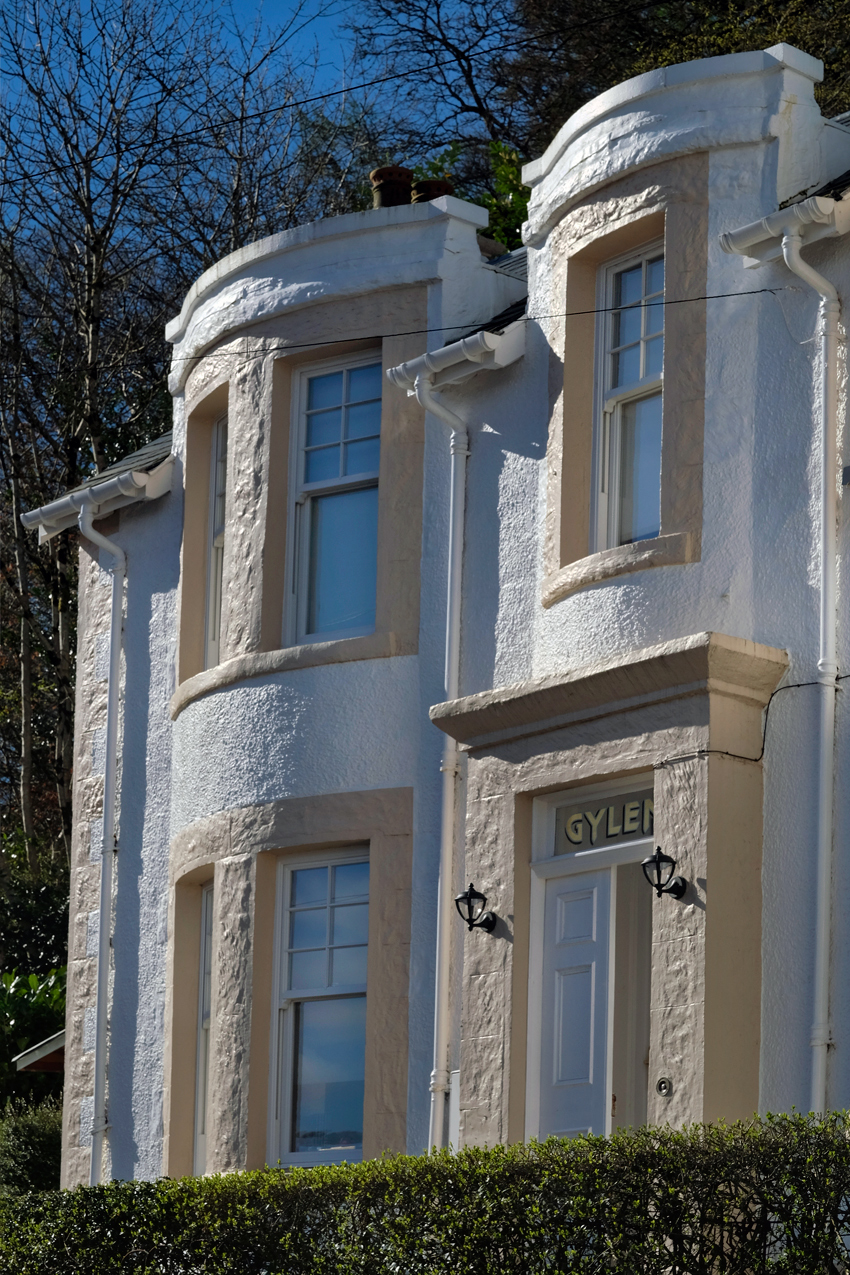 Oban has some fine old architecture. Here, Gaylen House.
Oban has some fine old architecture. Here, Gaylen House.
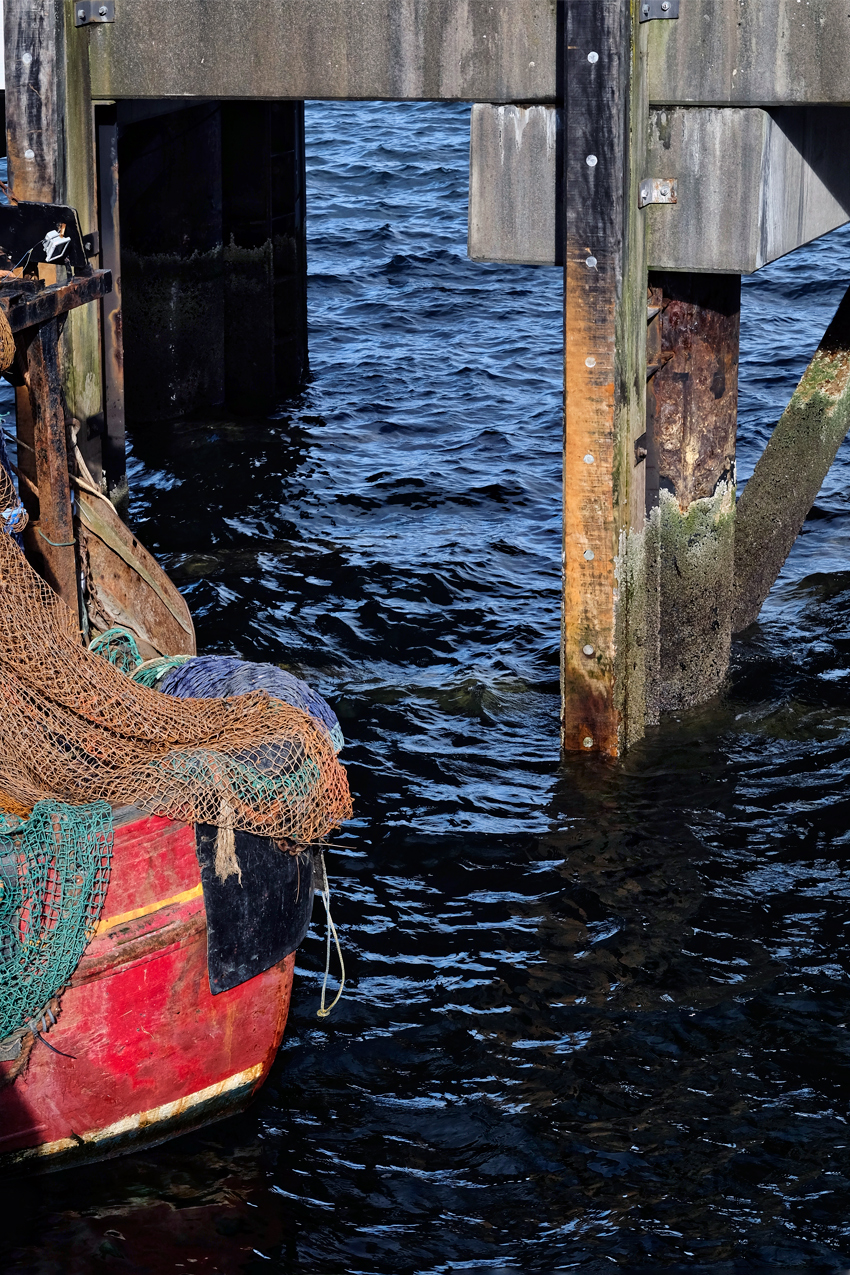 Down along the pier, Oban harbour.
Down along the pier, Oban harbour.
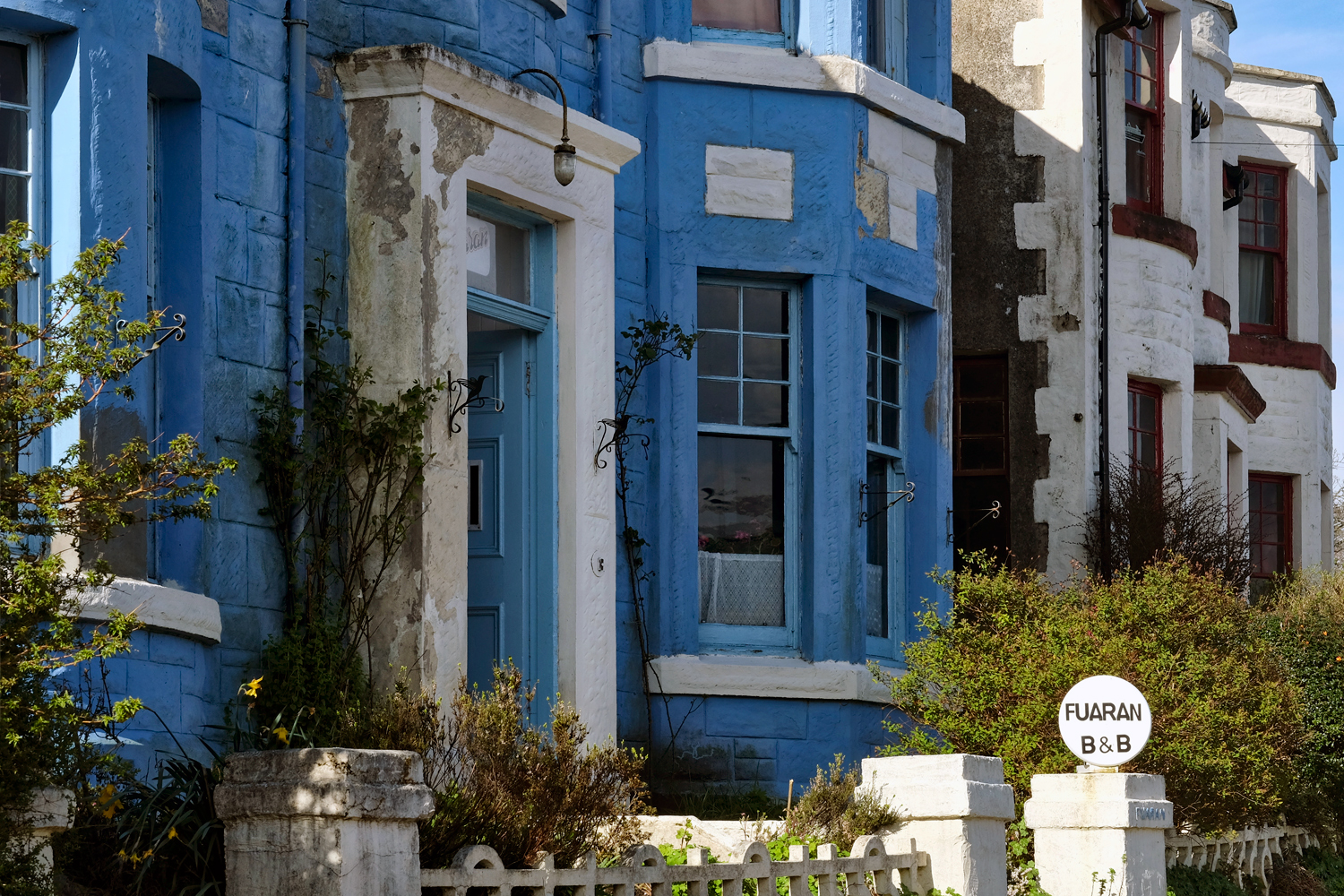 A row of old Oban harbour side B&Bs.
A row of old Oban harbour side B&Bs.
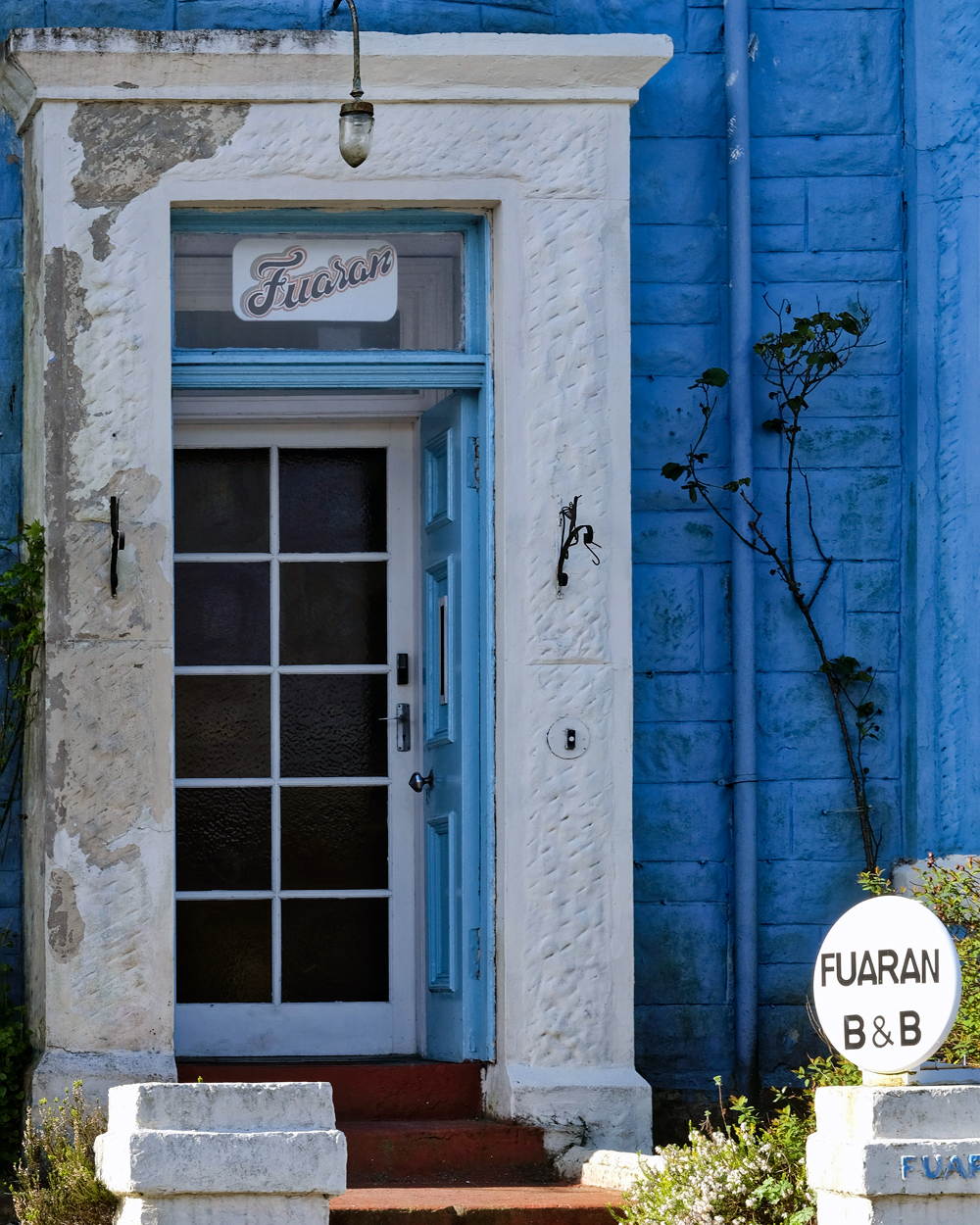 Quaint, weathered, old world charm.
Quaint, weathered, old world charm.
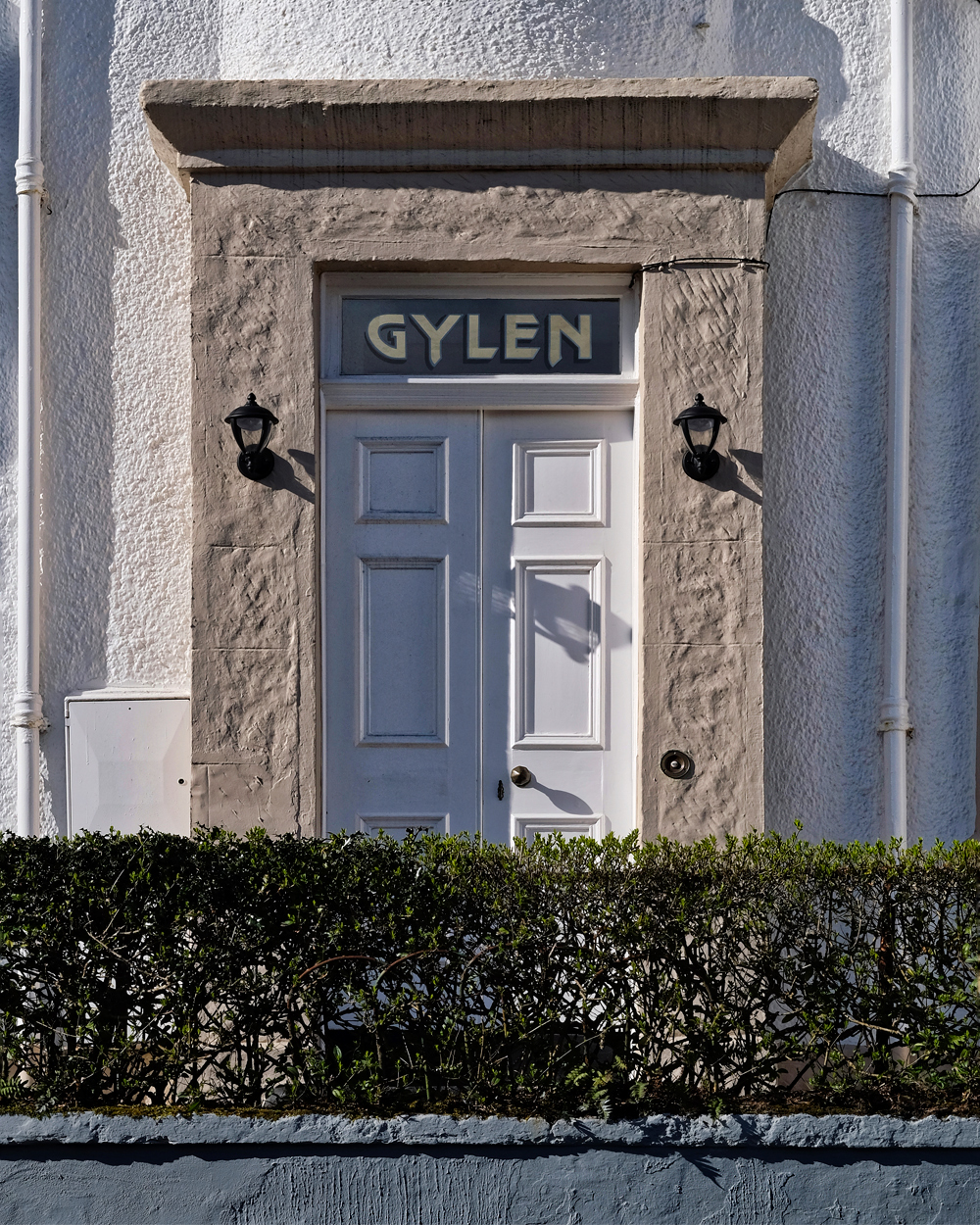 Weathered charm.
Weathered charm.
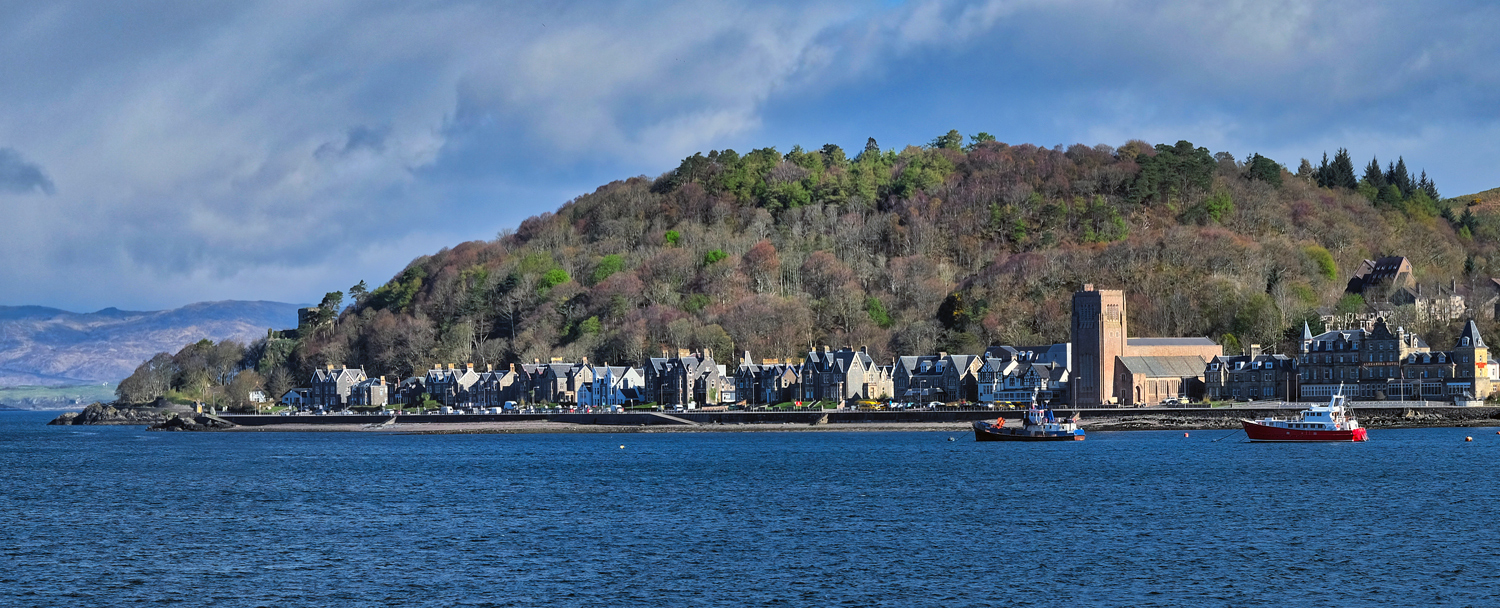 But Oban was just a stopover . . . our destination was across the water . . . the Isle of Mull.
But Oban was just a stopover . . . our destination was across the water . . . the Isle of Mull.
 The ferry that took us to the Isle of Mull as it arrived in Oban.
The ferry that took us to the Isle of Mull as it arrived in Oban.
 The views from the windy deck of the ferry were breathtaking!
The views from the windy deck of the ferry were breathtaking!
 The rugged hills of the Isle of Mull.
The rugged hills of the Isle of Mull.
 The Isle of Mull in a nutshell . . . a sea economy and culture.
The Isle of Mull in a nutshell . . . a sea economy and culture.
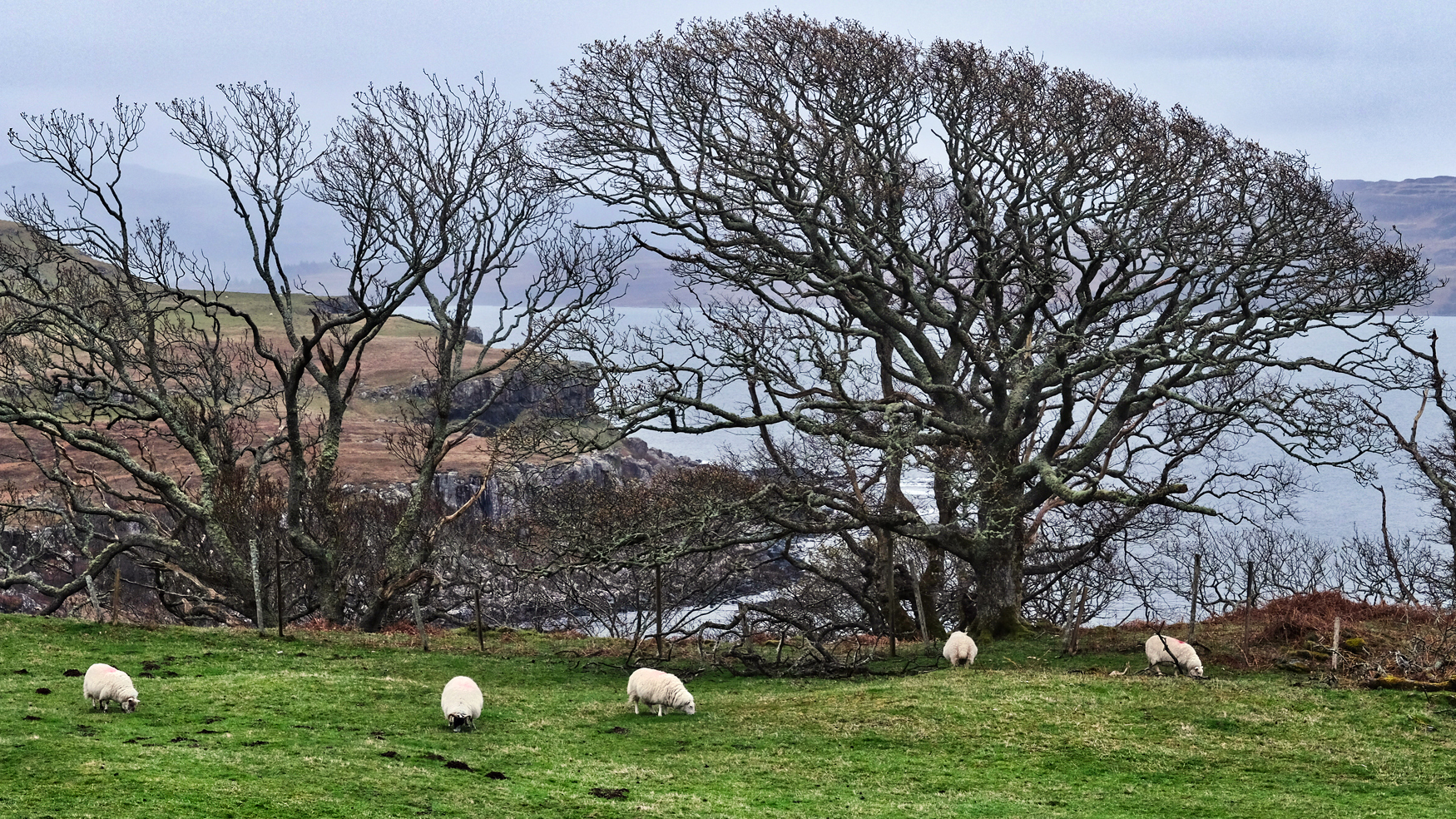 Friends and family visiting from Thailand means an opportunity for a road trip somewhere I have never been. The Isle of Mull, and it's atmospheric and moody landscapes and quaint seaside villages beckoned . . .
Friends and family visiting from Thailand means an opportunity for a road trip somewhere I have never been. The Isle of Mull, and it's atmospheric and moody landscapes and quaint seaside villages beckoned . . .
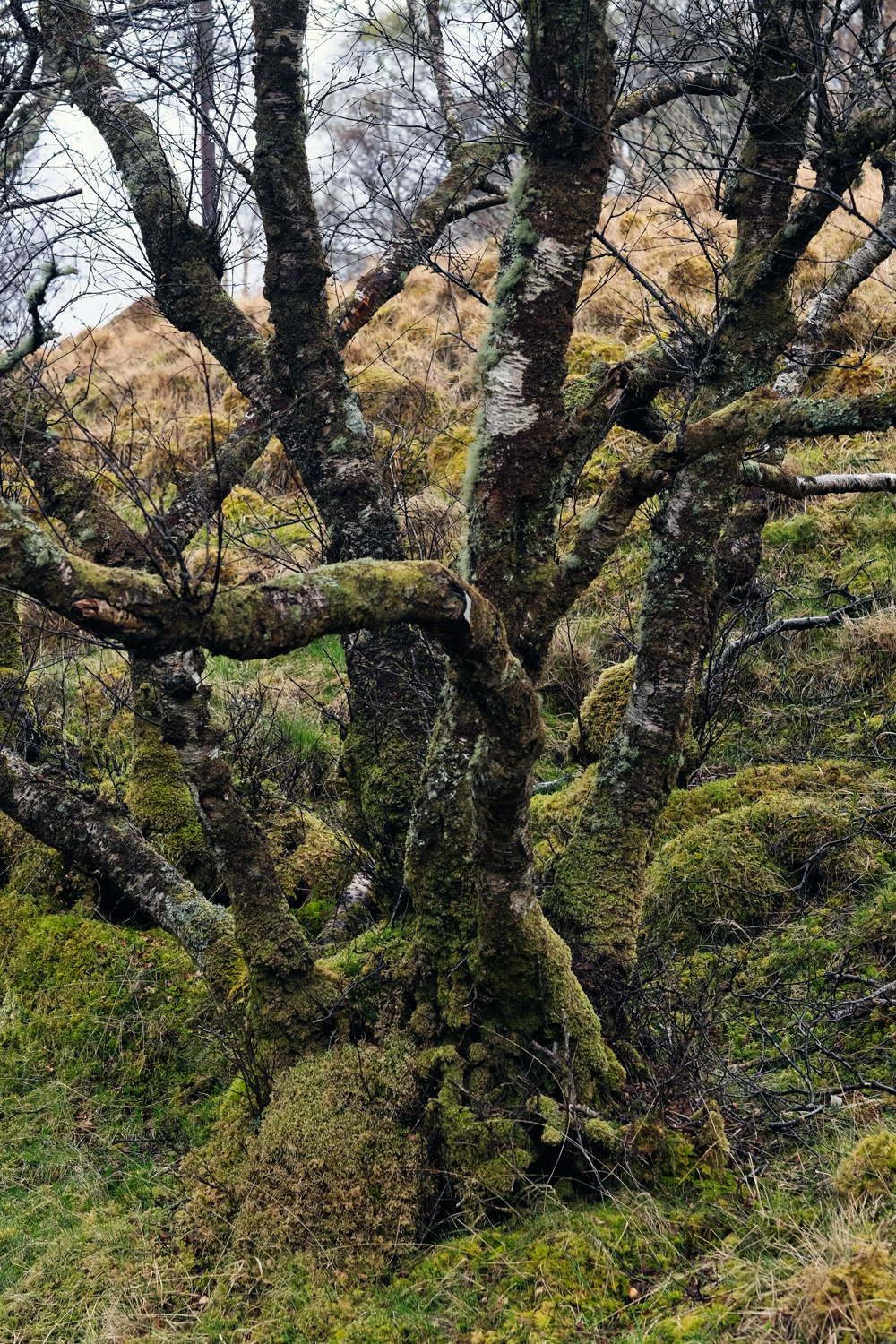 The west coast of the Isle of Mull is wet, wet, wet.
The west coast of the Isle of Mull is wet, wet, wet.
 Thick, wet moss of the west coast.
Thick, wet moss of the west coast.
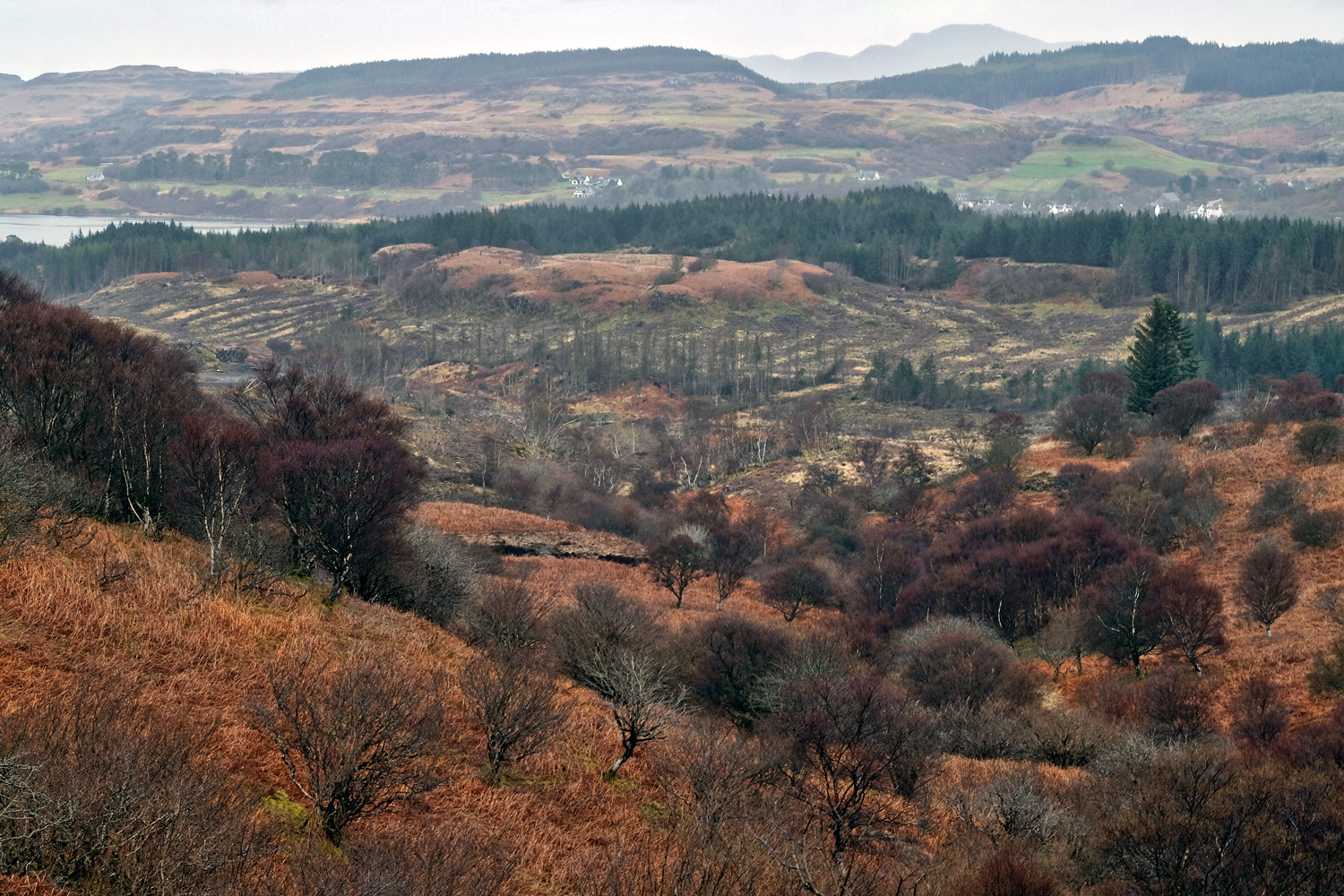 Early April 2017 . . . always very damp Isle of Mull. The dampness on a cloudy day certainly brings out the color of the decomposing autumn foliage. A view from a hill.
Early April 2017 . . . always very damp Isle of Mull. The dampness on a cloudy day certainly brings out the color of the decomposing autumn foliage. A view from a hill.
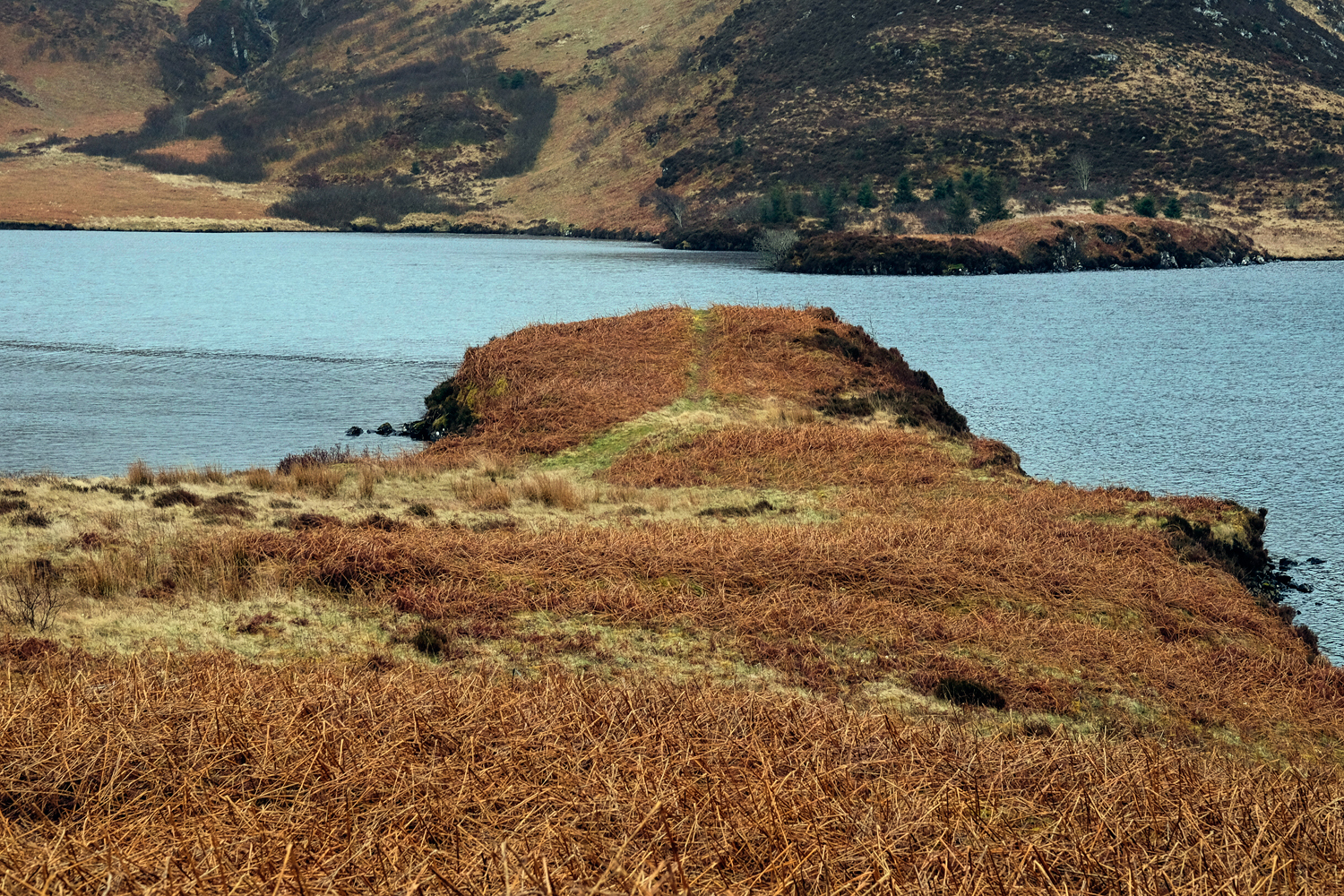 The sea invades the land around the whole of the Isle of Mull.
The sea invades the land around the whole of the Isle of Mull.
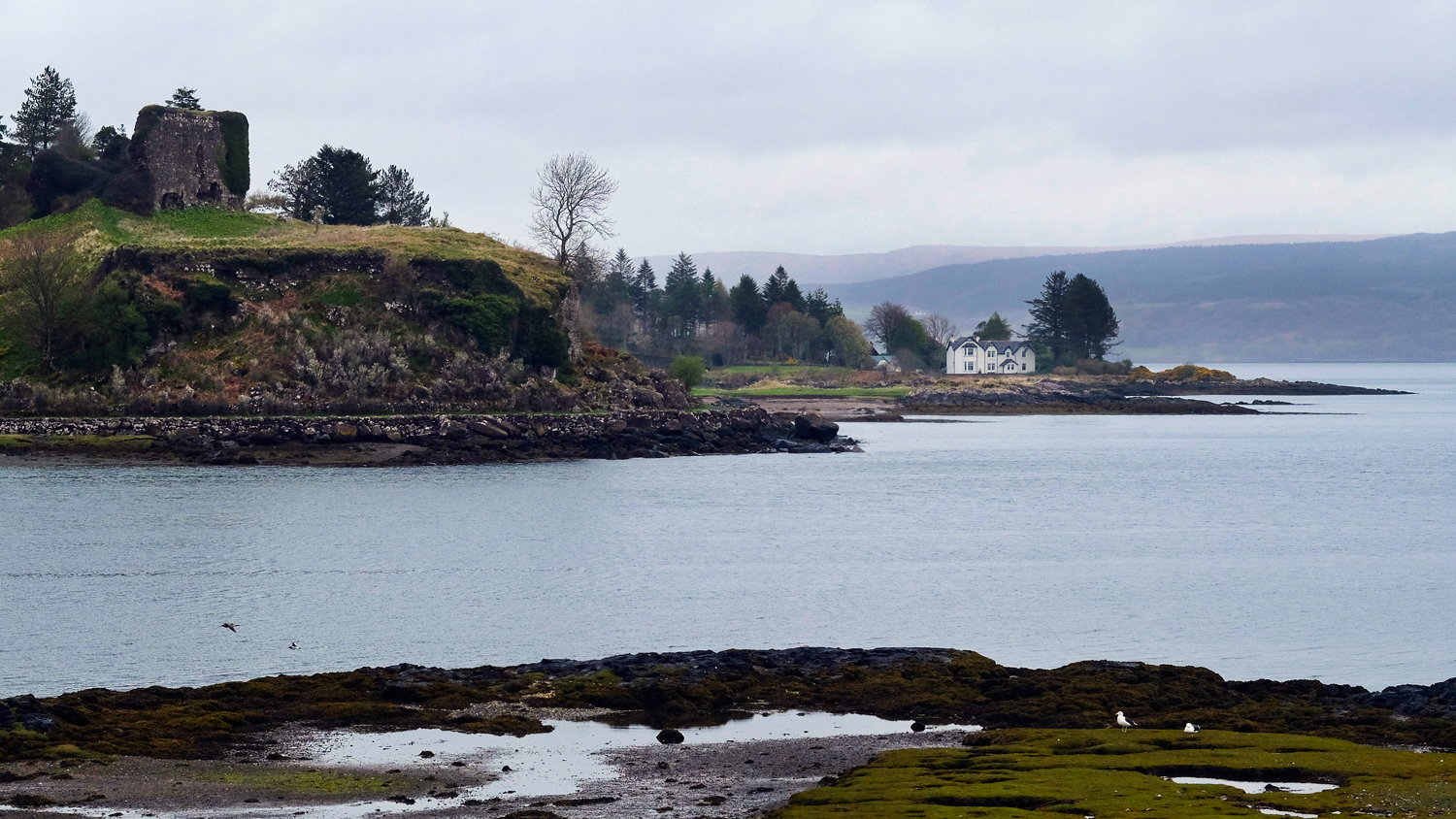 When we saw a castle ruin we would stop for photos.
When we saw a castle ruin we would stop for photos.
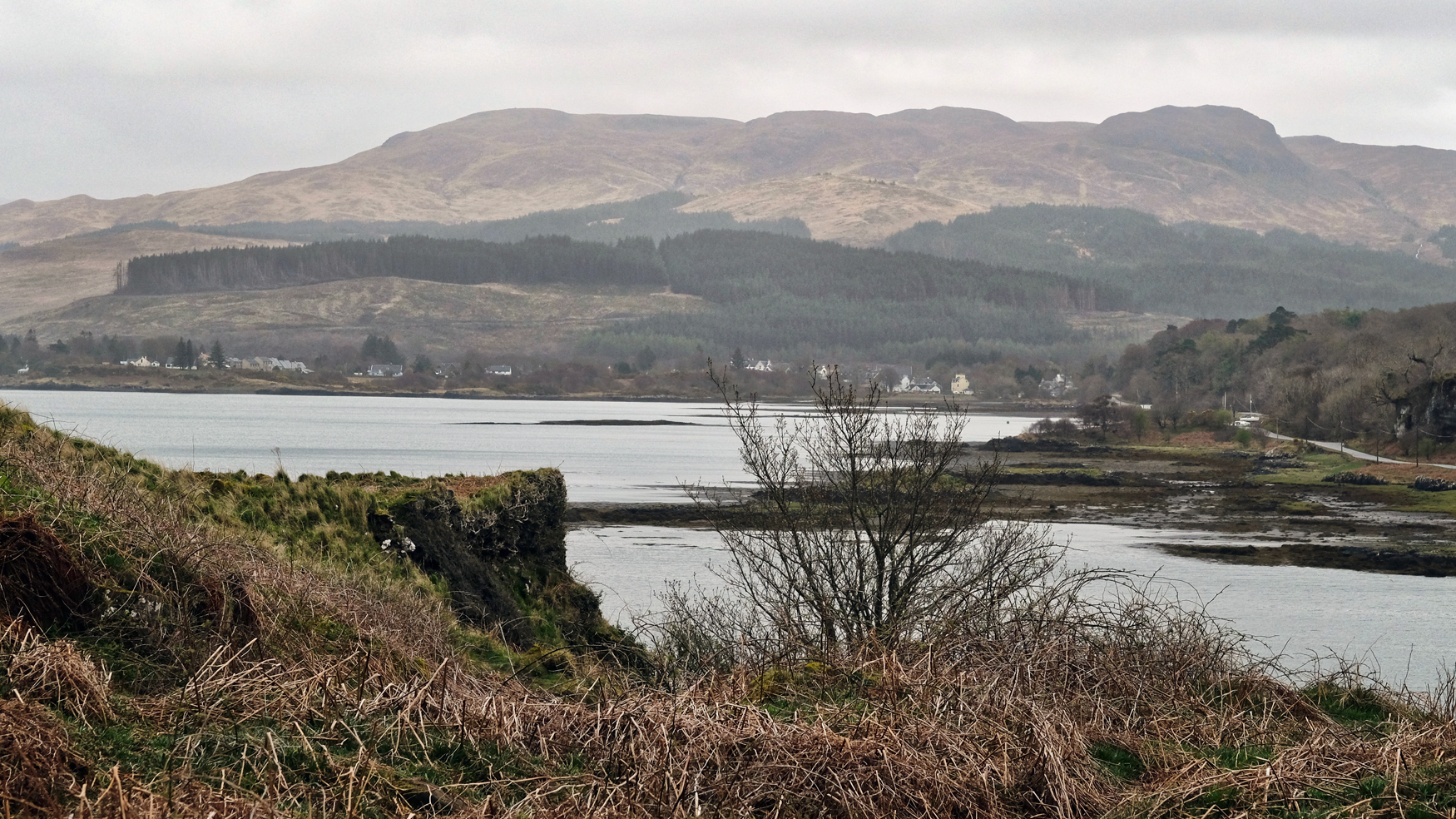 We stopped often and walked out to points of interest and to gaze upon the fantastically moody vistas.
We stopped often and walked out to points of interest and to gaze upon the fantastically moody vistas.
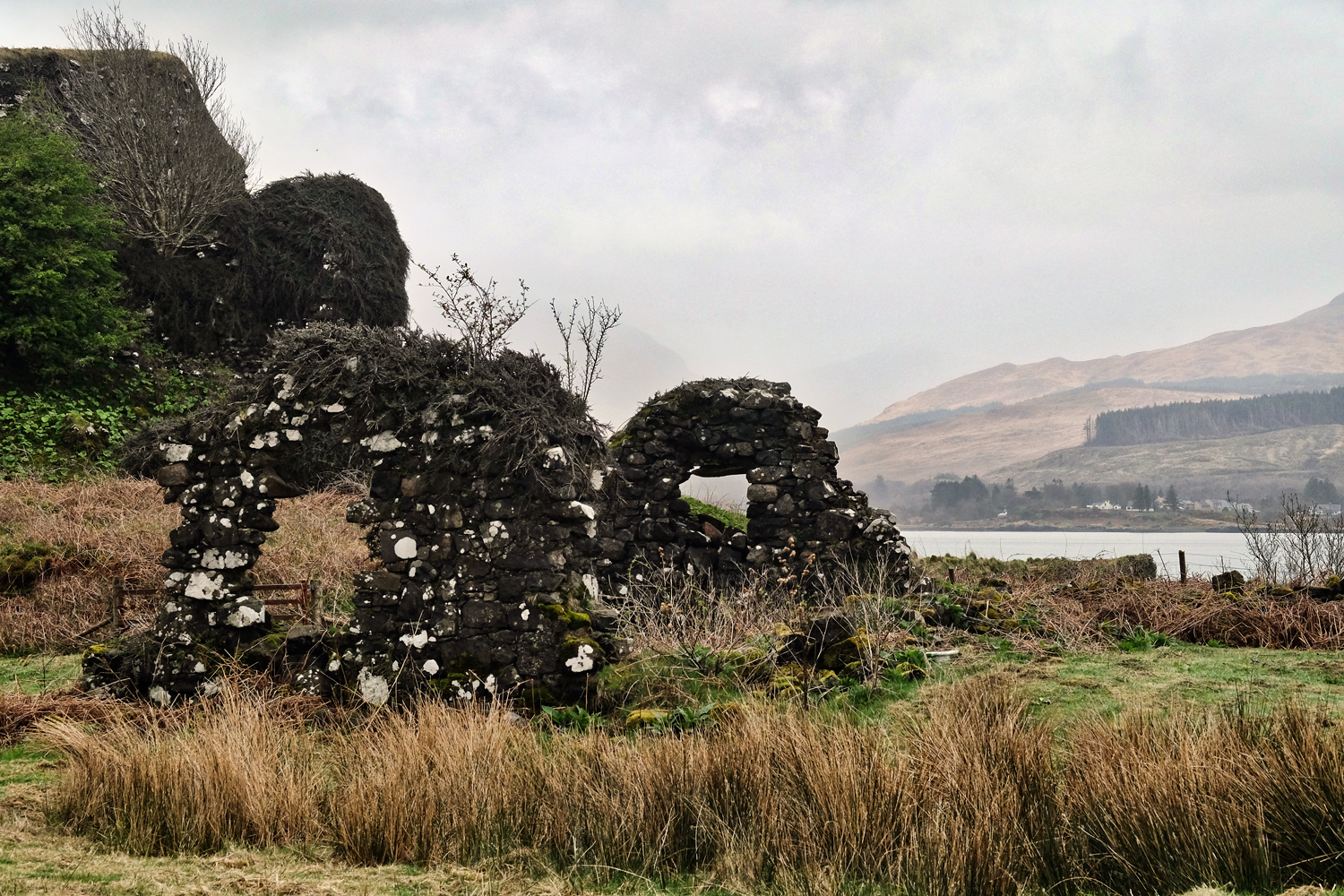 As is true for all of Scotland, there are always castle ruins to explore.
As is true for all of Scotland, there are always castle ruins to explore.
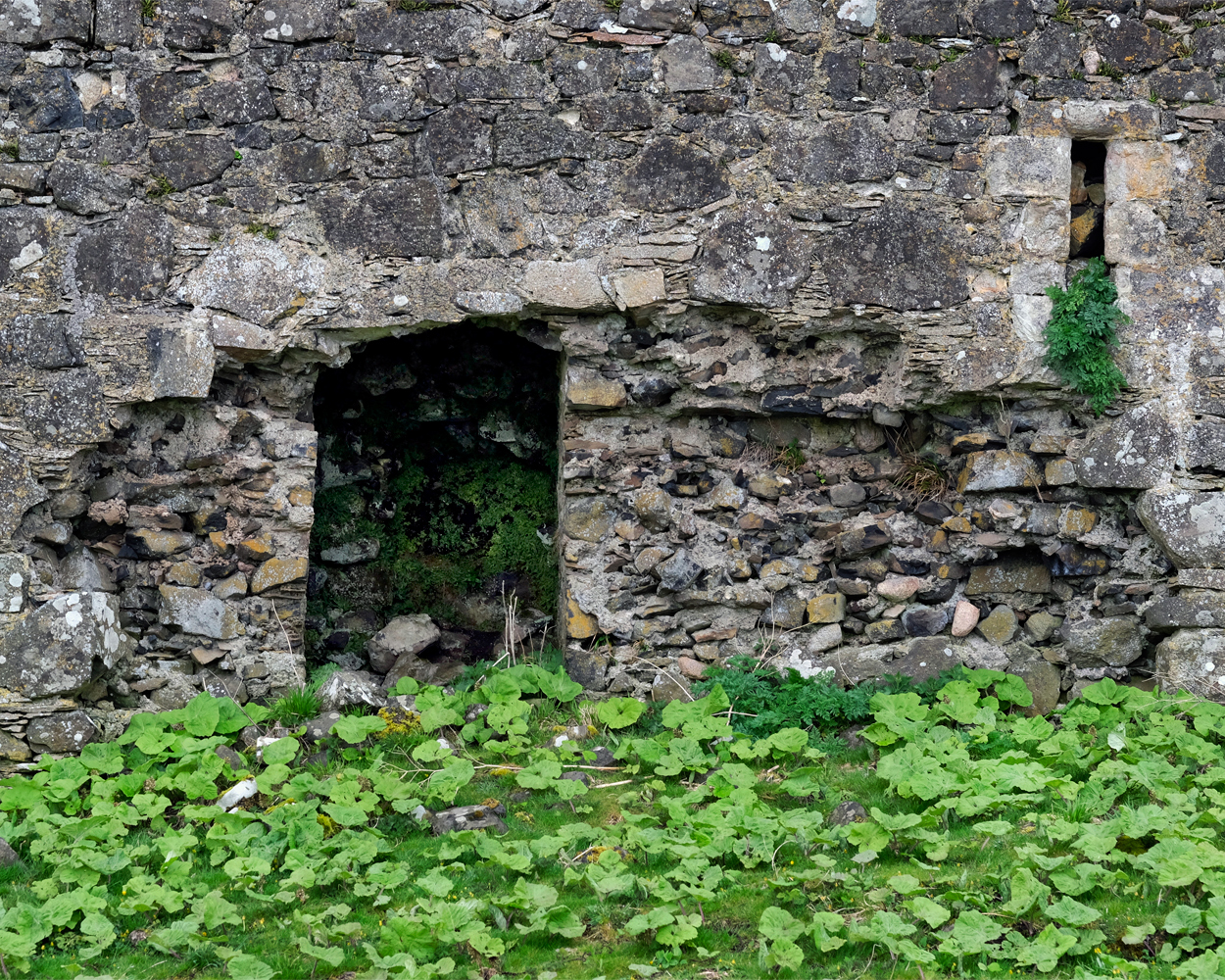 Castle ruins everywhere. These are the ruins of 14th century Aros Castle.
Castle ruins everywhere. These are the ruins of 14th century Aros Castle.
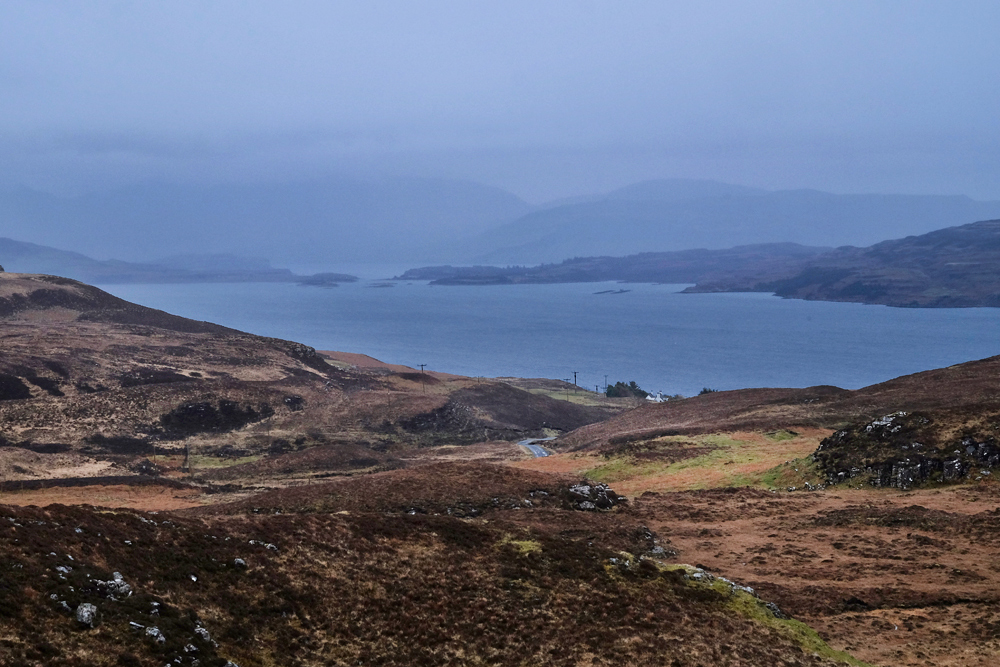 Isle of Mull always presents a strange, otherworldly view.
Isle of Mull always presents a strange, otherworldly view.
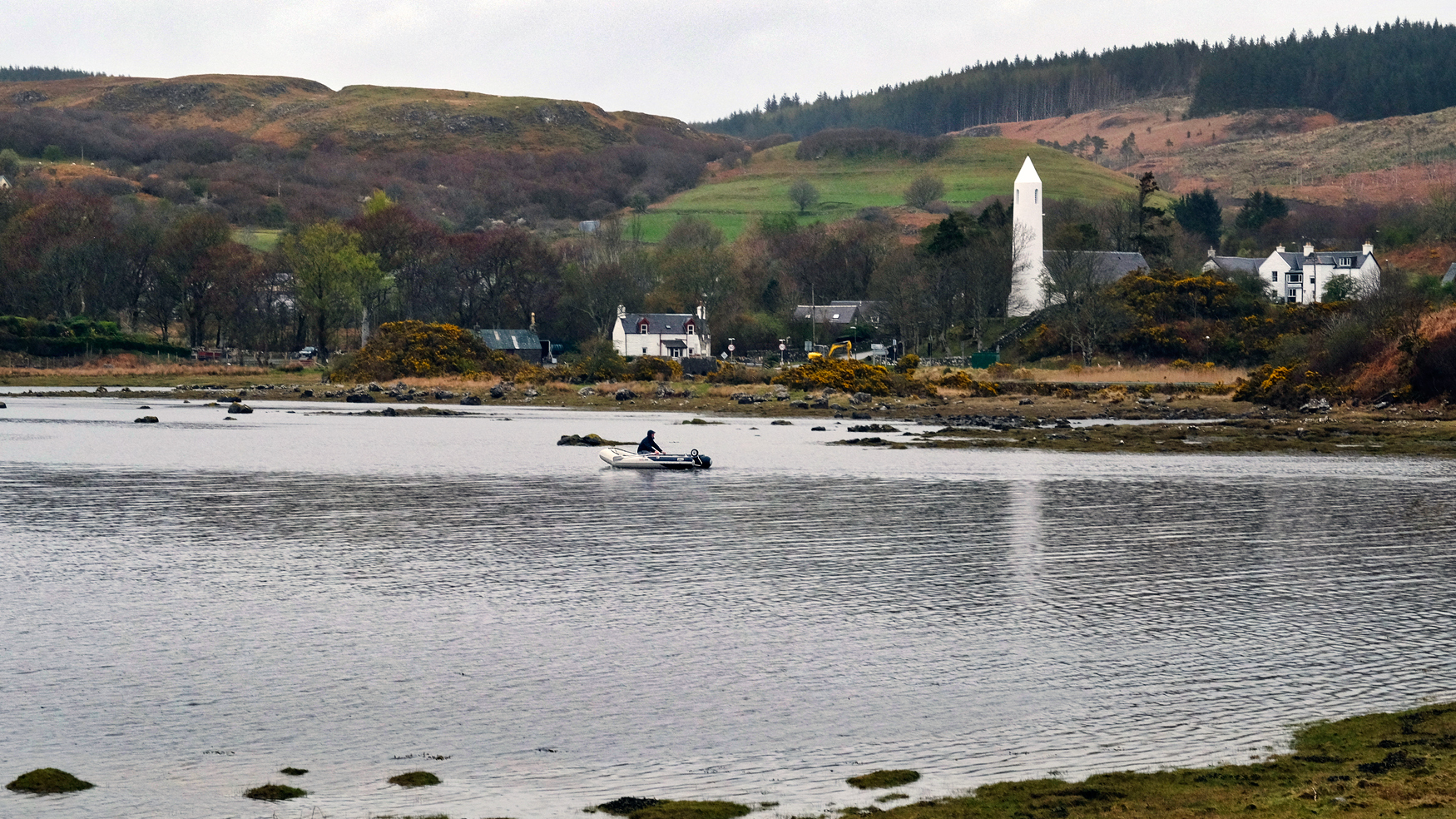 A fisherman out on an Isle of Mull inlet.
A fisherman out on an Isle of Mull inlet.
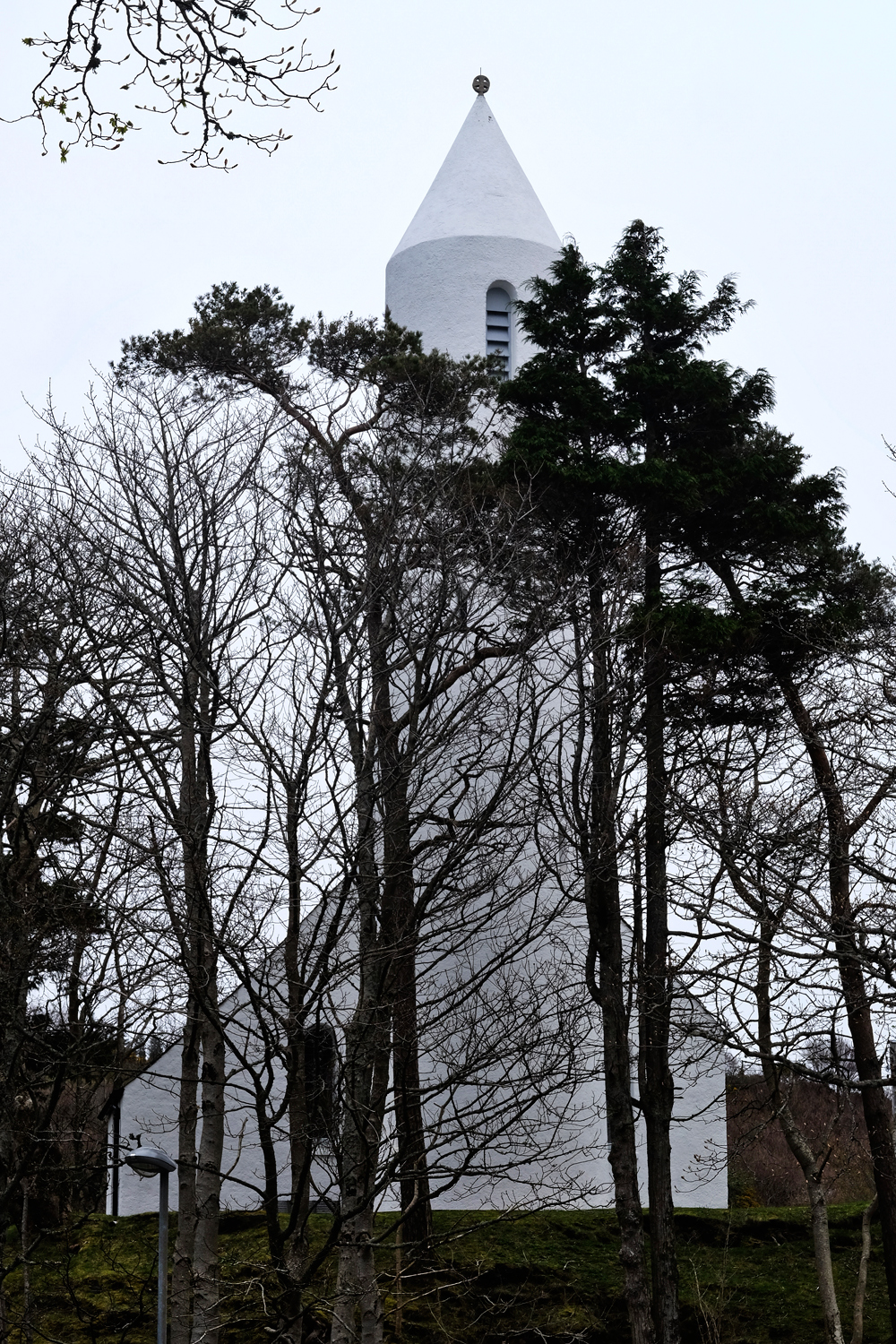 Small villages dot the inlets.
Small villages dot the inlets.
 This church was in a style I had not seen before in Scotland.
This church was in a style I had not seen before in Scotland.
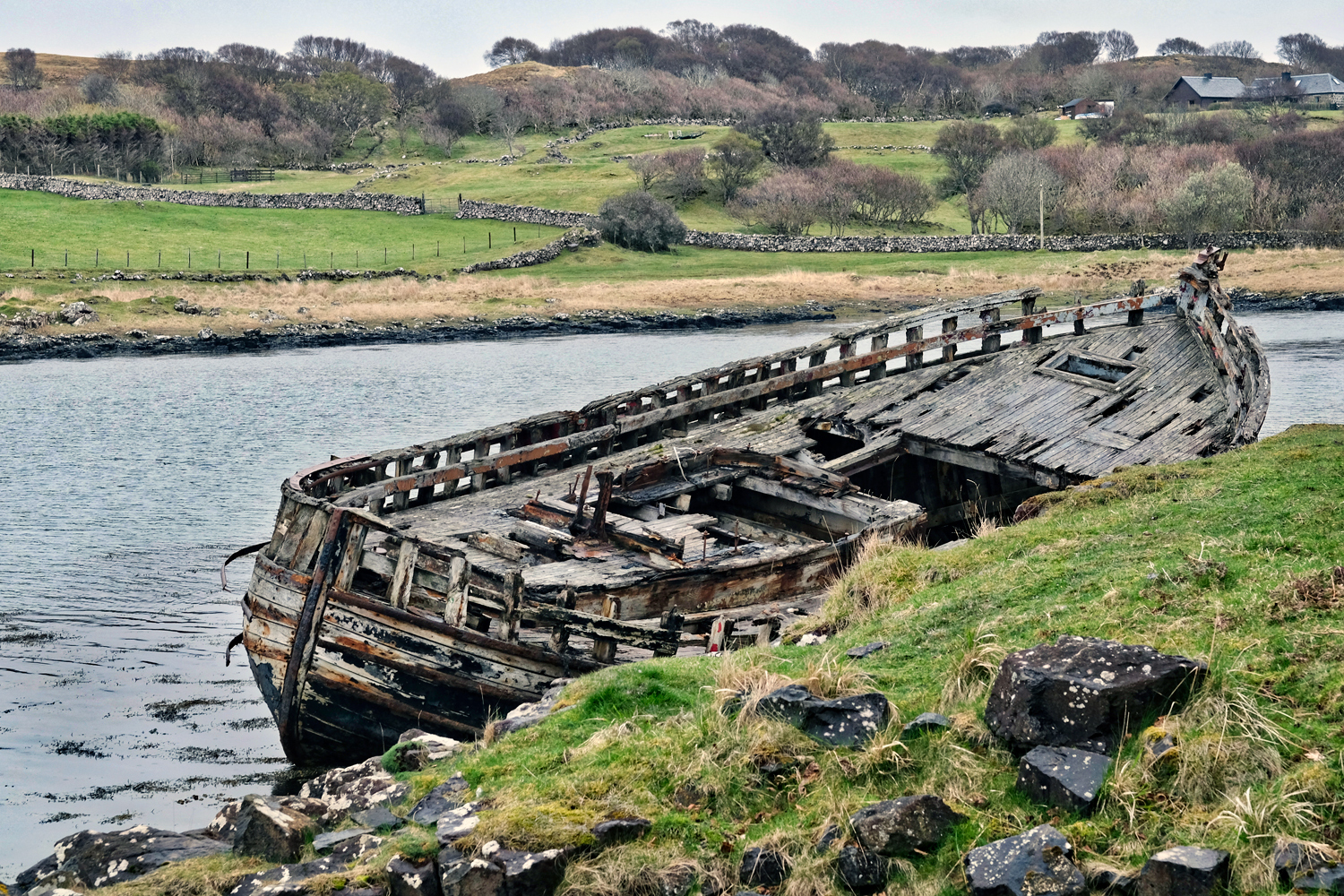 Abandoned and weathering ship on the Isle of Mull.
Abandoned and weathering ship on the Isle of Mull.
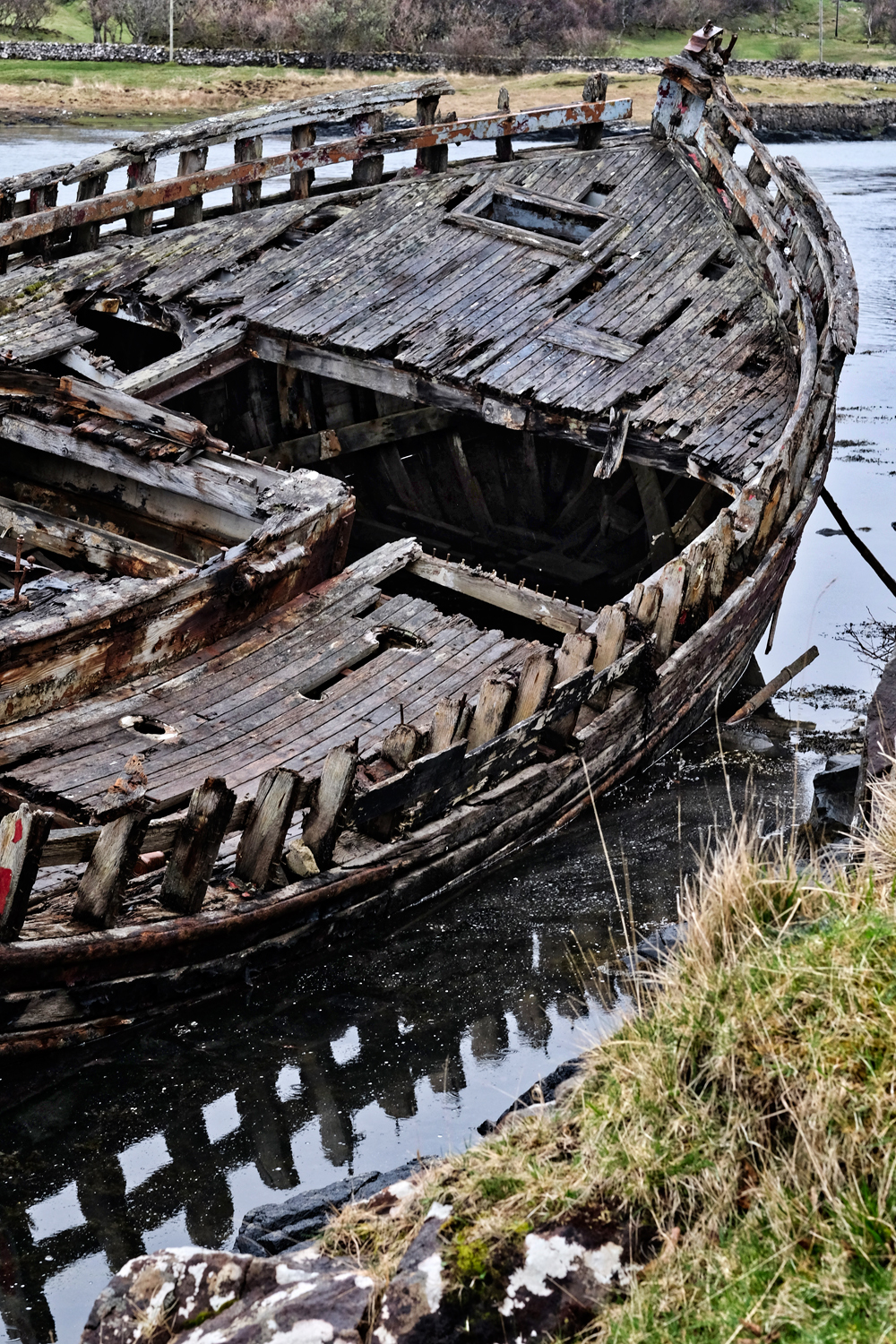 The dampness from a light drizzle brought out the color, pattern, detail, and complexity of the old rotting ship.
The dampness from a light drizzle brought out the color, pattern, detail, and complexity of the old rotting ship.
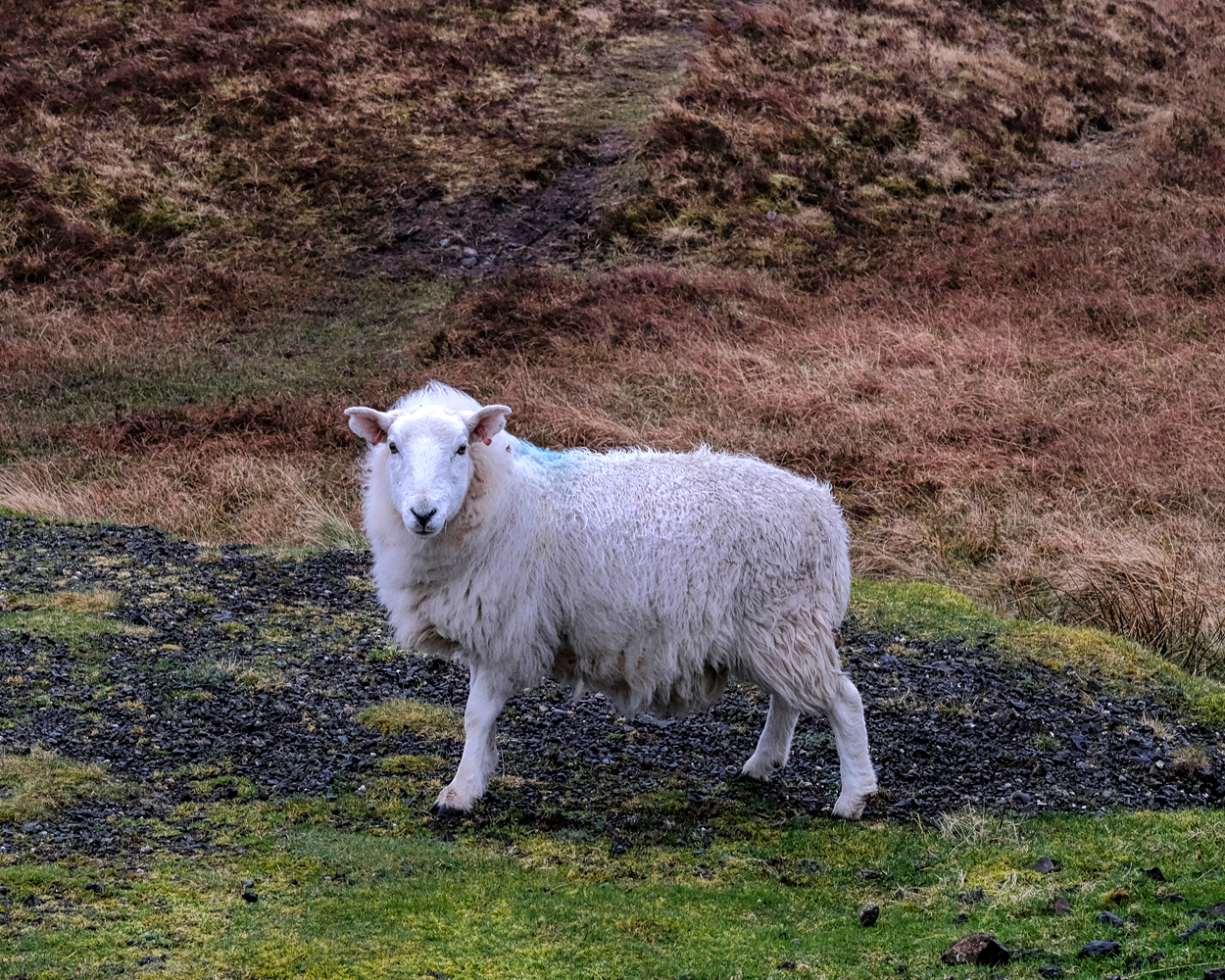 Sheep everywhere. Very wet sheep.
Sheep everywhere. Very wet sheep.
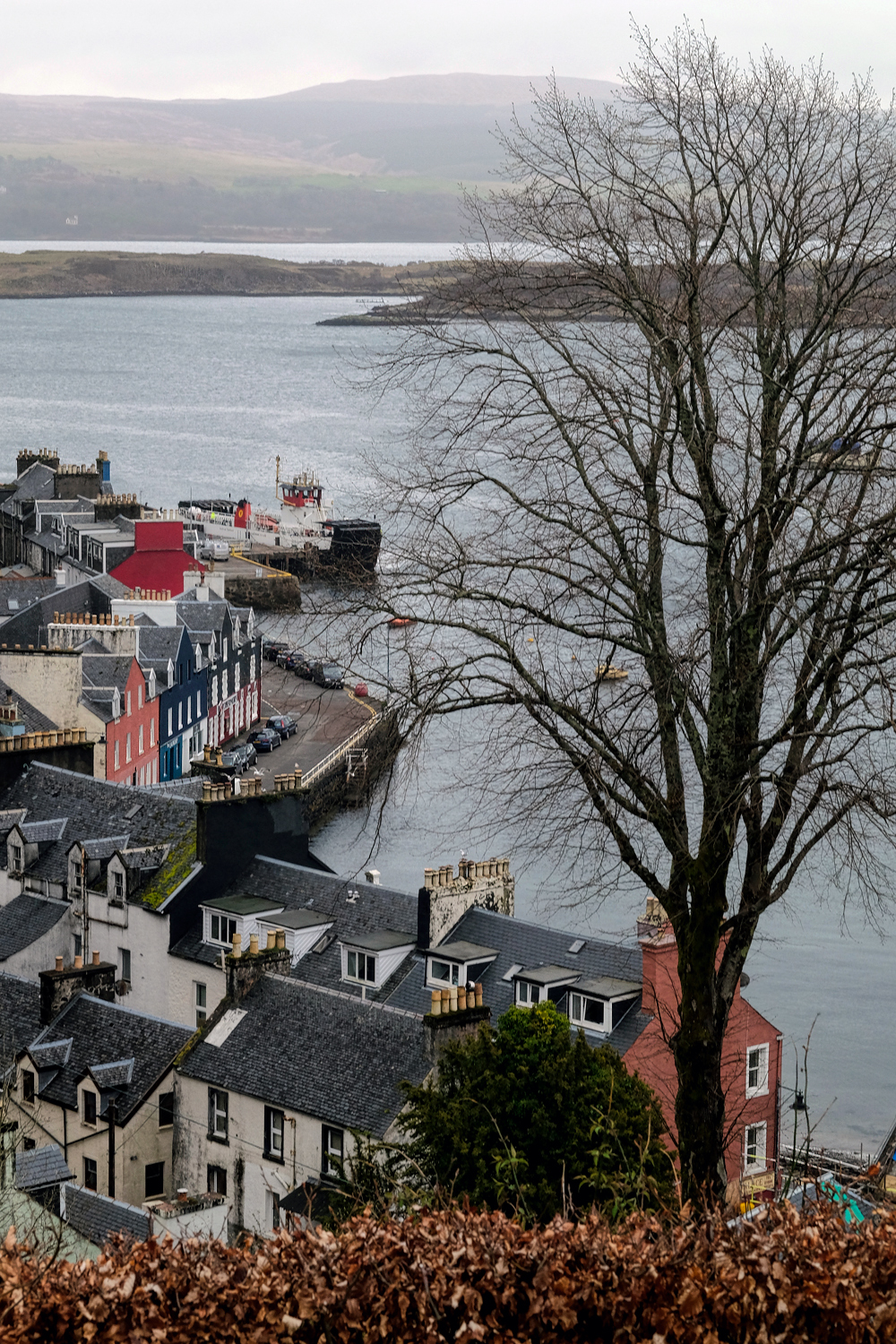 View from our hilltop B&B of the sweet 'town' of Tobermory.
View from our hilltop B&B of the sweet 'town' of Tobermory.
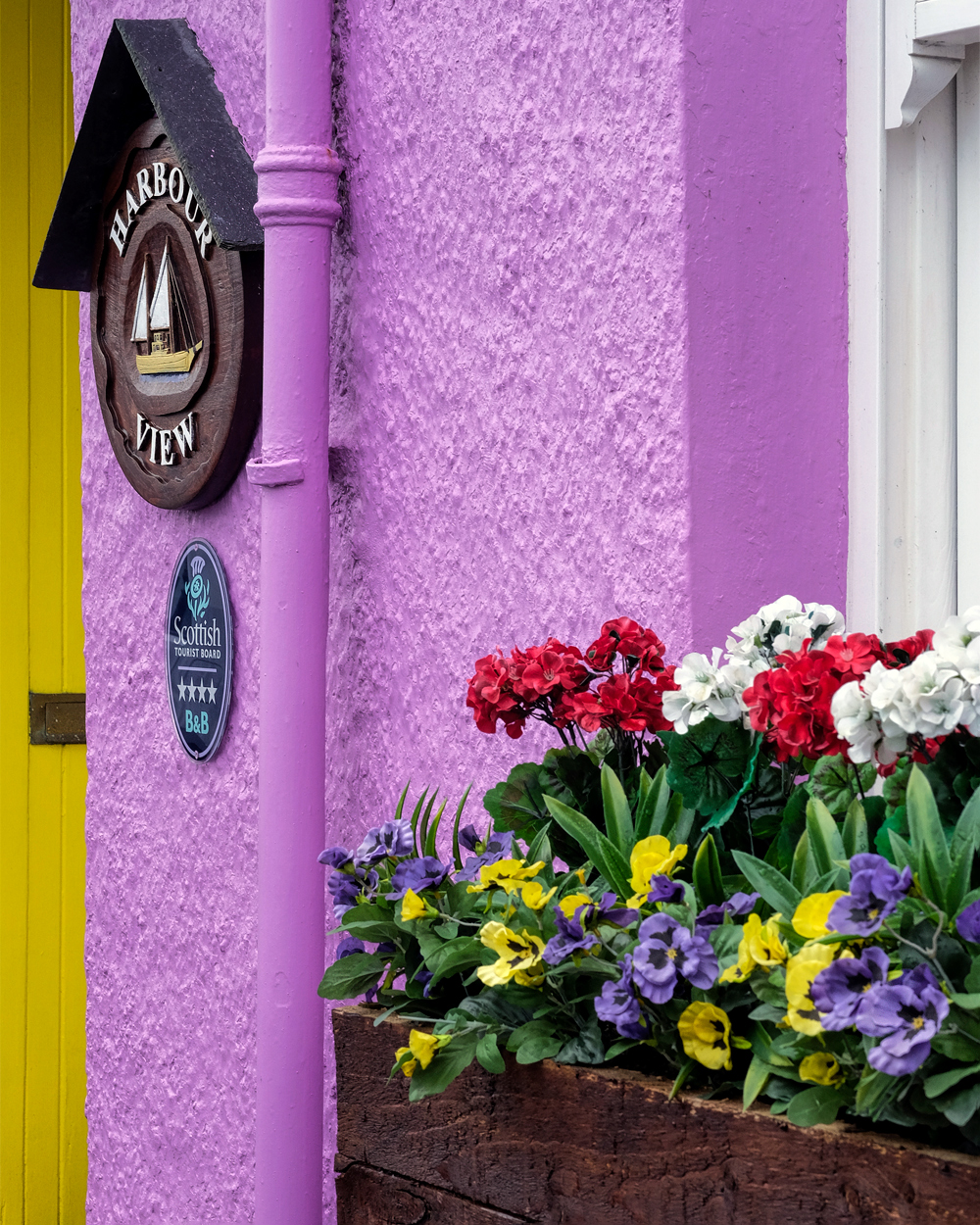 Our very sweet B&B, The Harbour View, was was run by a Scot and a Thai! Our Thai visitors were able to have Thai breakfast!
Our very sweet B&B, The Harbour View, was was run by a Scot and a Thai! Our Thai visitors were able to have Thai breakfast!
 Tobermory, Isle of Mull, has to be one of the most picturesque villages I have ever seen!
Tobermory, Isle of Mull, has to be one of the most picturesque villages I have ever seen!
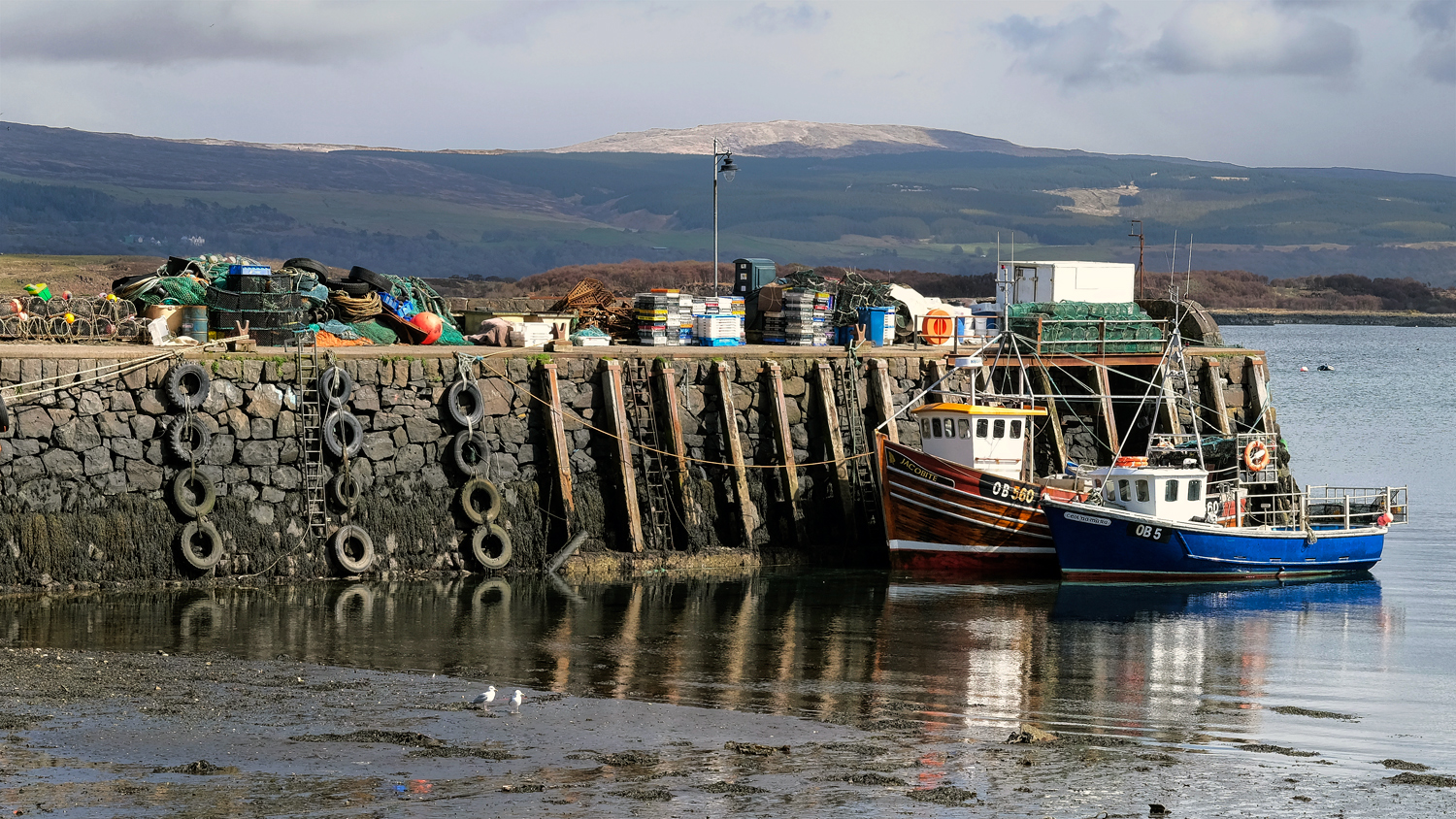 Not only a photographer's dream . . . Tobermory is a painters dream as well.
Not only a photographer's dream . . . Tobermory is a painters dream as well.
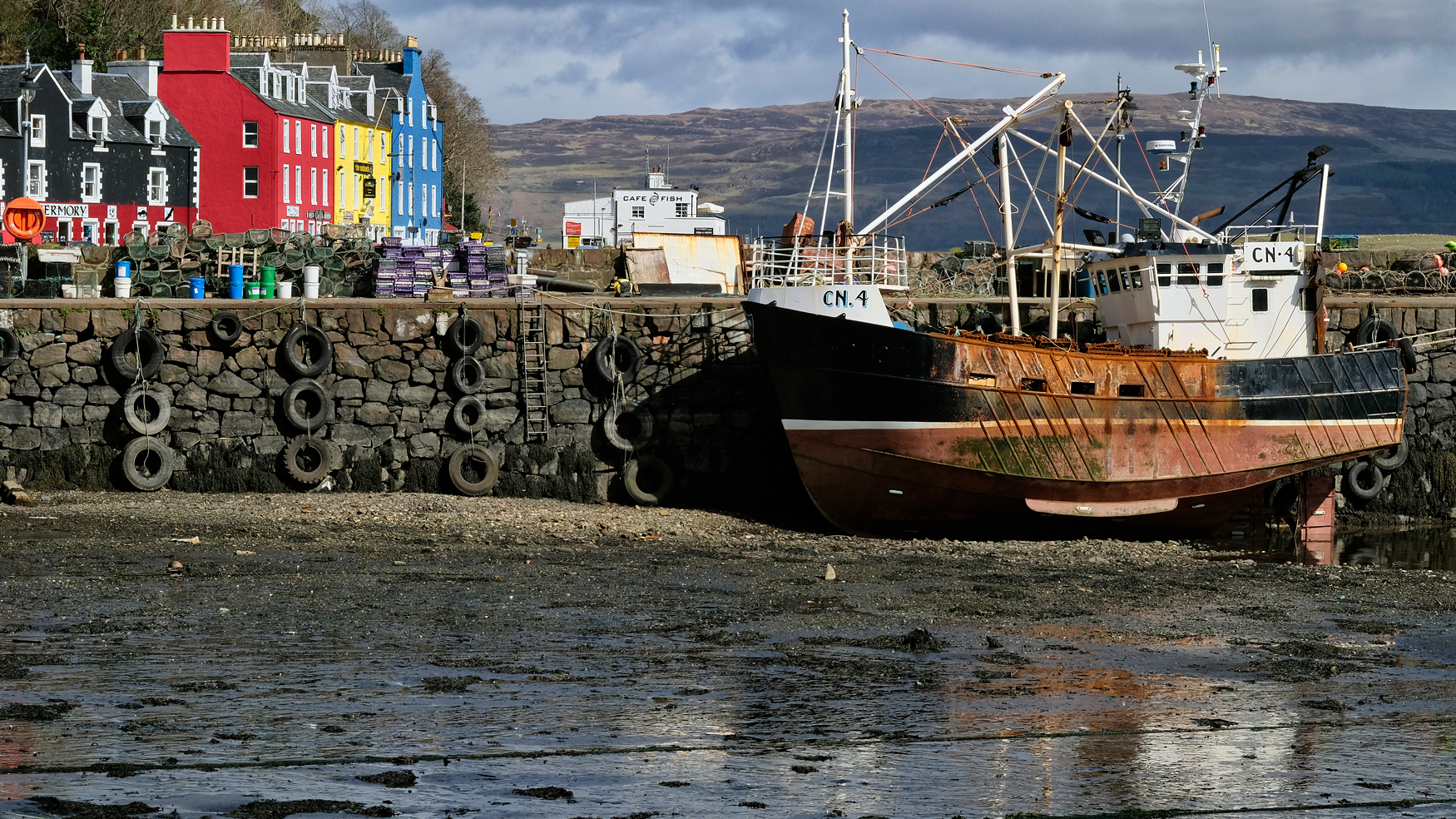 Simply Beautiful.
Simply Beautiful.
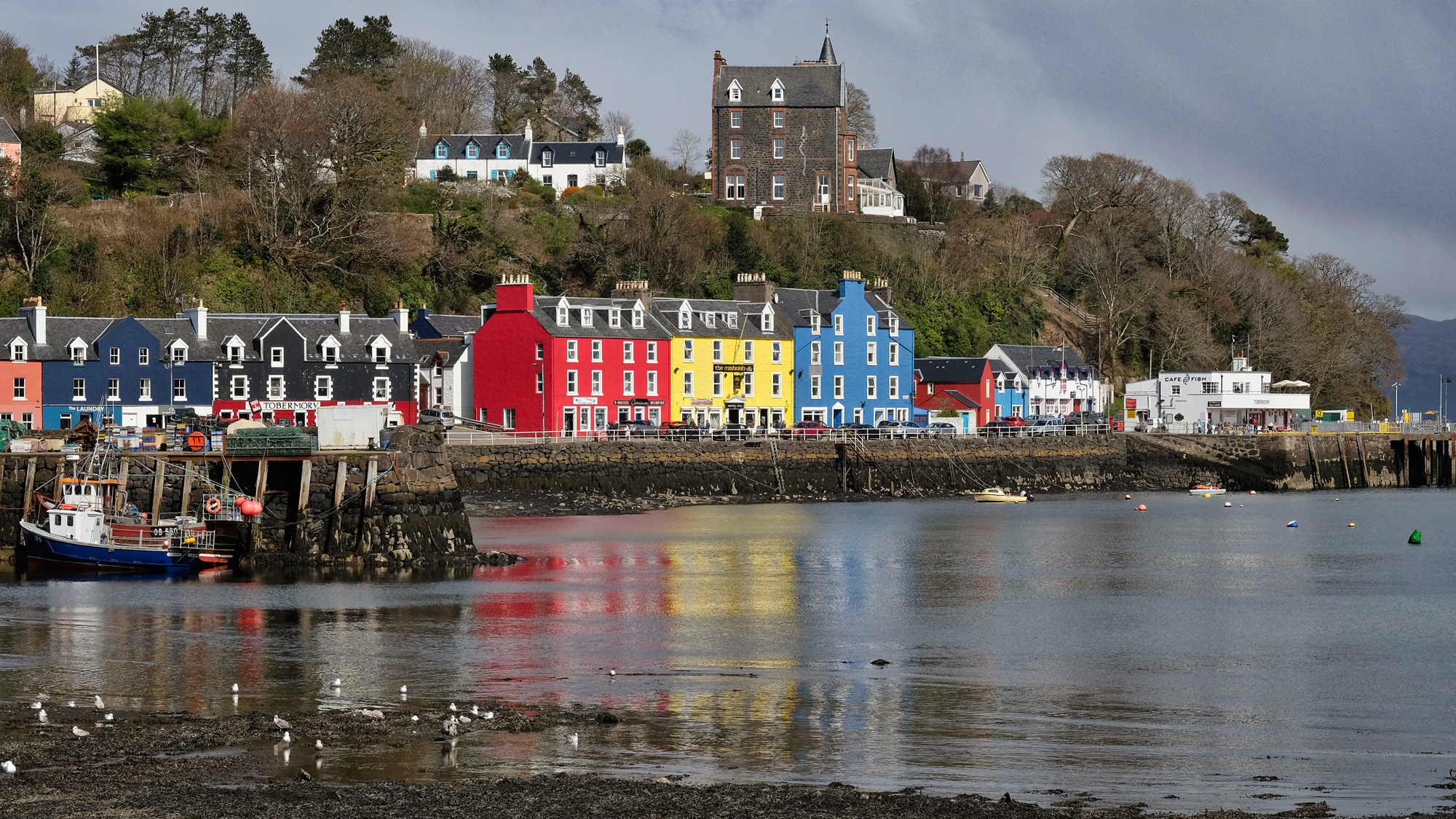 Low tide, Tobermory, Isle of Mull, Scotland. April, 2017.
Low tide, Tobermory, Isle of Mull, Scotland. April, 2017.
 Half of the harbour village of Tobermory.
Half of the harbour village of Tobermory.
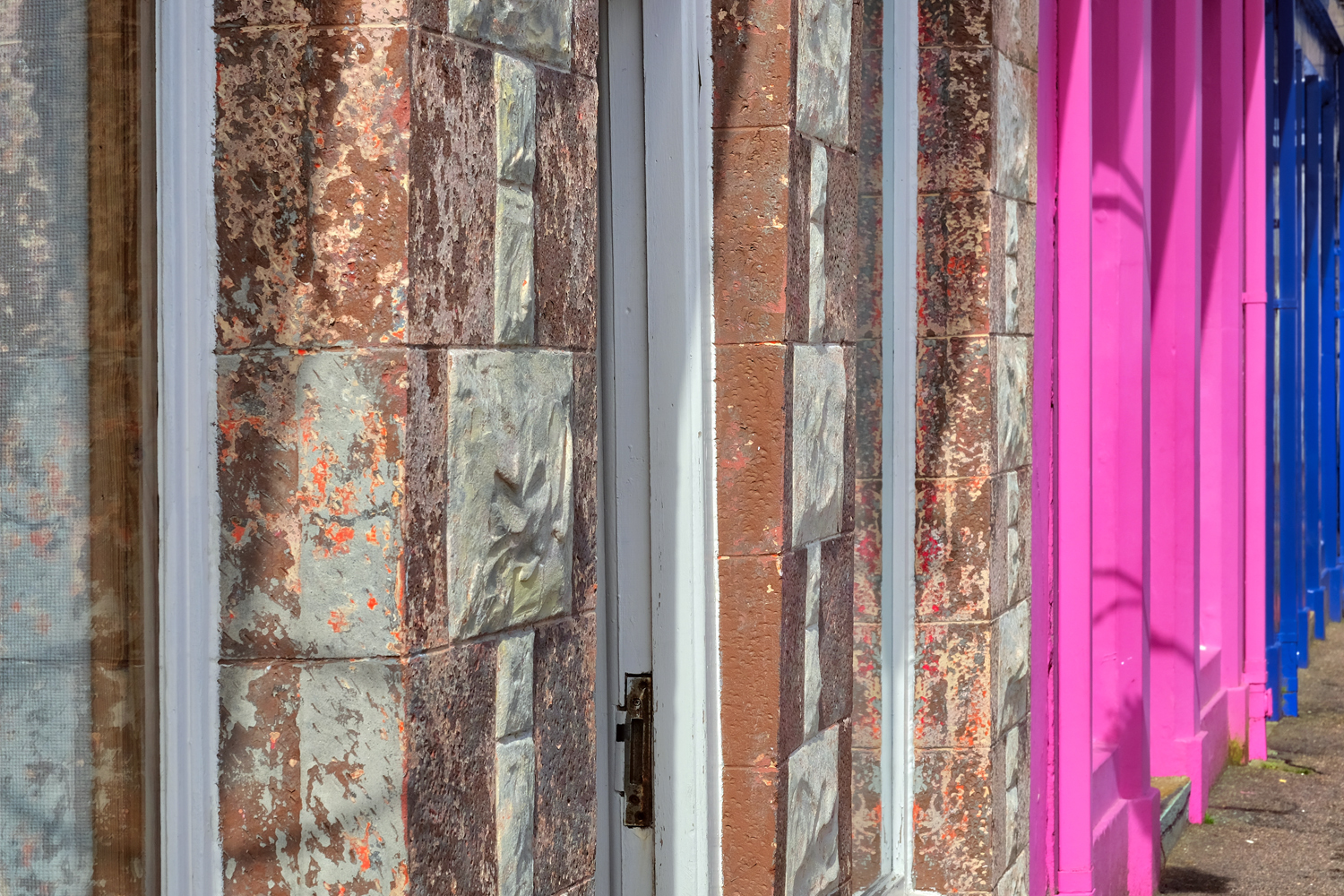 Walls along the colorful streets of Tobermory.
Walls along the colorful streets of Tobermory.
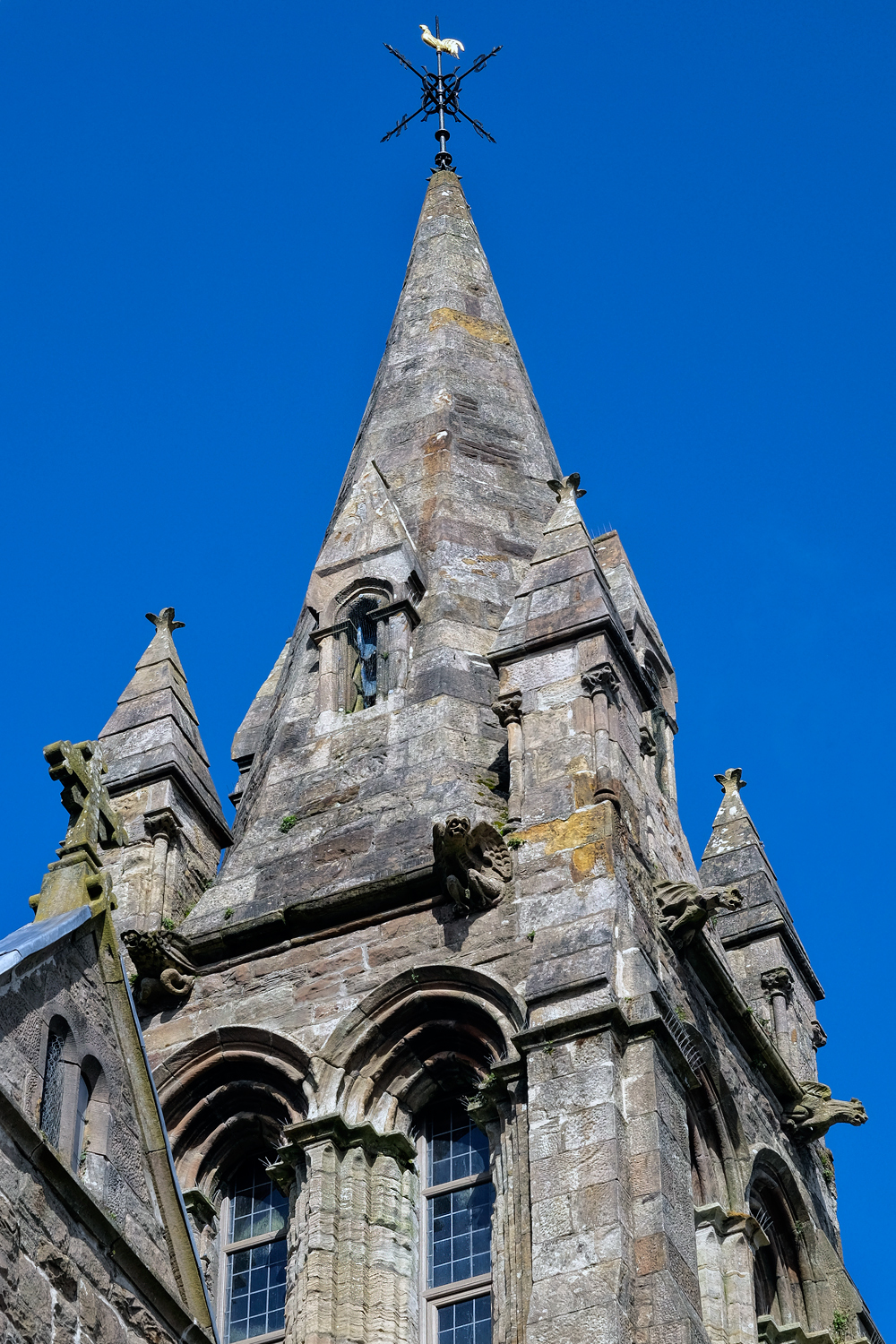 The old Tobermory church steeple against a perfect blue sky . . . in the western isles of Scotland . . . in April. Impossible.
The old Tobermory church steeple against a perfect blue sky . . . in the western isles of Scotland . . . in April. Impossible.
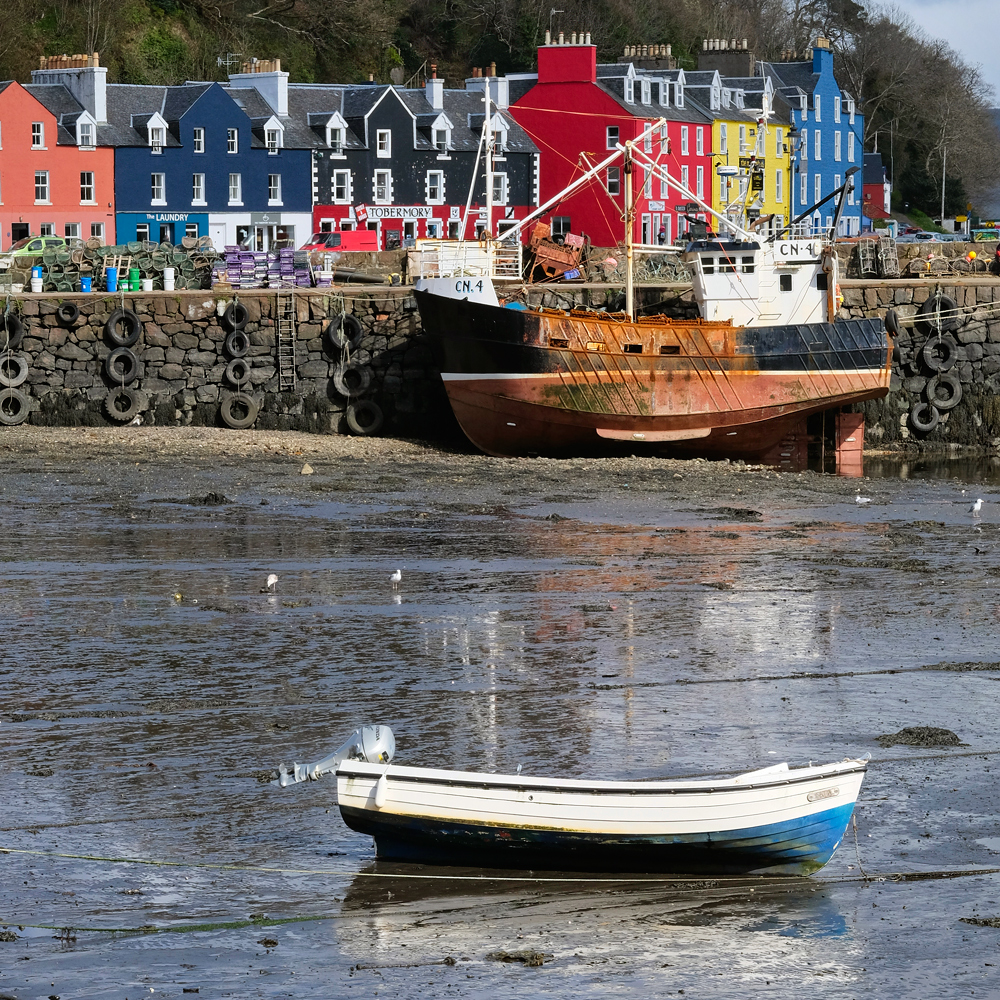 I never tire of this view.
I never tire of this view.
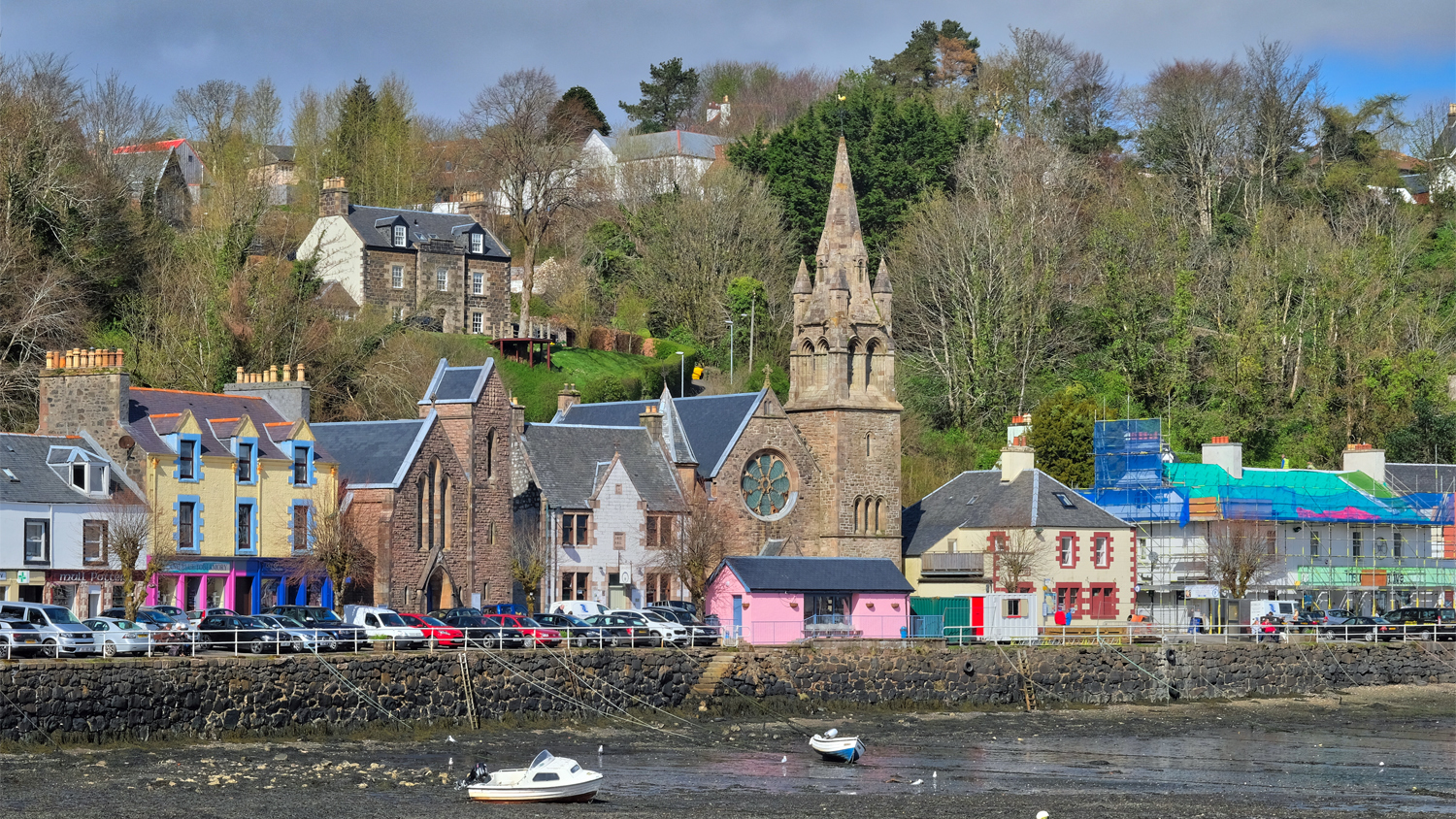 The small pink shed next to the harbour sold excellent ice cream. Our B&B was on the hill above the village.
The small pink shed next to the harbour sold excellent ice cream. Our B&B was on the hill above the village.
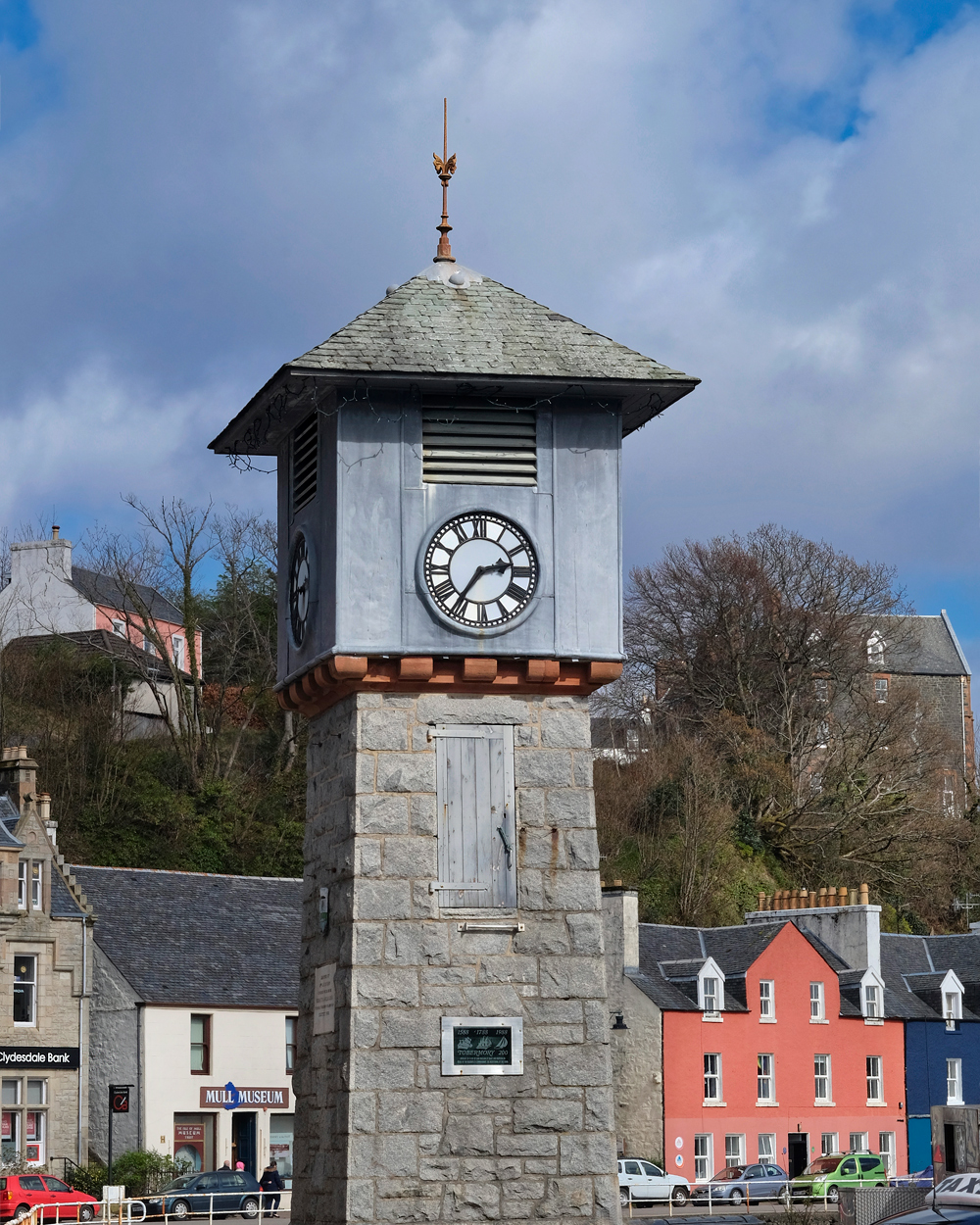 The old Tobermory town clock.
The old Tobermory town clock.
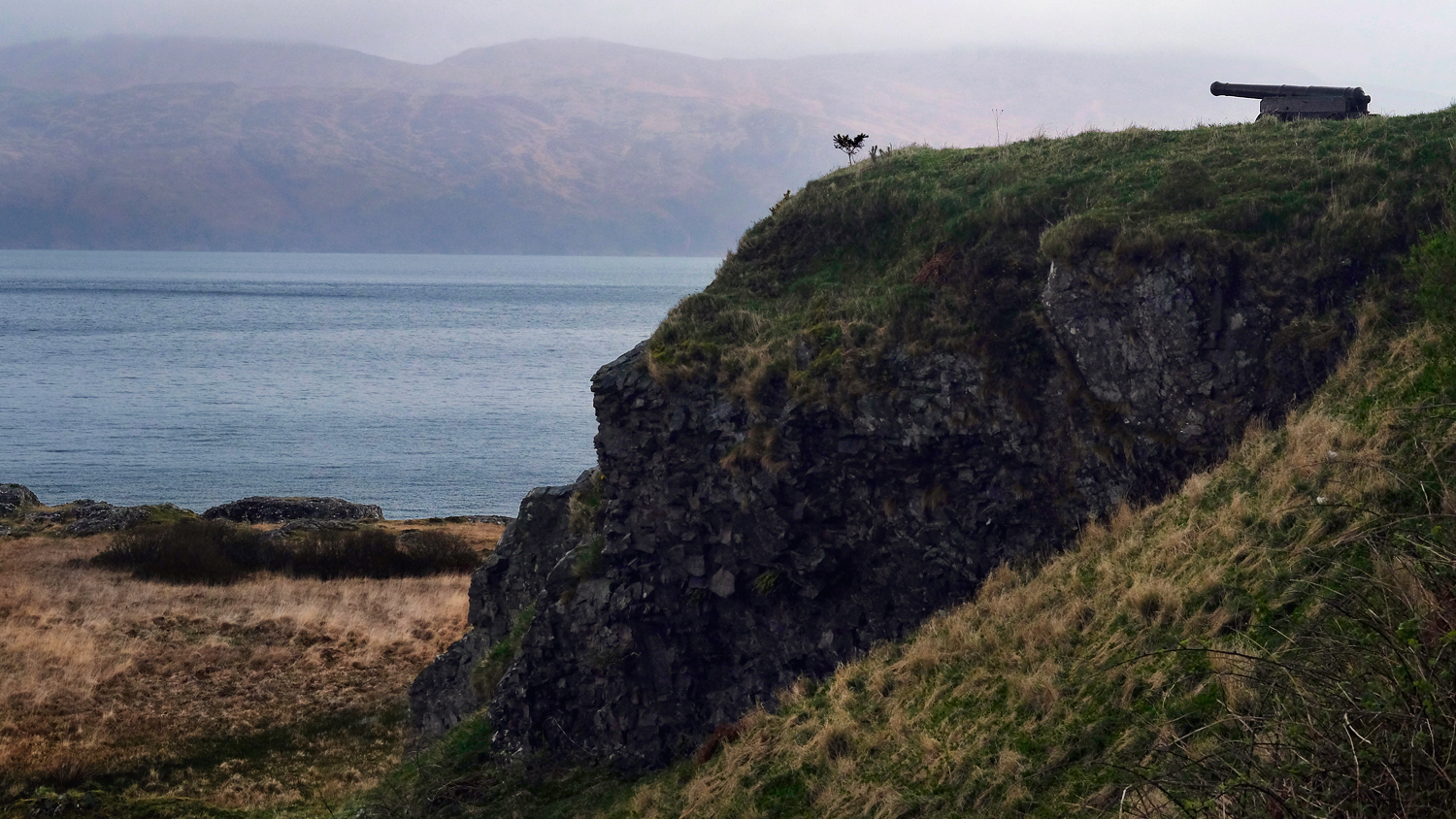 History marks itself.
History marks itself.
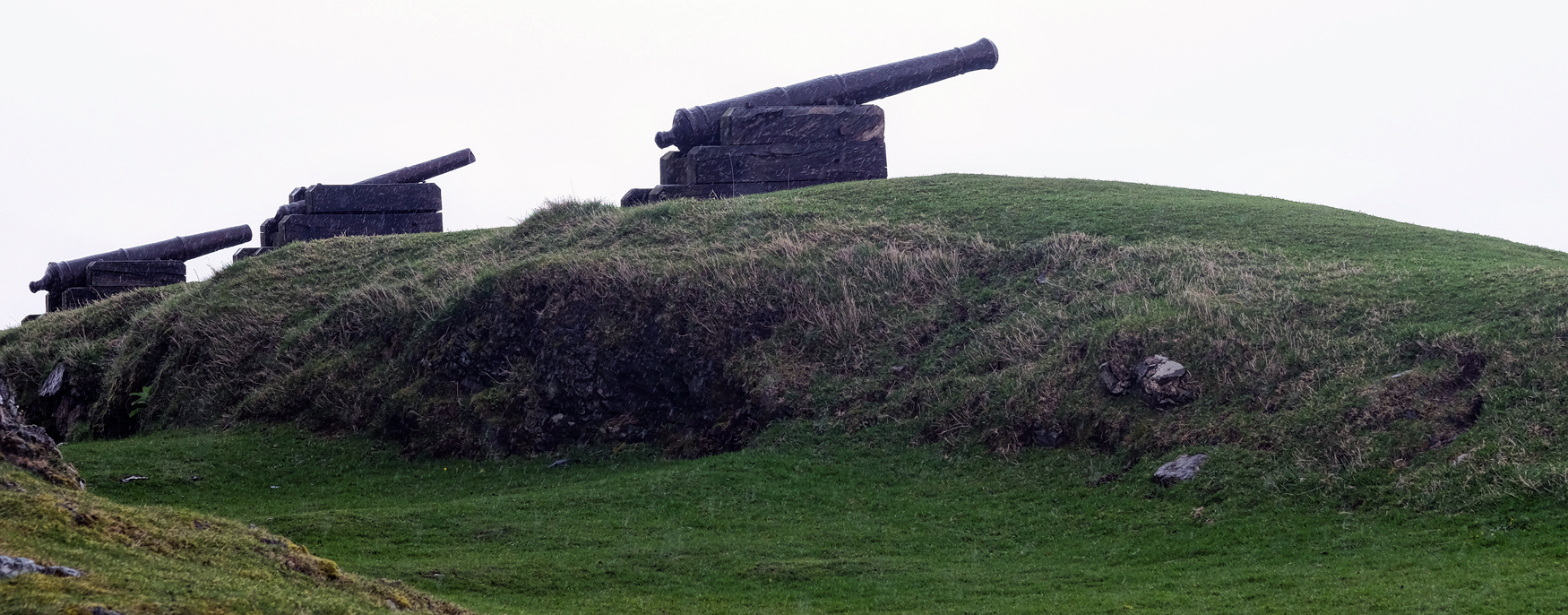 Ancient battles fought and castles defended near here.
Ancient battles fought and castles defended near here.
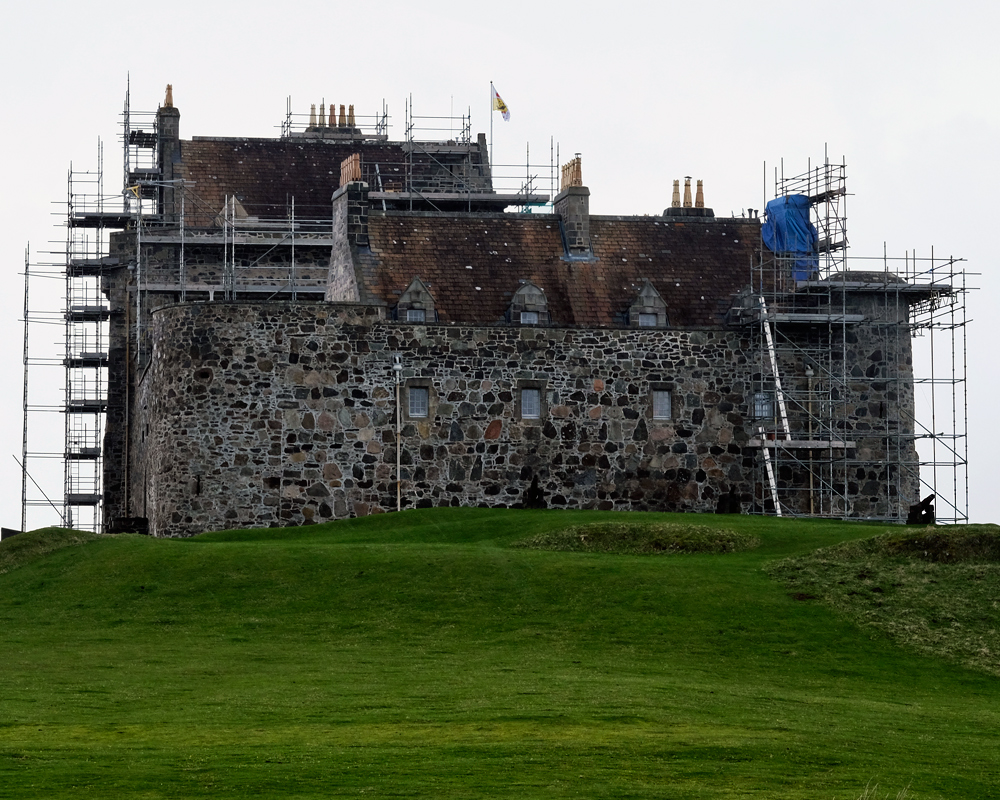 Castle Duart (c1350) under renovation.
Castle Duart (c1350) under renovation.
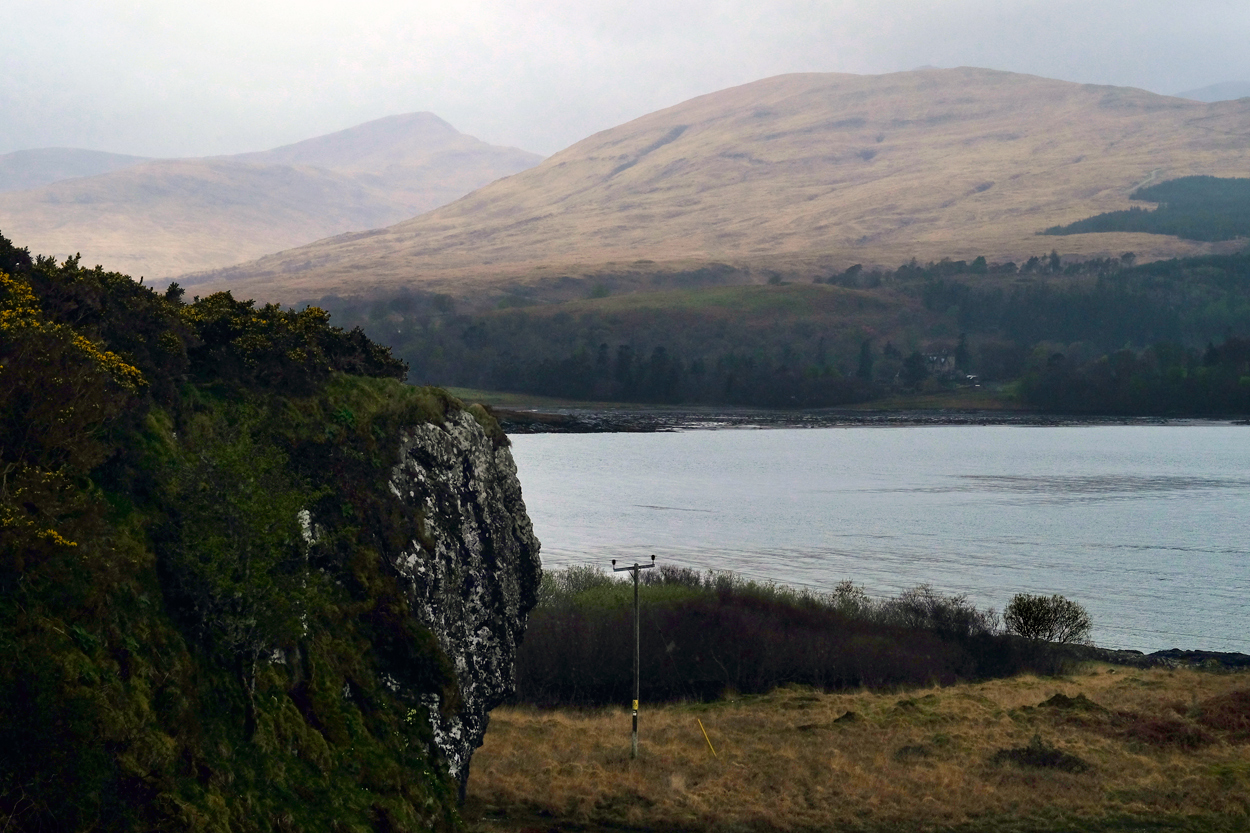 The atmospheric view from Castle Duart on a cold, rainy day on the Isle of Mull.
The atmospheric view from Castle Duart on a cold, rainy day on the Isle of Mull.
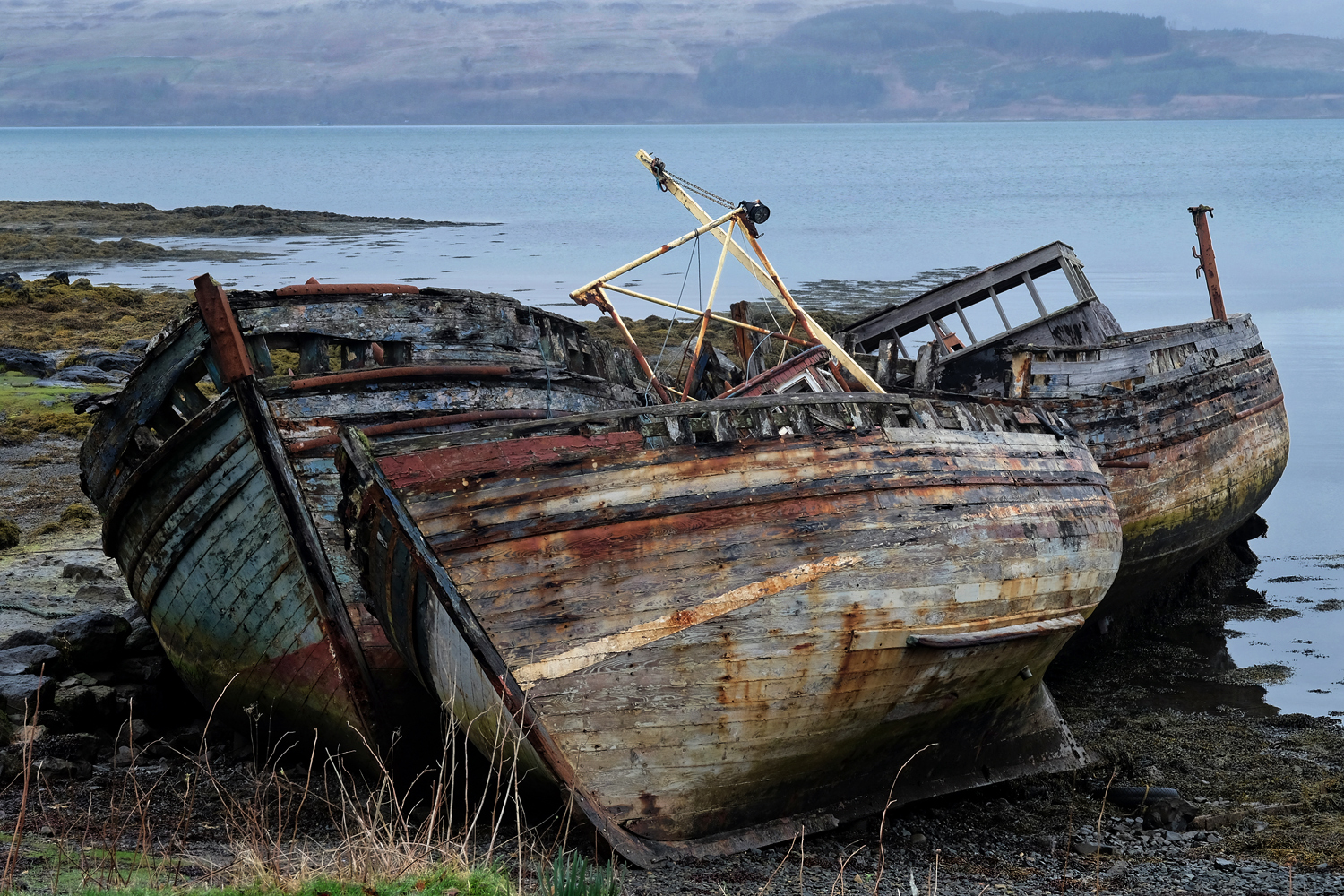 Then, around a bend . . . . a photographer's dream come true!
Then, around a bend . . . . a photographer's dream come true!
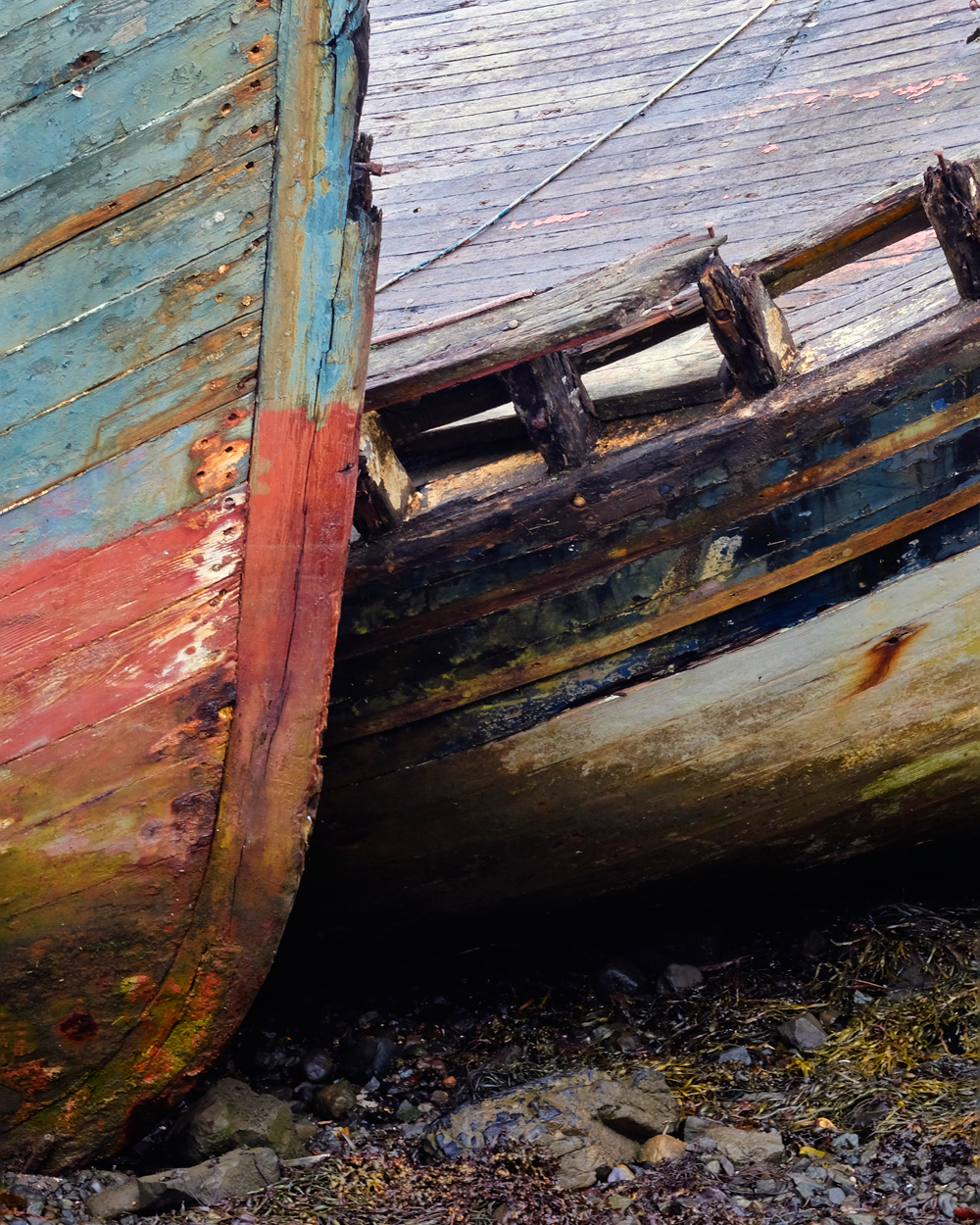 Fantastic patina of age and deterioration.
Fantastic patina of age and deterioration.
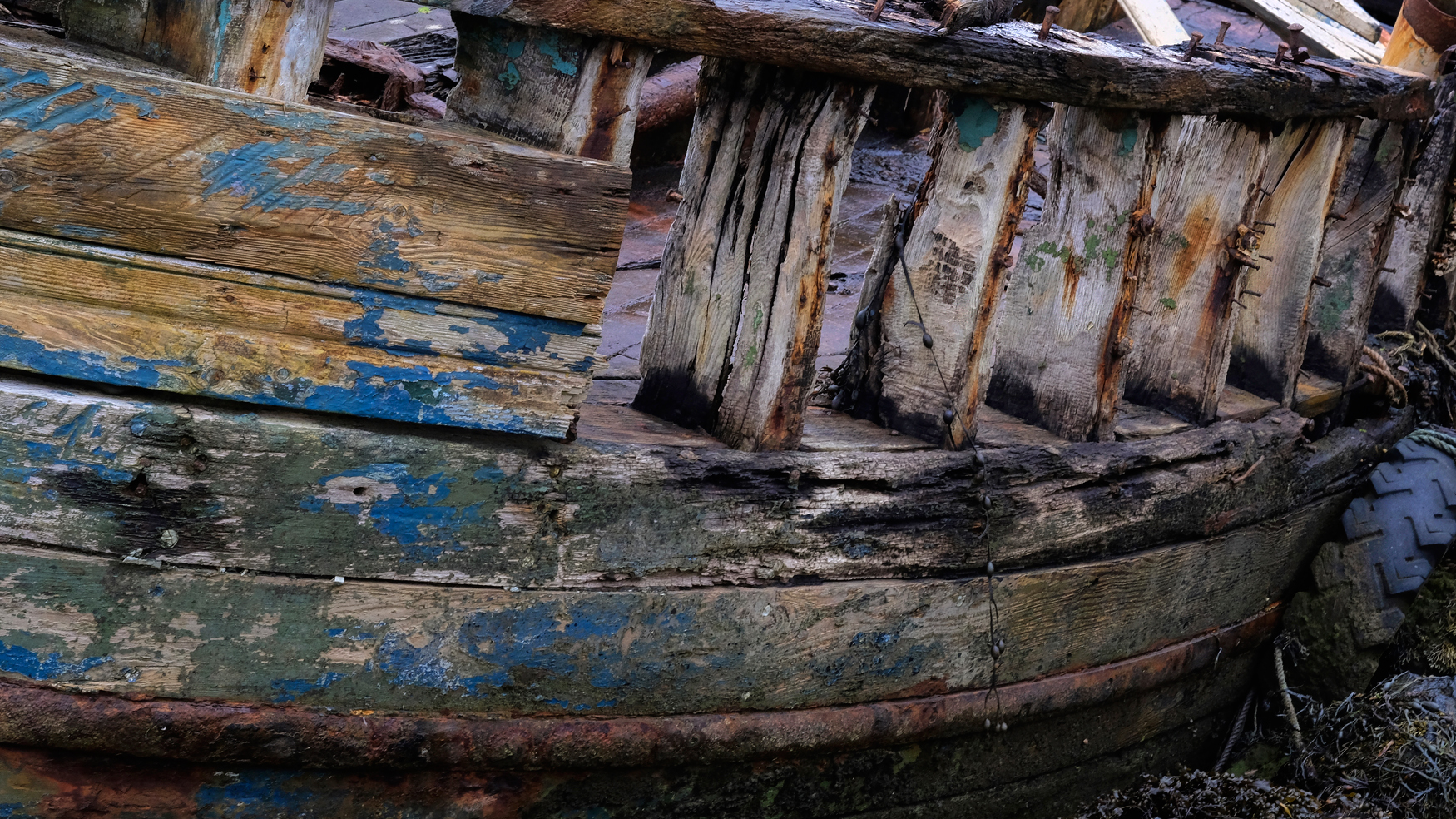 Abandoned after years of service.
Abandoned after years of service.
 There are no bad light days in photography . . . .
There are no bad light days in photography . . . .
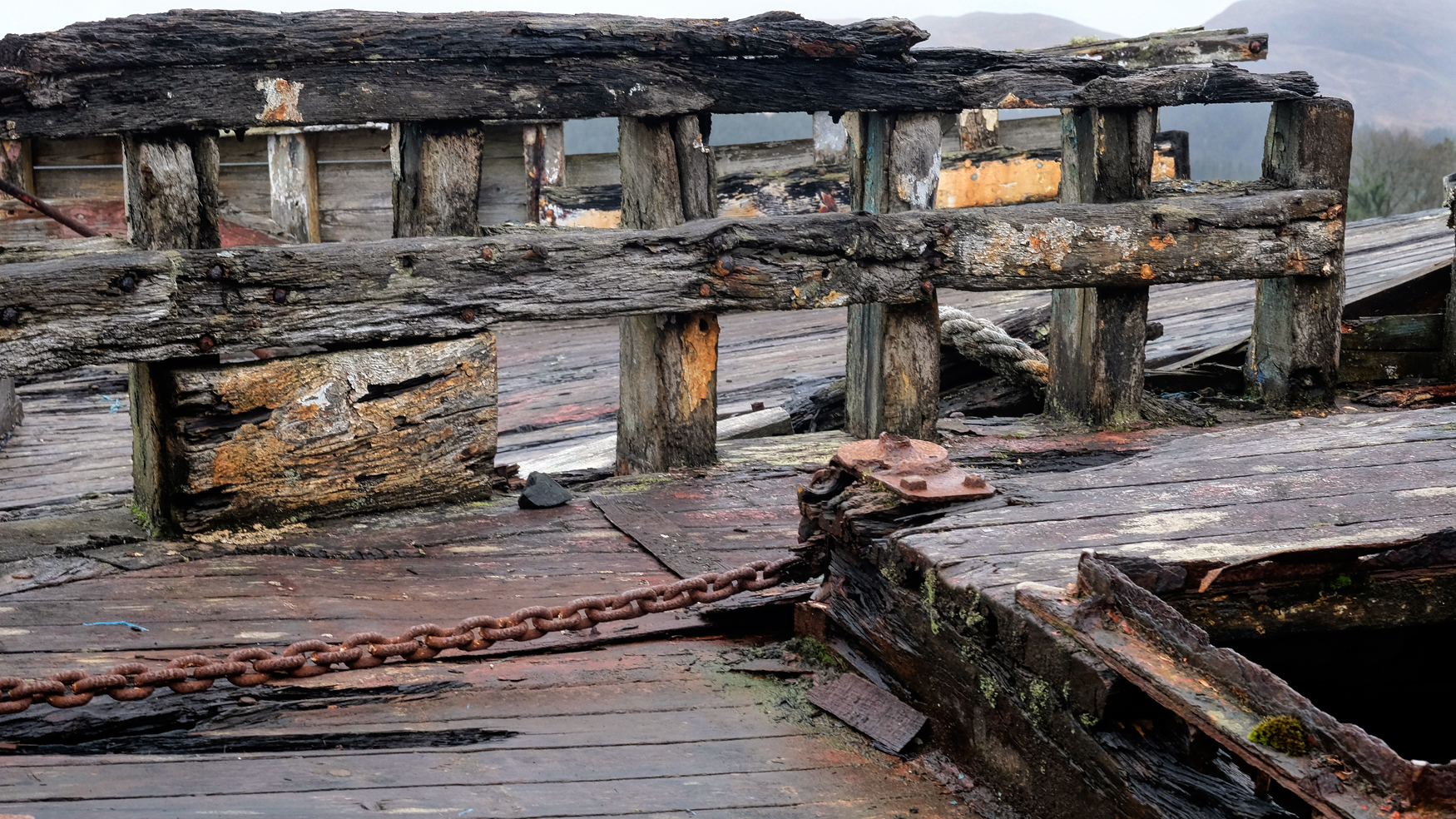 Not too long before this ship completely disappears. I wonder if this is an Aberdeen Trawler.
Not too long before this ship completely disappears. I wonder if this is an Aberdeen Trawler.
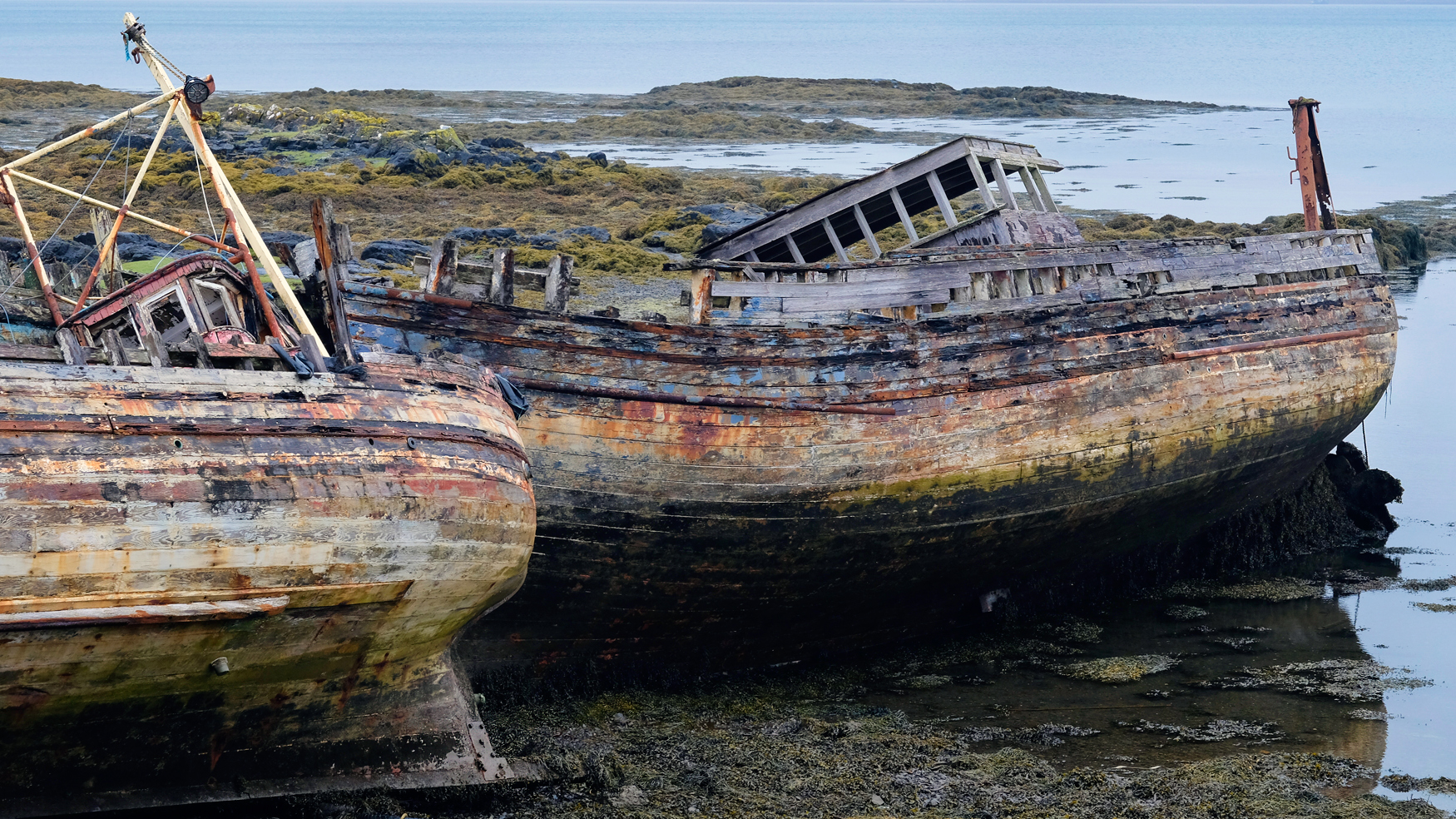 Three old fishing trawlers abandoned.
Three old fishing trawlers abandoned.
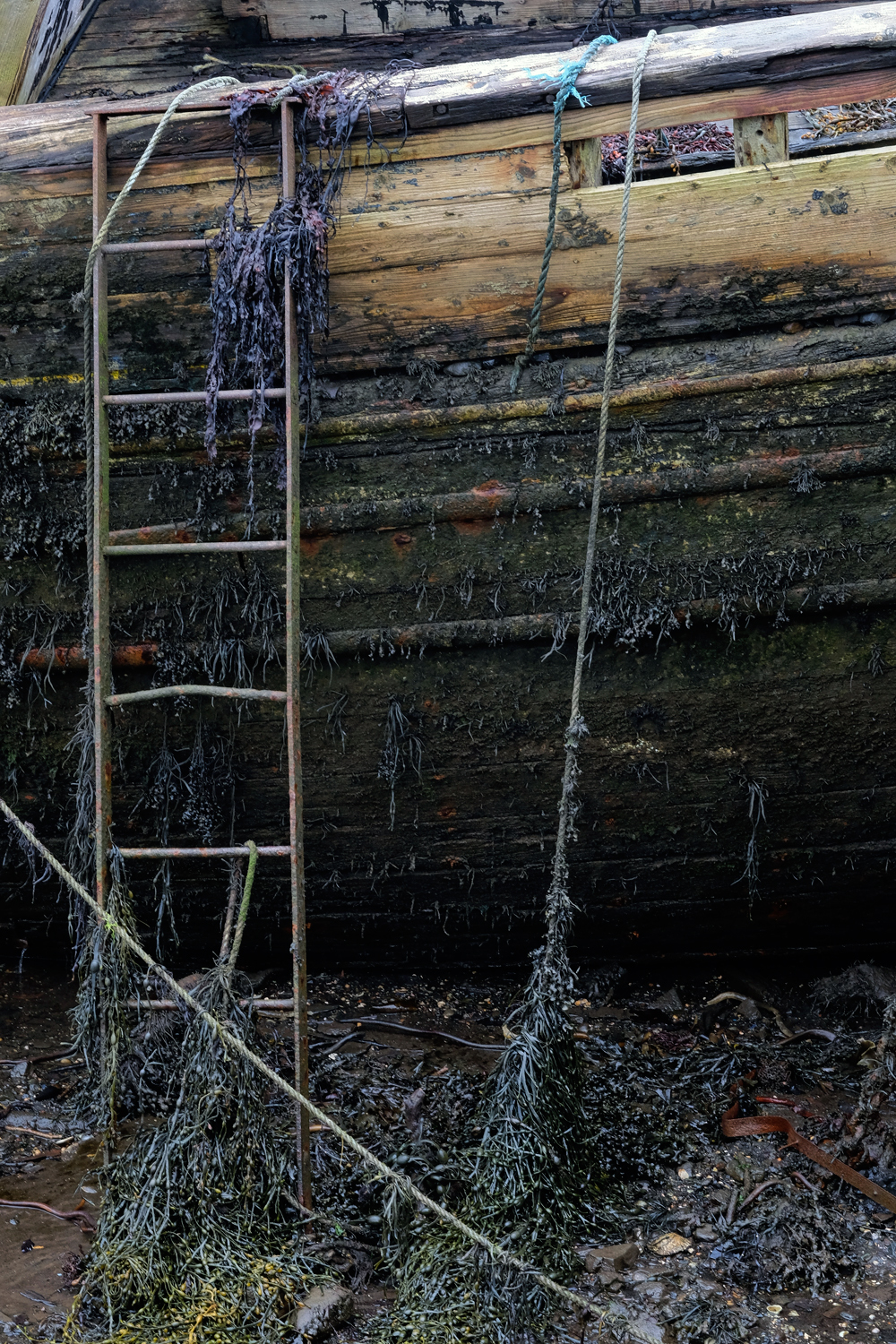 Nature taking over.
Nature taking over.
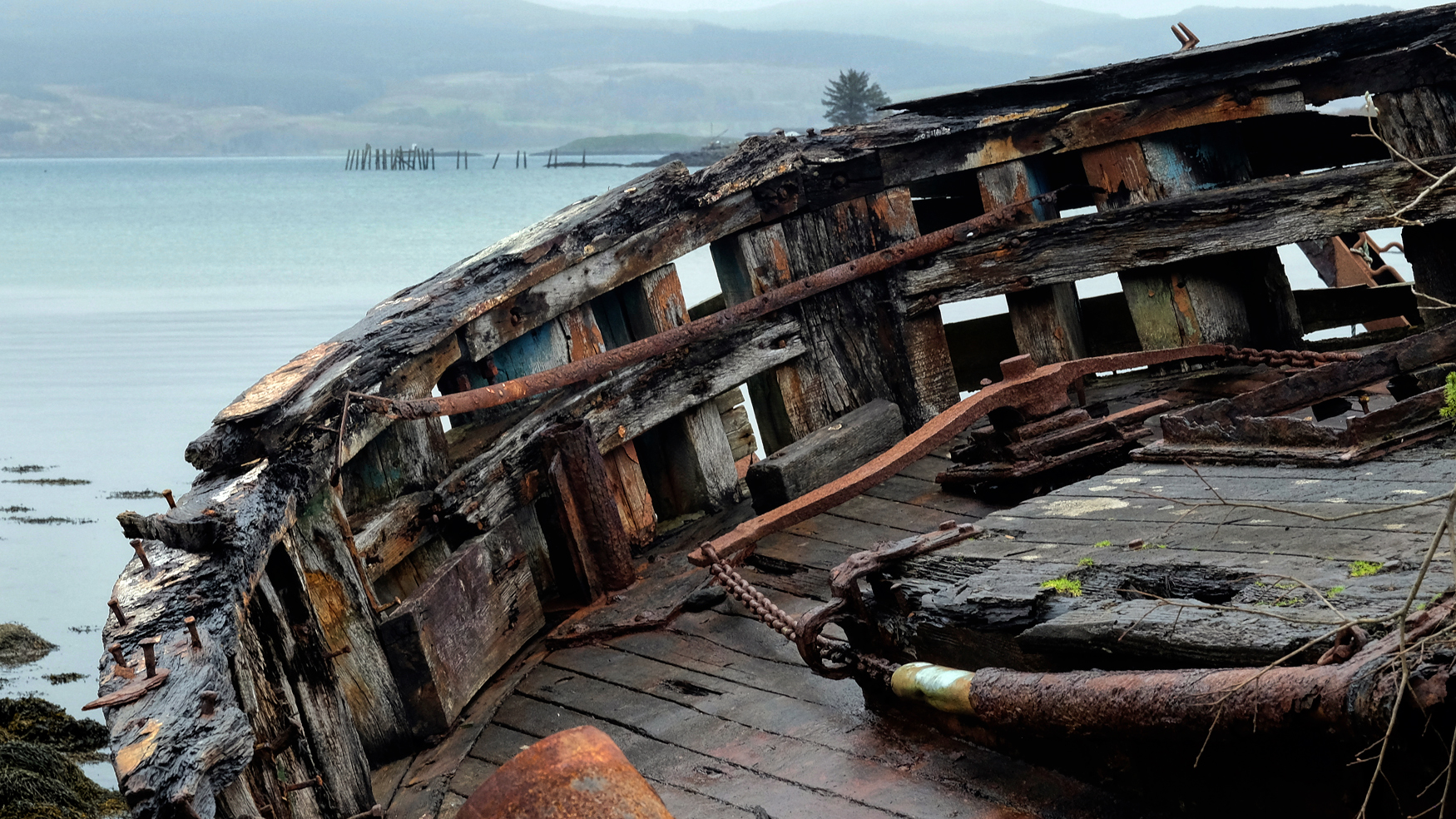 Fishermen worked these decks for how long?
Fishermen worked these decks for how long?
 Always a view of sea and rising hills.
Always a view of sea and rising hills.
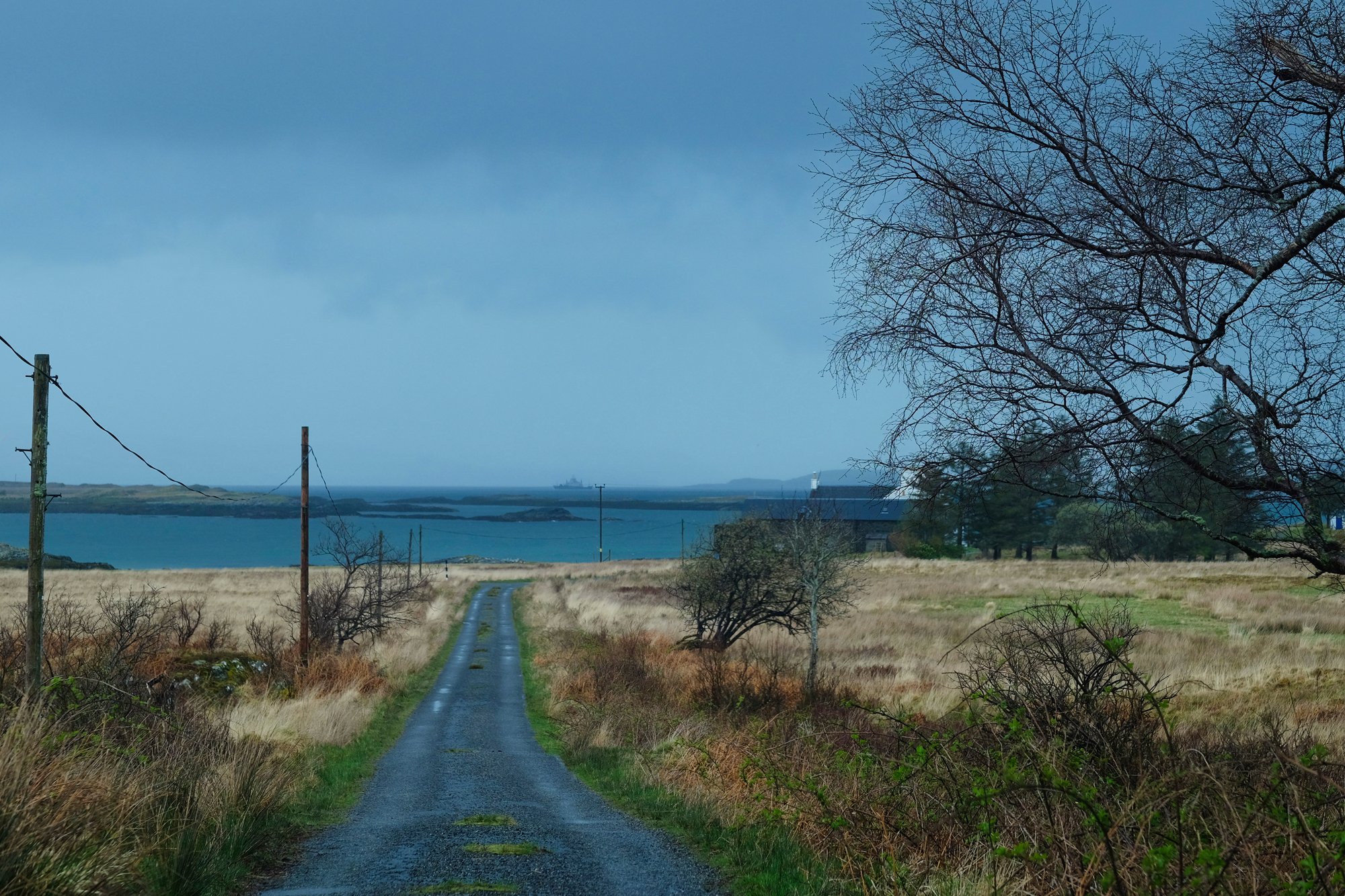 On another day . . . sun and blue sky along the tiny roads . . .
On another day . . . sun and blue sky along the tiny roads . . .
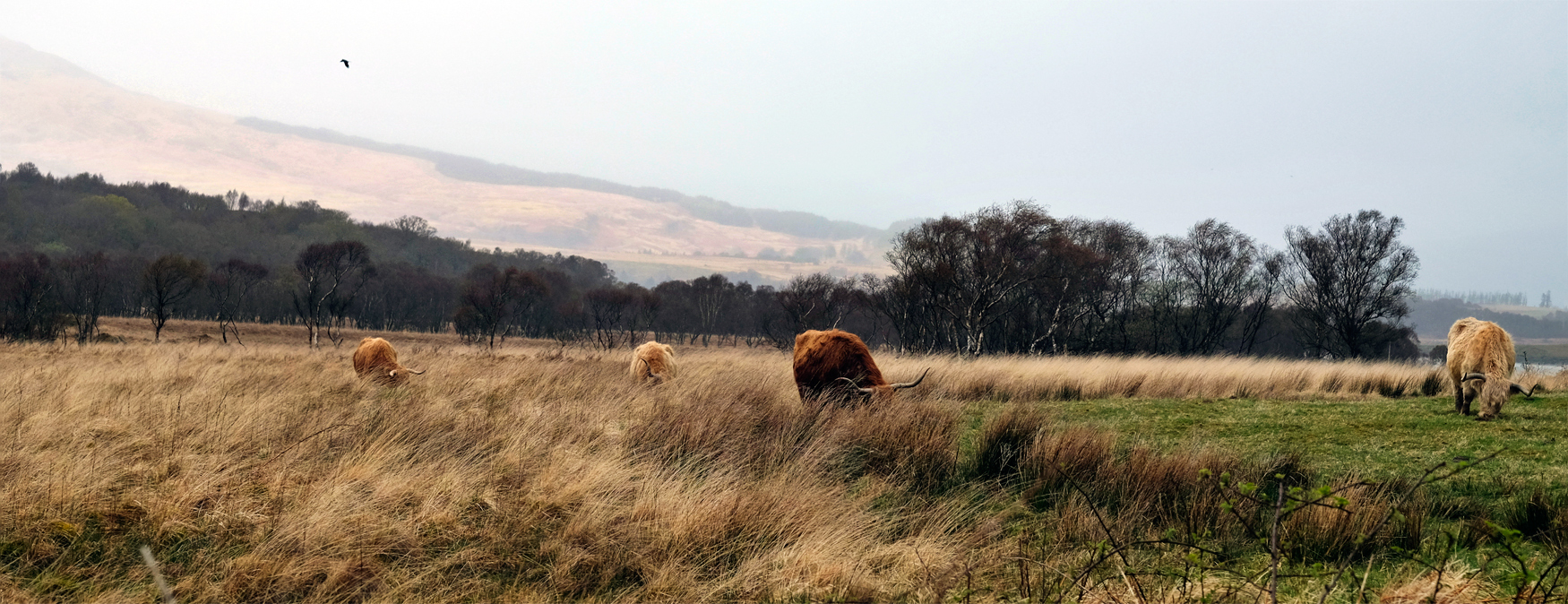 Cattle and sheep augment the fishing industries of Mull. These are Highland cows.
Cattle and sheep augment the fishing industries of Mull. These are Highland cows.
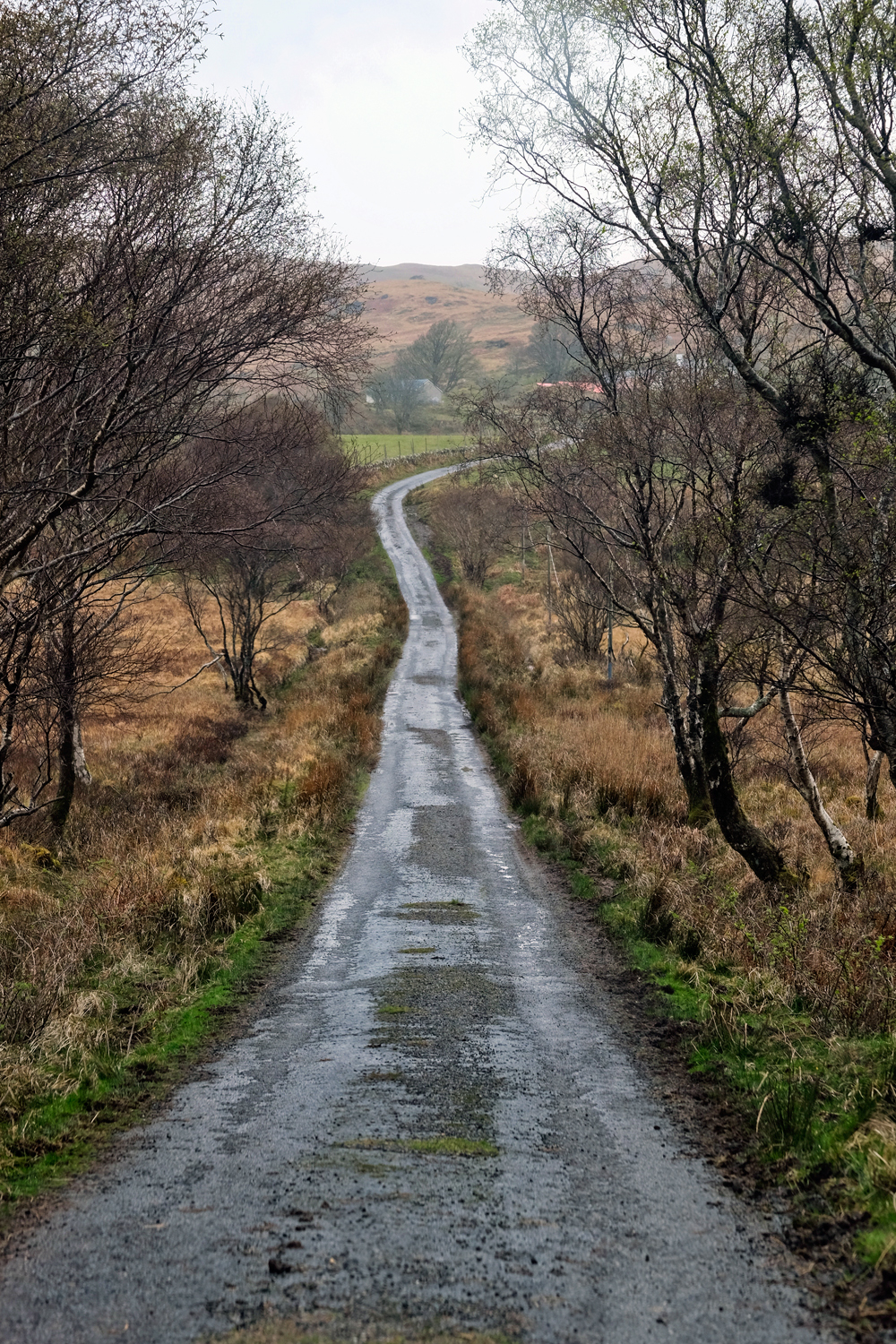 We meandered along these small roads using Google maps to guide us to points of interest.
We meandered along these small roads using Google maps to guide us to points of interest.
 After a long drive in the rain on tiny roads, we reached a small valley rimmed with low clouds and this austere church.
After a long drive in the rain on tiny roads, we reached a small valley rimmed with low clouds and this austere church.
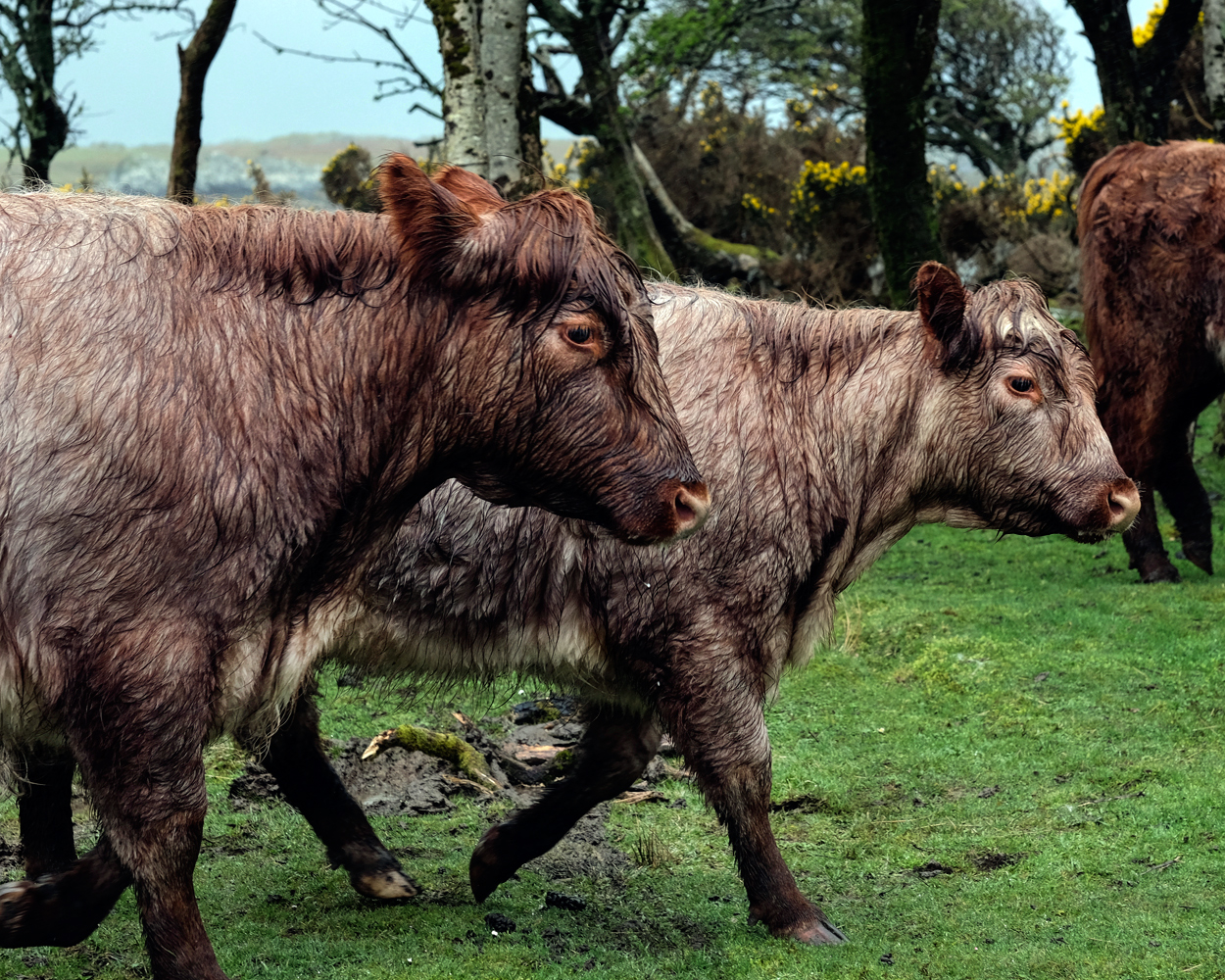 The rain came and went on all days. These cattle were very wet!
The rain came and went on all days. These cattle were very wet!
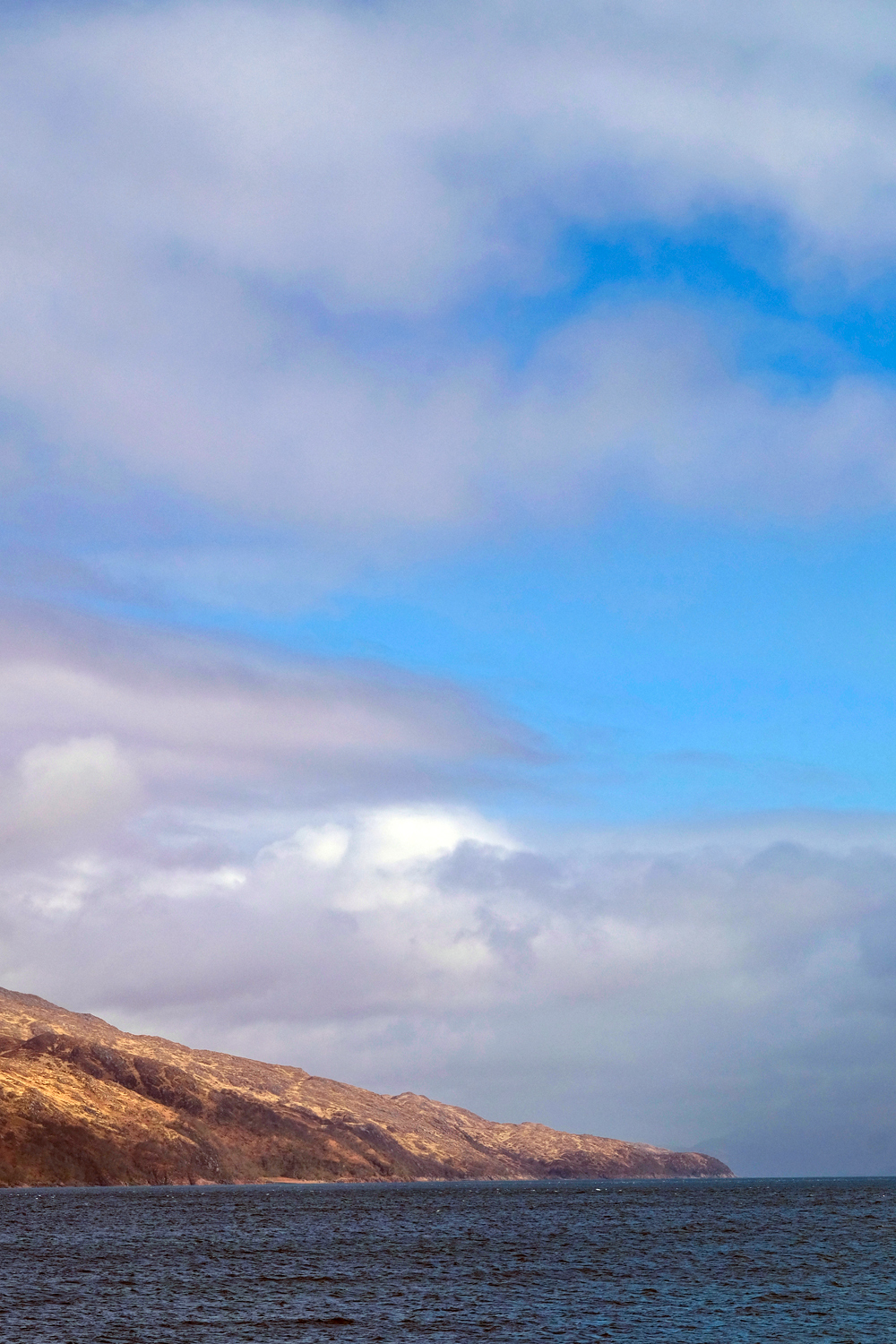 The morning we were leaving the Isle of Mull the weather turned wonderful . . . of course!
The morning we were leaving the Isle of Mull the weather turned wonderful . . . of course!
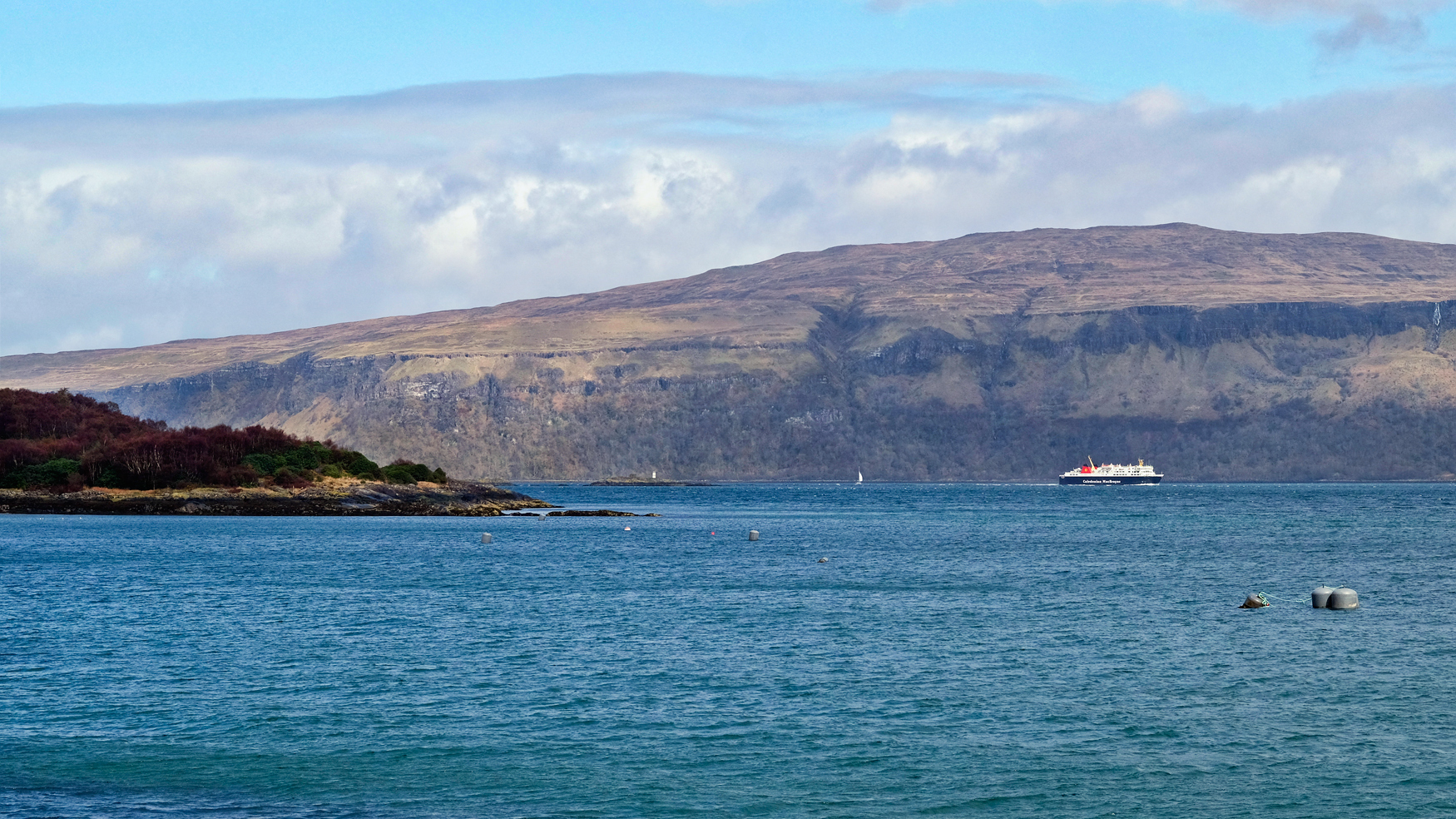 Ships to and from the Outer Hebrides pass through the Sound of Mull. We took one of these ferries there last year.
Ships to and from the Outer Hebrides pass through the Sound of Mull. We took one of these ferries there last year.
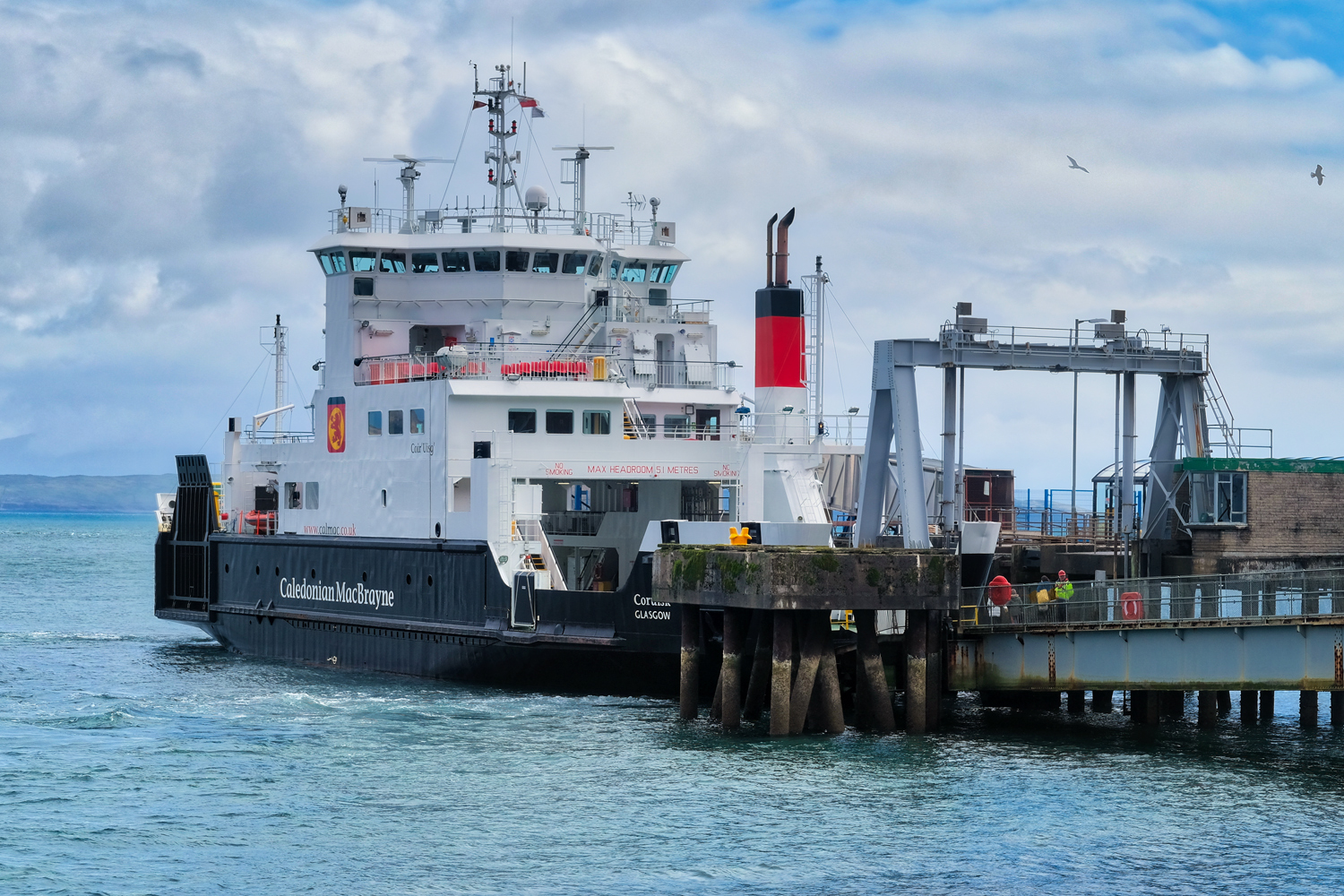 We boarded our ferry back to Oban on a beautiful morning.
We boarded our ferry back to Oban on a beautiful morning.
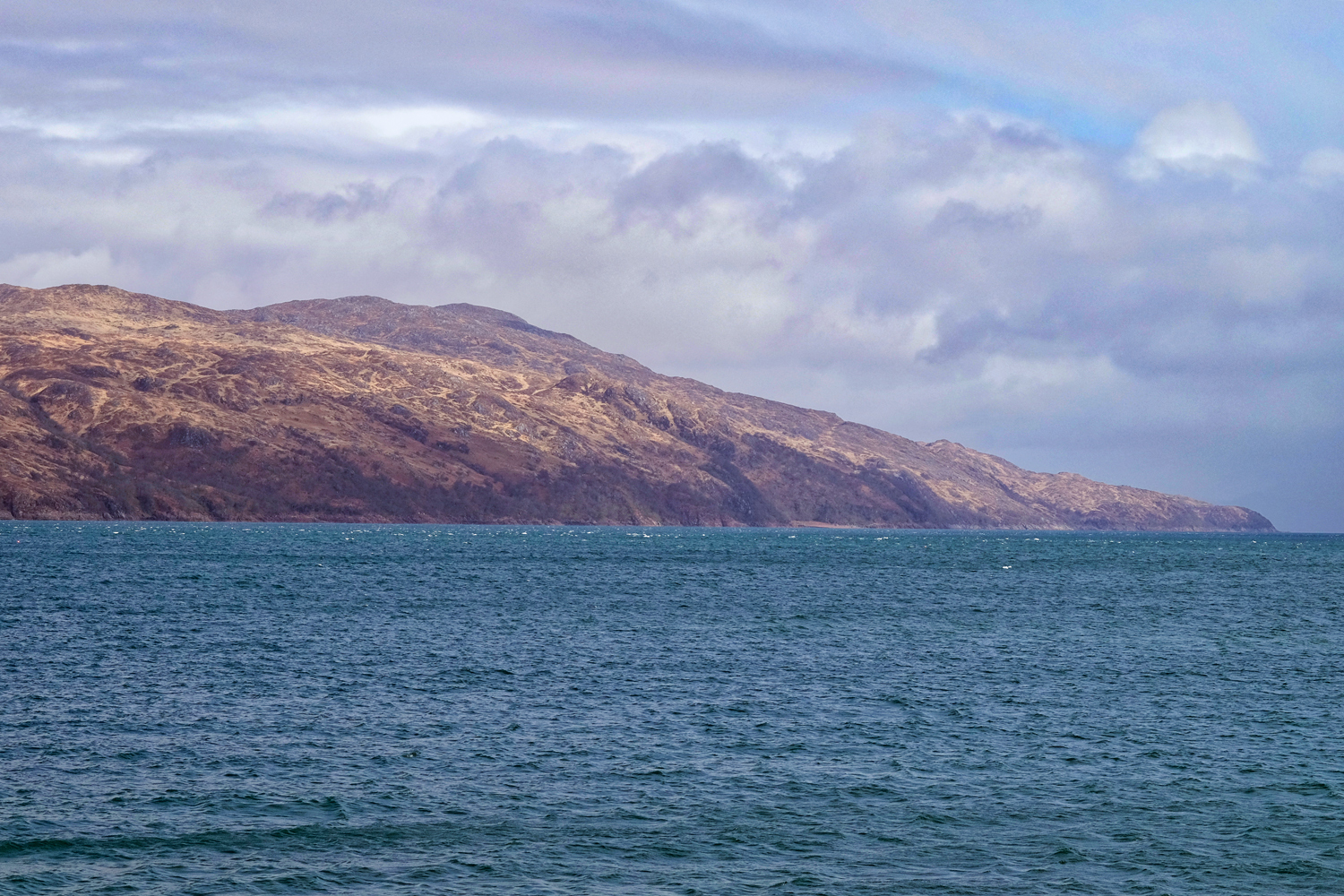 It was a smooth passage home.
It was a smooth passage home.
Scotland Coastal Villages - Banff and MacDuff
 Tuesday, June 21, 2016 at 4:21AM
Tuesday, June 21, 2016 at 4:21AM  Here I am again . . . tagging along with my wife on her golf tournament. I dropped her off at Duff House Royal Golf Club and set off for a little photographic expedition to the coastal villeges nearby: Banff and MacDuff. This is the village center of Banff.
Here I am again . . . tagging along with my wife on her golf tournament. I dropped her off at Duff House Royal Golf Club and set off for a little photographic expedition to the coastal villeges nearby: Banff and MacDuff. This is the village center of Banff.
 Banff is a very old village. It had its first castle in 1163, build to repel the invading Vikings.
Banff is a very old village. It had its first castle in 1163, build to repel the invading Vikings.
 Banff is a more prosperous village. It was a trading center until the 1770s, when a port was constructed.
Banff is a more prosperous village. It was a trading center until the 1770s, when a port was constructed.
 Banff is built up the side of a rather steel hill that rises up from a broad bay. There are still narrow walking paths that give the only access to quaint cottages.
Banff is built up the side of a rather steel hill that rises up from a broad bay. There are still narrow walking paths that give the only access to quaint cottages.
 A typical 17th century house in Banff.
A typical 17th century house in Banff.
 Banff is a lovely village. It is just big enough to offer all the amenities, but small enough to still feel like a village. I could see living in this house (it's for sale) on street off the bay.
Banff is a lovely village. It is just big enough to offer all the amenities, but small enough to still feel like a village. I could see living in this house (it's for sale) on street off the bay.
 There are a couple of scaled-down 'supermarkets' in Banff, but the downtown is still vibrant, owing to the fact that the nearest mall is 50 miles away.
There are a couple of scaled-down 'supermarkets' in Banff, but the downtown is still vibrant, owing to the fact that the nearest mall is 50 miles away.
 There are several quaint old hotels in town.
There are several quaint old hotels in town.
 I couldn't resist snooping around the fascinating old cemetery . . . right in the middle of the village.
I couldn't resist snooping around the fascinating old cemetery . . . right in the middle of the village.
 I come from a very wet place (Western Oregon in the USA), so I understand this kind of moss.
I come from a very wet place (Western Oregon in the USA), so I understand this kind of moss.
 There were several extraordinary crypts and carved grave covers.
There were several extraordinary crypts and carved grave covers.
 Just so your survivors wouldn't have to wonder what happened to you . . . you put a skull and bones on your grave marker. [Note to self: do not have horizontal grave stone in rainy environment.]
Just so your survivors wouldn't have to wonder what happened to you . . . you put a skull and bones on your grave marker. [Note to self: do not have horizontal grave stone in rainy environment.]
 I decided to walk back through old town Banff toward the sea and the jetty. These are the oldest continuously inhabited buildings in Banff, dating from the mid-14th century.
I decided to walk back through old town Banff toward the sea and the jetty. These are the oldest continuously inhabited buildings in Banff, dating from the mid-14th century.
 Being such a very old village, there were, of course, a few buildings that were in full deterioration. My favorite photo subject!
Being such a very old village, there were, of course, a few buildings that were in full deterioration. My favorite photo subject!
 House number 30.
House number 30.
 I love the story of time and weather written on these old, unattended, doors.
I love the story of time and weather written on these old, unattended, doors.
 House number 32. Nobody home.
House number 32. Nobody home.
 The sea wall at high tide. I followed the wall out to the jetty next to a raging North Sea.
The sea wall at high tide. I followed the wall out to the jetty next to a raging North Sea.
 Crabbing and shrimping pots lined the old stone jetty.
Crabbing and shrimping pots lined the old stone jetty.
 I studied these for a few minutes, imagining myself as a crab, but I couldn't work out how these thing worked.
I studied these for a few minutes, imagining myself as a crab, but I couldn't work out how these thing worked.
 View from the jetty: A broad bay separates Banff from the even smaller village of MacDuff, seen on the horizon. This is where the River Deveron estuary ends in the North Sea.
View from the jetty: A broad bay separates Banff from the even smaller village of MacDuff, seen on the horizon. This is where the River Deveron estuary ends in the North Sea.
 Ther is a small light at the end of the jetty. At high tide the waves occasionally break over sea wall.
Ther is a small light at the end of the jetty. At high tide the waves occasionally break over sea wall.
 I was getting hungry, so I took a different street back to my car. I passed this relic of days gone bye.
I was getting hungry, so I took a different street back to my car. I passed this relic of days gone bye.
 I often ask myself, what is it about old doors that compel me to take a photograph? Something about mortality, I believe.
I often ask myself, what is it about old doors that compel me to take a photograph? Something about mortality, I believe.
 I made my way back to the village center and then on up the steep hill to a nice cafe and had a bowl of Cullen Skink, a scone, and a cup of coffee.
I made my way back to the village center and then on up the steep hill to a nice cafe and had a bowl of Cullen Skink, a scone, and a cup of coffee.
 After lunch I decided to find the castle whose sign I saw driving in. My GPS said there was a castle only four miles away. I ended up on this gravel road through a beautiful wood.
After lunch I decided to find the castle whose sign I saw driving in. My GPS said there was a castle only four miles away. I ended up on this gravel road through a beautiful wood.
 I knew I was getting close to a castle when I started to see the old outbuildings.
I knew I was getting close to a castle when I started to see the old outbuildings.
 I love these old abandoned stone houses. I have a fantasy each time of fixing it up and living in it.
I love these old abandoned stone houses. I have a fantasy each time of fixing it up and living in it.
 Now I knew I was getting close . . . a castle gate house . . . and occupied too.
Now I knew I was getting close . . . a castle gate house . . . and occupied too.
 AH! There it is. A castle through the trees. I was not sure if this particular castle was occupied by the laird, or was open to the public. I was a little concerned someone would run our and yell at me that I was trespassing.
AH! There it is. A castle through the trees. I was not sure if this particular castle was occupied by the laird, or was open to the public. I was a little concerned someone would run our and yell at me that I was trespassing.
 I stayed back in the trees, just in case . . .
I stayed back in the trees, just in case . . .
 Magnificent and stately Craigston Castle, built in 1604. As it turns out, you can stay in this castle as a "luxury self-catering vacation home." No kidding. You can make a booking here.
Magnificent and stately Craigston Castle, built in 1604. As it turns out, you can stay in this castle as a "luxury self-catering vacation home." No kidding. You can make a booking here.
 I left the castle for a short drive to the harbour village of MacDuff. We stayed in this village right after we moved to Scotland. In fact, it was the first over night stay we made.
I left the castle for a short drive to the harbour village of MacDuff. We stayed in this village right after we moved to Scotland. In fact, it was the first over night stay we made.
 MacDuff has a proper shipyard for refitting fishing boats.
MacDuff has a proper shipyard for refitting fishing boats.
 Shipyards are visually intereting places. What in the world are these sharpened steel 'blades' used for? I have no idea.
Shipyards are visually intereting places. What in the world are these sharpened steel 'blades' used for? I have no idea.
 The rust was thick, but the pattern and color was captivating.
The rust was thick, but the pattern and color was captivating.
 Nice clean and newly painted fishing boats. I got lucky as the sun finally came out in the afternoon.
Nice clean and newly painted fishing boats. I got lucky as the sun finally came out in the afternoon.
 I could have stayed all day in the MacDuff shipyards, but my wife called to say her round was over. Great idea to affix these benches inside the seawall.
I could have stayed all day in the MacDuff shipyards, but my wife called to say her round was over. Great idea to affix these benches inside the seawall.
 We drove on the A947 back to Aberdeen. We passed a sign for Fyvie Castle . . . and I couldn't resist going in. My wife hadn't been before.
We drove on the A947 back to Aberdeen. We passed a sign for Fyvie Castle . . . and I couldn't resist going in. My wife hadn't been before.
 Fyvie castle is a proper castle. Built in 1211, Fyvie was the site of an open-air court held by Robert the Bruce, and Charles I lived there as a child.
Fyvie castle is a proper castle. Built in 1211, Fyvie was the site of an open-air court held by Robert the Bruce, and Charles I lived there as a child.
 Fyvie Castle was closed, but the vast grounds and gardens were opened. I will post more from the fabulous gardens soon.
Fyvie Castle was closed, but the vast grounds and gardens were opened. I will post more from the fabulous gardens soon.
Scotland - Arbroath Abbey Ruins
 Sunday, June 12, 2016 at 10:57PM
Sunday, June 12, 2016 at 10:57PM  The ruins of Arbroath Abbey (c1178) is one of the most important historical sites in Scotland. The current fishing village of Arbroath has formed aroound the ruins.
The ruins of Arbroath Abbey (c1178) is one of the most important historical sites in Scotland. The current fishing village of Arbroath has formed aroound the ruins.
 The Arbroath Abbey was the site of the signing of the Declaration of Arbroath (actual document HERE) the document proclaiming Scotland an independent nation, foreshadowing the US Declaration of `independence.
The Arbroath Abbey was the site of the signing of the Declaration of Arbroath (actual document HERE) the document proclaiming Scotland an independent nation, foreshadowing the US Declaration of `independence.
 Although the Arbroath Abbey was one of the richest, it was closed at the Reformation, and from 1590 on, it was robbed of its stones by local builders.
Although the Arbroath Abbey was one of the richest, it was closed at the Reformation, and from 1590 on, it was robbed of its stones by local builders.
 The cathedral at the abbey was huge.
The cathedral at the abbey was huge.
 Wonderful olde world passages and twisting stairwells.
Wonderful olde world passages and twisting stairwells.
 I would love to have seen the Abbey when it was in all its pristine beauty.
I would love to have seen the Abbey when it was in all its pristine beauty.
 The Abbey was constructed of red sandstone, a somewhat unique building material from the time.
The Abbey was constructed of red sandstone, a somewhat unique building material from the time.
 Not all of the structures were completely destroyed.
Not all of the structures were completely destroyed.
 The magnificent Abbots House, also of red sandstone - very red because of the rain. That door going under the house sure looks inviting . . .
The magnificent Abbots House, also of red sandstone - very red because of the rain. That door going under the house sure looks inviting . . .
 The vaults under the Abbots House . . . this tourist came in while I was shooting . . . and stayed very still.
The vaults under the Abbots House . . . this tourist came in while I was shooting . . . and stayed very still.
 Some of the 'extra' archeological finds are displayed in the basement of the Abbots House.
Some of the 'extra' archeological finds are displayed in the basement of the Abbots House.
 The ghostly green light, the other-worldly sounds, and the strange light emanating from behind this door were enough to inhibit further exploration . . . . so I left.
The ghostly green light, the other-worldly sounds, and the strange light emanating from behind this door were enough to inhibit further exploration . . . . so I left.
 There were several high vantage points to view the lay-out of the original Abbey. The main chapel must have been very grand, as the huge column bases indicate.
There were several high vantage points to view the lay-out of the original Abbey. The main chapel must have been very grand, as the huge column bases indicate.
 I left my shoes in this photo . . . on the Stairwell Unto Hell . . .
I left my shoes in this photo . . . on the Stairwell Unto Hell . . .
 I'm a sucker for photos framed by arches. Guilty as charged . . .
I'm a sucker for photos framed by arches. Guilty as charged . . .
 I also enjoy photographing doors . . . all over the world. They are the portals to an enclosure; an enclosure of that which is on the other side.
I also enjoy photographing doors . . . all over the world. They are the portals to an enclosure; an enclosure of that which is on the other side.
 I wandered into this chamber and discovered a very informative exhibit about the signing of the Declaration of Arbroath (document and translation HERE), signed on 6 April, 1320, which declared Scotland independence.
I wandered into this chamber and discovered a very informative exhibit about the signing of the Declaration of Arbroath (document and translation HERE), signed on 6 April, 1320, which declared Scotland independence.
 Wonderful medieval atmosphere in here . . . the literal home of freedom.
Wonderful medieval atmosphere in here . . . the literal home of freedom.
 I enjoyed wandering around in these old spaces. I had the whole place to myself.
I enjoyed wandering around in these old spaces. I had the whole place to myself.
 . . . if these walls could talk . . .
. . . if these walls could talk . . .
 I was surprised to find this apparition had appeared on a photo I took under the Abbey . . . who is this guy?
I was surprised to find this apparition had appeared on a photo I took under the Abbey . . . who is this guy?
 Fresh Spring grass, arches, and rooms to explore.
Fresh Spring grass, arches, and rooms to explore.
 Even though it was a murky day in northeast Scotland, I still managed some pretty good photos . . . and had a nice afternoon while my wife was playing in a golf tournament at Carnustie.
Even though it was a murky day in northeast Scotland, I still managed some pretty good photos . . . and had a nice afternoon while my wife was playing in a golf tournament at Carnustie.
UNDER CONSTRUCTION !
The Braemar Gathering: 200th Highland Games, Scotland Photos
 Sunday, September 20, 2015 at 1:18AM
Sunday, September 20, 2015 at 1:18AM  I joined a van full of co-workers for the 90 minute drive up the Deeside Valley to the hamlet of Braemar, famous for the Queen's summer residence and the annual Braemar Gathering and Highland Games.
I joined a van full of co-workers for the 90 minute drive up the Deeside Valley to the hamlet of Braemar, famous for the Queen's summer residence and the annual Braemar Gathering and Highland Games.
 The Braemar is a gathering of the Scottish Clans, (bag)pipe bands, and competitors in a variety of traditional Highland Games.
The Braemar is a gathering of the Scottish Clans, (bag)pipe bands, and competitors in a variety of traditional Highland Games.
 Pipe and drum bands from all over Scotland attended.
Pipe and drum bands from all over Scotland attended.
 The sound of the bands marching in one-by-one into the games arena was fantastically moving.
The sound of the bands marching in one-by-one into the games arena was fantastically moving.
 It doesn't get more Scottish than this!
It doesn't get more Scottish than this!
 Each band reflected their clan affiliation through the wearing of the clan tartan. Historians note a total of 89 main clans which have innumerous sub-clans or septs.
Each band reflected their clan affiliation through the wearing of the clan tartan. Historians note a total of 89 main clans which have innumerous sub-clans or septs.
 Pipe band members are not confined to men only. There are many women and young people involved in pipe bands.
Pipe band members are not confined to men only. There are many women and young people involved in pipe bands.
 Pipe bands are a family affair.
Pipe bands are a family affair.
 All ages participate.
All ages participate.
 Loitering drummers waiting to enter the arena.
Loitering drummers waiting to enter the arena.
 Not all of the marching Highlanders were musicians.
Not all of the marching Highlanders were musicians.
 There were also units of historic Highlander troops present as well.
There were also units of historic Highlander troops present as well.
 The Scottish people have a strong sense of national identity . . . and pride in their heritage.
The Scottish people have a strong sense of national identity . . . and pride in their heritage.
 All the parts of a kilt have symbolic meaning.
All the parts of a kilt have symbolic meaning.
 I like that the piper bands are open to women members. Good on you Scots!
I like that the piper bands are open to women members. Good on you Scots!
 Lovely feathered head gear buffeted by the wind. The bands had arrive . . . now for a walk around the old mountain village of Braemar.
Lovely feathered head gear buffeted by the wind. The bands had arrive . . . now for a walk around the old mountain village of Braemar.
 Braemar is the nearest town to the Queen of Englands summer home, Balmoral Castle.
Braemar is the nearest town to the Queen of Englands summer home, Balmoral Castle.
 Most of the houses here are of the traditional Scottish construction: Aberdeen grey granite and slate roofs.
Most of the houses here are of the traditional Scottish construction: Aberdeen grey granite and slate roofs.
 Iver Cottage in Braemar. Sweet.
Iver Cottage in Braemar. Sweet.
 These wooden blocks spun in the wind . . . to scare birds from the garden.
These wooden blocks spun in the wind . . . to scare birds from the garden.
 I love how people here name their houses. The name of the house is also it's address. If you wanted to send a letter here you would only have to address it "Downfield, Braemar, UK."
I love how people here name their houses. The name of the house is also it's address. If you wanted to send a letter here you would only have to address it "Downfield, Braemar, UK."
 I love exploring these small Scottish villages. Here, a garden shed.
I love exploring these small Scottish villages. Here, a garden shed.
 This garden gate tells the story of a very wet climate.
This garden gate tells the story of a very wet climate.
 There is a small commercial district in Braemar where I encountered this old busker.
There is a small commercial district in Braemar where I encountered this old busker.
 I dropped a pound coin in his cup and asked him if I could take some photographs . . . he nodded yes.
I dropped a pound coin in his cup and asked him if I could take some photographs . . . he nodded yes.
 There were two churches in Braemar.
There were two churches in Braemar.
 A wonderful old church door.
A wonderful old church door.
 The back door of the church stood wide open . . . so I went right in.
The back door of the church stood wide open . . . so I went right in.
 Wonderful light spilled into this quiet space . . . far from the crowds at the Highland Games.
Wonderful light spilled into this quiet space . . . far from the crowds at the Highland Games.
 Quiet and serene.
Quiet and serene.
 The church interior was simple and beautiful.
The church interior was simple and beautiful.
 After a so-so hot dog and crisps, I made my way back to my assigned seat in the grandstands.
After a so-so hot dog and crisps, I made my way back to my assigned seat in the grandstands.
 Pipe bands took turns supplying the music in the main competition arena.
Pipe bands took turns supplying the music in the main competition arena.
 Each pipe band was led by a flamboyant drum major.
Each pipe band was led by a flamboyant drum major.
 The games' security was provided by these kilted stewards.
The games' security was provided by these kilted stewards.
 Several Highlands games, and traditional dancing, went on at the same time in the arena.
Several Highlands games, and traditional dancing, went on at the same time in the arena.
 The start of the 6 mile 'Hill Run' - a grueling race up the steep 'hill' that served as a backdrop to the games.
The start of the 6 mile 'Hill Run' - a grueling race up the steep 'hill' that served as a backdrop to the games.
 The hill runners had to run up a set path, but they could come down any way and on any route they chose.
The hill runners had to run up a set path, but they could come down any way and on any route they chose.
 The cut, scratched, and bruised returning hill runners returned to large applause in the arena.
The cut, scratched, and bruised returning hill runners returned to large applause in the arena.
 The Tug-O-War event took place directly in front of or stands.
The Tug-O-War event took place directly in front of or stands.
 Tug-O-War is a very dramatic sport.
Tug-O-War is a very dramatic sport.
 The crowd cheered loudly at each pull.
The crowd cheered loudly at each pull.
 Great human struggle.
Great human struggle.
 A Tug-O-War is a very photogenic thing.
A Tug-O-War is a very photogenic thing.
 Several of the Tug-O-War teams represented military units.
Several of the Tug-O-War teams represented military units.
 The Caber Toss involves tossing a caber,made from a "Larch tree and is typically 19 feet 6 inches (5.94 m) tall and weighs 175 pounds (79 kg)."
The Caber Toss involves tossing a caber,made from a "Larch tree and is typically 19 feet 6 inches (5.94 m) tall and weighs 175 pounds (79 kg)."
 The Queen and Prince Charles arrived from their nearby castle at mid afternoon.
The Queen and Prince Charles arrived from their nearby castle at mid afternoon.
 The Royals took their place in the Royal Shed. The crowd around me was abuzz because The Queen was not in her traditional pastel colors, but a bold, primary red! OMG!
The Royals took their place in the Royal Shed. The crowd around me was abuzz because The Queen was not in her traditional pastel colors, but a bold, primary red! OMG!
 The Royals stood to review the entering massed pipe band and Highland military units.
The Royals stood to review the entering massed pipe band and Highland military units.
 . . . and in marched the massed pipe band . . . amazing!
. . . and in marched the massed pipe band . . . amazing!
 Hundreds of bag pipes playing together is a sound that cannot be described.
Hundreds of bag pipes playing together is a sound that cannot be described.
 In addition to the fantastic sound of it, the visual spectacle is impressive.
In addition to the fantastic sound of it, the visual spectacle is impressive.
 Impressive indeed!
Impressive indeed!
 Many Highland military units marched in as well.
Many Highland military units marched in as well.
 The Queen seemed to enjoy the day.
The Queen seemed to enjoy the day.
 Beautiful regimental flag.
Beautiful regimental flag.
 The last event was a sack race for the children, of course.
The last event was a sack race for the children, of course.
 You've got to admire the Scot's respect and reverence for tradition.
You've got to admire the Scot's respect and reverence for tradition.
Small Town Scotland Photos: Brechin in Angus
 Wednesday, August 5, 2015 at 11:58PM
Wednesday, August 5, 2015 at 11:58PM  We were just back form our vacation in Poland and my wife had a golf tournament in Angus, Scotland at the Brechin Golf Course. GREAT! I let her off at the course and headed the few miles down the road to the fascinating village of Brechin. It was a windy and overcast day, typical of the "summer" we have had in Scotland this year. I love the color of the fields when they begin to turn from greet to yellow.
We were just back form our vacation in Poland and my wife had a golf tournament in Angus, Scotland at the Brechin Golf Course. GREAT! I let her off at the course and headed the few miles down the road to the fascinating village of Brechin. It was a windy and overcast day, typical of the "summer" we have had in Scotland this year. I love the color of the fields when they begin to turn from greet to yellow.
 You see the most interesting monuments out in the countryside of Scotland. At first glance I thought this could be one of the ubiquitous WWI monuments or a Queen Victoria marker. I'm not really sure what it was, it had an Angus Utilities marker on it, but also this memorial to the Police Commissioners.
You see the most interesting monuments out in the countryside of Scotland. At first glance I thought this could be one of the ubiquitous WWI monuments or a Queen Victoria marker. I'm not really sure what it was, it had an Angus Utilities marker on it, but also this memorial to the Police Commissioners.
 The village of Brechin had a lot of Old World 12th century charm.
The village of Brechin had a lot of Old World 12th century charm.
 The main attraction in the village is the Brechin Cathedral and Round Tower. The Round Tower dates from the year 1000 and the Cathedral from the 13th century.
The main attraction in the village is the Brechin Cathedral and Round Tower. The Round Tower dates from the year 1000 and the Cathedral from the 13th century.
 A grey and cloudy day is not bad time to take photographs in the Cathedral graveyard.
A grey and cloudy day is not bad time to take photographs in the Cathedral graveyard.
 There were some very photogenic lichen and moss encrusted old stones here.
There were some very photogenic lichen and moss encrusted old stones here.
 These weathered and worn grave stones convey the passing of time better than a pristine and dated stone.
These weathered and worn grave stones convey the passing of time better than a pristine and dated stone.
 Wonderful surface . . . telling the story of nature and man's place in it.
Wonderful surface . . . telling the story of nature and man's place in it.
 What can I say . . . I love these old grave stones as visual objects of beauty above and beyond their symbolic or 'religeous' identities.
What can I say . . . I love these old grave stones as visual objects of beauty above and beyond their symbolic or 'religeous' identities.
 I took many photos of these grave stones in the cloudy gloom when I arrived, only to re-shoot them when a patch of bright sunlight passed over the great cathedral.
I took many photos of these grave stones in the cloudy gloom when I arrived, only to re-shoot them when a patch of bright sunlight passed over the great cathedral.
 Sweet angle.
Sweet angle.
 Wonderful stone work.
Wonderful stone work.
 Sweet light.
Sweet light.
 With the wind blowing and a few errant rain drops falling, I decided to visit the Cathedral interior.
With the wind blowing and a few errant rain drops falling, I decided to visit the Cathedral interior.
 I walked around the exterior of the great cathedral and saw many wonderful things.
I walked around the exterior of the great cathedral and saw many wonderful things.
 13th century stonework.
13th century stonework.
 13th century door handles? Perhaps.
13th century door handles? Perhaps.
 A side door into the Brechin Cathedral.
A side door into the Brechin Cathedral.
 A empty medieval stone sarcophagus alongside the cathedral.
A empty medieval stone sarcophagus alongside the cathedral.
 The door to the Brechin Tower was about 7 feet off the ground . . . to make it difficult to storm. They had some good ideas in 998.
The door to the Brechin Tower was about 7 feet off the ground . . . to make it difficult to storm. They had some good ideas in 998.
 The cathedral had some wonderful architectural features. I have a big interest in the aesthetics of these old doors.
The cathedral had some wonderful architectural features. I have a big interest in the aesthetics of these old doors.
 The sun came out, at last. What a magnificent Medieval cathedral. Time to see what the interior is like.
The sun came out, at last. What a magnificent Medieval cathedral. Time to see what the interior is like.
 The cathedral main entrance.
The cathedral main entrance.
 The interior was sumptuous.
The interior was sumptuous.
 Beautiful interior detailing and architecture.
Beautiful interior detailing and architecture.
 Brechin Cathedral is known of its fine original Medieval stained glass windows, some of the finest in the UK.
Brechin Cathedral is known of its fine original Medieval stained glass windows, some of the finest in the UK.
 A steady stream of pilgrims/tourists came and went. It was absolutely silent in this space.
A steady stream of pilgrims/tourists came and went. It was absolutely silent in this space.
 The cathedral is an active church and the out buildings act as administrative offices for the northeast of Scotland.
The cathedral is an active church and the out buildings act as administrative offices for the northeast of Scotland.
 The proportions and dimensions of this cathedral are impressive. The longer I stayed inside the more I appreciated it.
The proportions and dimensions of this cathedral are impressive. The longer I stayed inside the more I appreciated it.
 Wonderful stained glass framed by the pipe organ.
Wonderful stained glass framed by the pipe organ.
 I decided to change lenses from my 18-55mm to a much wider 10-24mm to see if I couldn't get more of the interior in . . . the effect was amazing, as you can see from this shot at 10mm.
I decided to change lenses from my 18-55mm to a much wider 10-24mm to see if I couldn't get more of the interior in . . . the effect was amazing, as you can see from this shot at 10mm.
 The wide angle lens takes in so much more . . .
The wide angle lens takes in so much more . . .
 Even though it was quite dark in the cathedral (and it was cloudy outside), I was able to brace the camera against one of the pews to steady this shot up into the rafters.
Even though it was quite dark in the cathedral (and it was cloudy outside), I was able to brace the camera against one of the pews to steady this shot up into the rafters.
 The pews in magic light.
The pews in magic light.
 I had a good time figuring out my camera settings in this challenging light.
I had a good time figuring out my camera settings in this challenging light.
 I spent nearly an hour inside the Brechin Cathedral framing photos and sitting quietly in Buddhist meditation.
I spent nearly an hour inside the Brechin Cathedral framing photos and sitting quietly in Buddhist meditation.
 I waited around outside the cathedral for quite a while with the wide angle lens on for a passing splash of sunlight to get this photo.
I waited around outside the cathedral for quite a while with the wide angle lens on for a passing splash of sunlight to get this photo.
 After a wonderful hour spent in and a round the amazing Brechin Cathedral and tower, I decided to go freewheeling around the old village.
After a wonderful hour spent in and a round the amazing Brechin Cathedral and tower, I decided to go freewheeling around the old village.
 Like so many villages I've visited in Scotland, Brechin was beautifully maintained and clean for the most part.
Like so many villages I've visited in Scotland, Brechin was beautifully maintained and clean for the most part.
 Such a quaint down town!
Such a quaint down town!
 It is a little odd to find a vet supply house in such a small town . . . and in such a small building!
It is a little odd to find a vet supply house in such a small town . . . and in such a small building!
 Walking from the old town center towards the countryside, I saw a row of abandoned buildings. This is not a bad thing . . . if you like old restored buildings you have to keep the old unrestored buildings around! These places will live again.
Walking from the old town center towards the countryside, I saw a row of abandoned buildings. This is not a bad thing . . . if you like old restored buildings you have to keep the old unrestored buildings around! These places will live again.
 One can only guess what has taken place in the Brechin Arena . . .
One can only guess what has taken place in the Brechin Arena . . .
 I love the ambiance of these old towns in rural Scotland. On one side of the street are dilapidated buildings, and on the other . . .
I love the ambiance of these old towns in rural Scotland. On one side of the street are dilapidated buildings, and on the other . . .
 . . . colorful row houses.
. . . colorful row houses.
 Brechin is built atop a hill and has many steep hills.
Brechin is built atop a hill and has many steep hills.
 Built of pinkish stone, Brechin exudes a sense of its own history. Also note the huge security camera . . . the UK has more security cameras per capita than any country in the world . . . .
Built of pinkish stone, Brechin exudes a sense of its own history. Also note the huge security camera . . . the UK has more security cameras per capita than any country in the world . . . .
Staying the same while always changing . . . The Swan . . . Tandoori . . .
 I walked back up the hill and through the town and noticed that there was definitely a poor part of town and a rich part of town. Interestingly, this house engraved both the dates of its construction (1781) . . . and the date it was extended (1911).
I walked back up the hill and through the town and noticed that there was definitely a poor part of town and a rich part of town. Interestingly, this house engraved both the dates of its construction (1781) . . . and the date it was extended (1911).
 Lovely old town. The ornate building in the background has had several lives: community center, high school, and now the Mechanics Hall.
Lovely old town. The ornate building in the background has had several lives: community center, high school, and now the Mechanics Hall.
 I walked as far as the Brechin Castle gate. I hoped to walk up the drive to see the castle, but there were private property signs posted. I ran into an old retired man on the street late who told me I should have ignored the sign. He admired my camera and we chatted about photography for a while.
I walked as far as the Brechin Castle gate. I hoped to walk up the drive to see the castle, but there were private property signs posted. I ran into an old retired man on the street late who told me I should have ignored the sign. He admired my camera and we chatted about photography for a while.
 The Brechin Castle gate house was fabulous!
The Brechin Castle gate house was fabulous!
 The castle gate house had a lovely . . . er . . . gate.
The castle gate house had a lovely . . . er . . . gate.
 There are always many 'still life' studies to be found in these old towns.
There are always many 'still life' studies to be found in these old towns.
 Mid summer greenery.
Mid summer greenery.
